- Skip to right header navigation
- Skip to main content
- Skip to secondary navigation
- Skip to primary sidebar
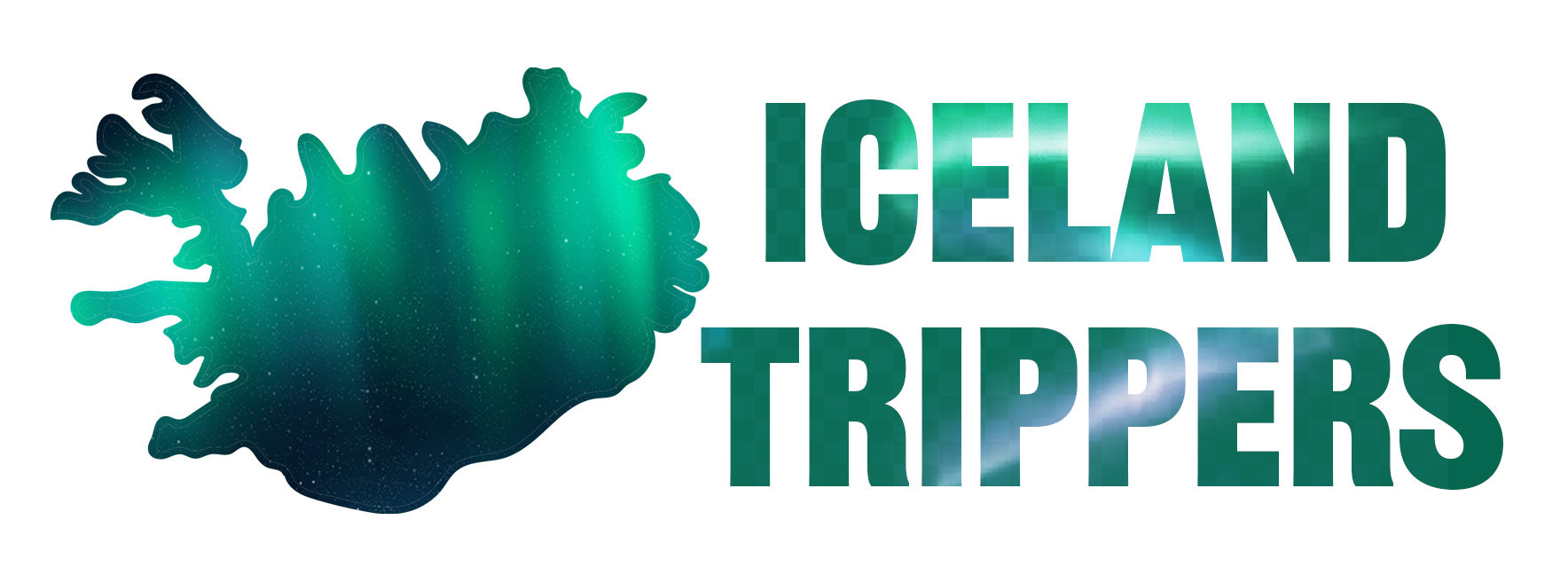
Learn how to easily plan your dream trip to Iceland with helpful guides and tips!
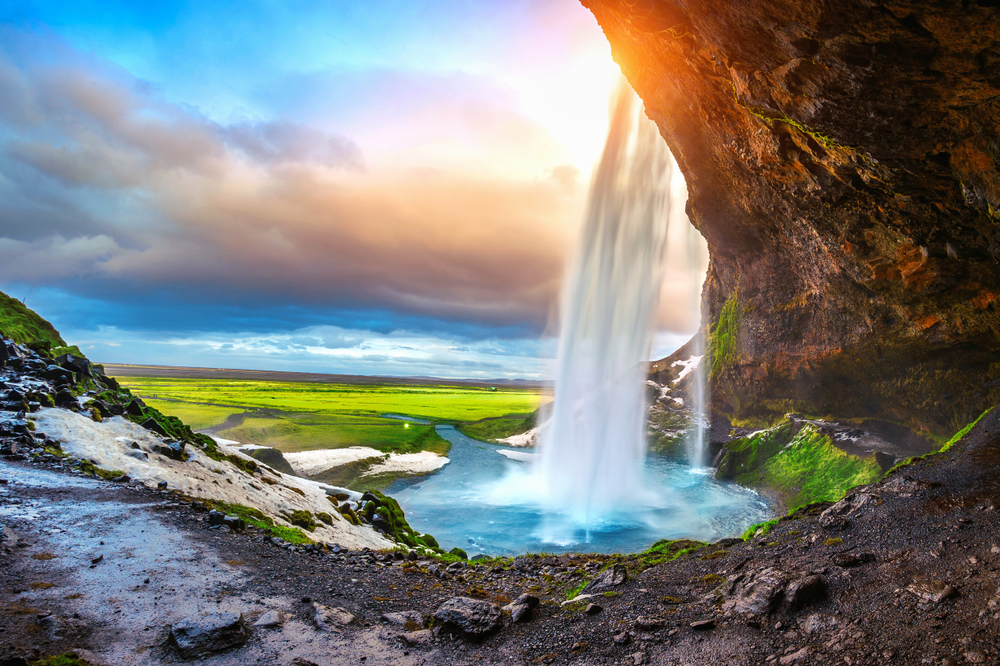

Best (And Worst) Time To Visit Iceland (Month By Month!)
February 19, 2022 // by Iceland Trippers // Leave a Comment
Deciding on the best time to visit Iceland for your needs is one of the most important parts of planning an Iceland trip. If you are unsure where to start, we have made it super easy for you by explaining what you can expect month by month.
This complete guide to the months and seasons of Iceland will fully prepare you for your trip. All of the most common questions are answered, such as when to see special things like the Northern Lights, lupine flowers, and puffins.
Planning your trip to Iceland last minute?
Make sure to book your hotels and tours in Iceland in advance to ensure availability! The longer you wait, the more difficult it gets. Here are my top picks for your trip :
Top Experiences And Tours In Iceland:
- Golden Circle Full Day Tour From Reykjavik (Likely to sell out!)
- Silfra Snorkeling Tour (Includes photos + only small group)
- South Of Iceland Full Day Trip (Our pick!)
- Whale Watching In Reykjavik (On a luxury yacht)
- Northern Lights Bus Tour (Great to go with a local)
- Ice Cave Tour And Glacier Hike (Likely to sell out)
Tickets You MUST book in advance:
- Keflavik > Reykjavik Bus Airport Transfer (Skip the line!)
- Sky Lagoon Entrance Ticket (Includes 7-step spa ritual)
- Blue Lagoon Entry Ticket With Drink (Likely to sell out!)
Top picks for places to stay in Iceland:
- Hotel South Coast (Great central location)
- Grandi Reykjavik (Includes free breakfast)
- Hotel Kria (Close to black sand beach)
- Hotel Skaftafell (Mid-range price)
Iceland is amazing , but it is also a country that must be taken seriously. Winter in Iceland is beautiful, but you must plan accordingly if that is when you are planning to visit. However, even summer has its drawbacks.
Not to worry, we have all the information you need to check off all of your Iceland dreams. The best months to visit Iceland might depend a little bit on the season, but it depends the most on you!
Get a FREE printable “Hidden Gems In Iceland” E-book by joining our private Iceland Facebook Group and sharing your photos and asking for tips and tricks.
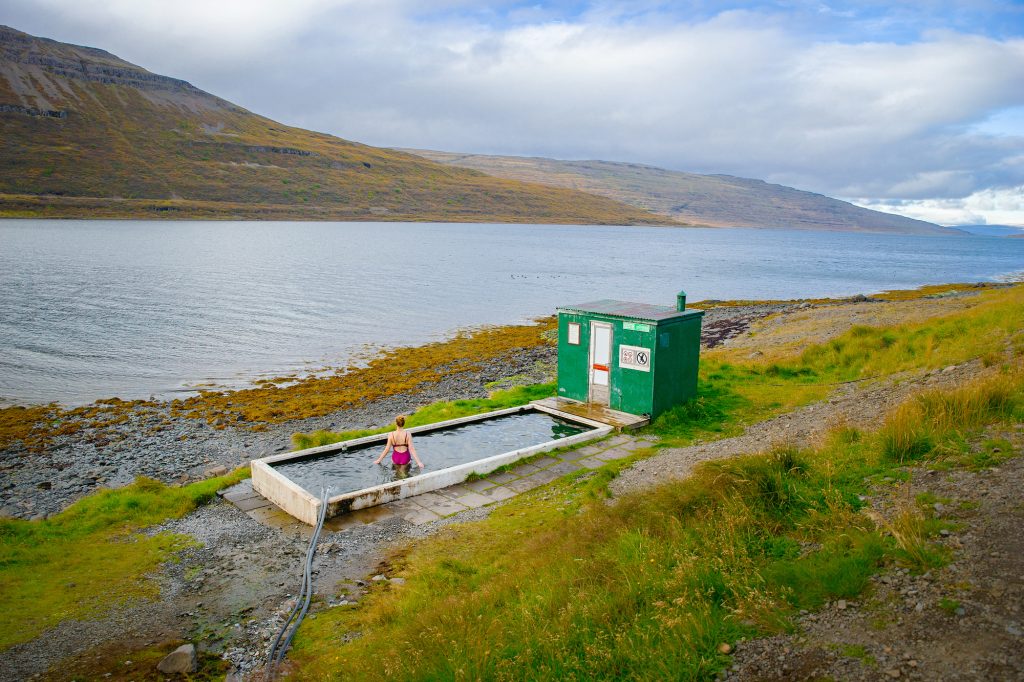
High and Low Seasons for Visiting Iceland
Like any popular tourist destination, Iceland has an “on” season and an “off” season. These times are otherwise referred to as high and low seasons (with the in-betweens being called shoulders).
The high season is when the majority of the tourists come to visit. This is generally due to the nice weather and ease of access. This is when most people plan their Iceland itinerary !
But just because the weather is colder in the low season does not mean you should not visit! Many people enjoy the low and shoulder seasons more because there are fewer crowds and it is cheaper, making it the best time to travel to Iceland for a lot of people.
You might be surprised to learn that there are indoor and outdoor activities for all of the seasons. Iceland is beautiful inside and out no matter when you visit.
High Season: June-August
Summer, summer, summer! This is the high season in Iceland for the obvious reasons: weather and temperature. It is undeniably the best weather to visit Iceland with much more sun and higher temperatures.
However, this is also by far the most expensive time to visit Iceland. Airfare, hotel fees, food prices–everything costs a pretty penny during the summer.
Not to mention the crowds. The high season is high season because it is when most people visit Iceland.
While the cost and the crowds are pretty big negatives, the high season has phenomenal positives as well. Especially if you are wanting to go to Iceland for the great outdoors. Most roads will be open during this time as well.
At the end of the day, it is all about your priorities. If weather and being able to spend the maximum time outside every day is your top priority, you are going to want to come to Iceland during the high season.

Shoulder Season: Sept-Oct & April-May
Shoulder seasons are the traveling industry’s best-kept secret. Okay, so it is not super-secret, but it still is not something people talk about as much as they should.
We hear about the high and low seasons all the time, but not so much about the shoulder seasons. They are the very beginning and the very ending of the classic tourism season.
This means that there are still more people than in the low season, but not the huge crowds of the high season. Prices are a little higher too, but still generally reasonable.
The best part of the shoulder season is that the weather is still reasonable. It may not be as great as the high season, but still totally tolerable!
Low Season: November-March
The low season in Iceland is during the typical winter months. For a country named after ice, Iceland’s winters are not that bad!
While there are some road closures, the country is still quite explorable and traversable during the cold months. And if you are coming to see the Northern Lights, this is the time to do it!
This is also the time to come if you are on a serious budget and need to take advantage of the low season prices. Traveling does not have to empty out your bank account.
The lack of crowds makes it the best season to visit Iceland on a budget! There are some trade-offs for coming during the off-season in Iceland, but there are some definite benefits too. This is actually our favorite time to go!
As we said above, the best time to visit Iceland depends on your Iceland priorities!
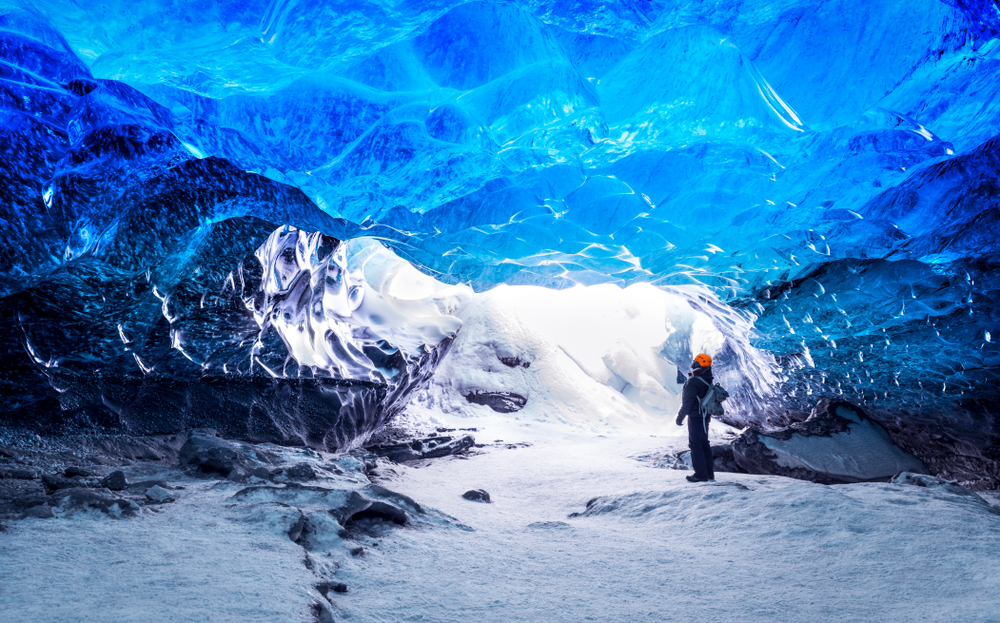
Visit Iceland in Summer if You:
-Love the idea of 24-hour sunshine. Ah, the midnight sun–you are not alone if this is on your bucket list ! If you have dreamt of Iceland’s 24-hour daylight, the summer might be the best time for you to visit.
-Are enamored with the brilliant green of summer. Iceland starts greening back up in the spring, but summer is the best time to visit Iceland if you want to see green everywhere.
The iconic lupine flowers bloom in June and July as well, creating swatches of purple across the landscape. If you want to photograph these flowers make sure to time your trip right.
-Want the best chance to spot whales. Whale watching is a popular tour in Iceland. The magnificent beasts can be spotted offshore from April through October, but the peak time to see them is in the summer.
In summer, more species are in the area and boat tours are less likely to get canceled because of weather.
-Plan on camping. Since the weather is calmer and less unpredictable during the summer, camping in Iceland is a better option for this season. You will have the least rainfall and less wind. This is especially good if you are tent camping.
-Are not bothered by crowds. Everyone loves the gorgeous, summer Iceland scenery. And we mean everyone . Iceland is a super crowded place in summer so keep that in mind.
If you hate crowds, you can still do alright coming in the summer. You will just want to visit the less popular places in the country. They may be less popular, but Iceland is amazing no matter where you go.
-Are totally invested in the traditional sense (read: financially). If you are not concerned about how much your trip to Iceland is going to cost, that saves you a lot of seasonal concerns.
Iceland is stunning in the summer, and we cannot blame you for wanting to visit when everything is so vibrant.
Just keep in mind that it is already expensive to travel to Iceland, let alone during the summer. During the high season, top tourist destinations and locations charge top dollar for everything.

Visit Iceland in Winter if You:
-Want to spot the Northern Lights. You can see the Northern Lights in the fall, but there is a caveat. You will have to stay up until around 2 am. If staying up all night is not your vibe, then winter is the best time to go to Iceland to see the Northern Lights!
In winter, there are not many daylight hours. The sun is only up from around 11 am to 3 pm. However, the increased darkness means a better chance of spotting the Northern Lights. Around midnight is the best time to spot them, but earlier or later is possible too.
-Want to visit an ice cave. The incredibly-formed ice caves are some of the best natural features in Iceland and can only be visited in the winter. Tours are lead from November to March.
-Love a good winter wonderland. There is just something magical about the way snow completely changes Iceland’s landscape. Many people absolutely love coming to Iceland during this time of year because of this.
If you love the beauty of winter, then it is the best time to visit Iceland! Keep in mind that snow has drawbacks since some roads will be closed.
-Want to stand out from the crowd. While a lot of people enjoy Iceland in the winter, the number of people who go is nothing compared to the summer.
If you are looking to do something a little different and unique, winter just might be the best time for your visit to Iceland. It certainly is not a bad time!

Visit Iceland in Fall if You:
-Do not like crowds but still want to see the Northern Lights. Even though this is the off-season, it is prime viewing time for the Northern Lights.
This is because the weather is so nice! You do not have to freeze to see the Northern Lights, just come during the fall.
An extra bonus is that there are really not very many tourists during this time. Fall is the best time of the year to visit Iceland if you want to miss the crowds and do not mind coming when it is a little colder.
-Love fall colors. Iceland is not a country that is typically praised for its fall foliage, mostly because there are not many trees. However, what trees there are turn golden along with the grasses, to create a beautiful landscape.
-Want to experience the Iceland Airwaves music festival. If you have not already heard about it then you might not know what a big deal the Iceland Airwaves music festival is. But if you have heard of it then you already know that it is a must-see!
It is a super popular music festival that happens each fall in Iceland. Usually, it is held sometime in November, but do an internet search to find the exact date.
If you love music, this festival is a great addition to your Iceland plans! Fall is the best time to go to Iceland to check it out!

Visit Iceland in Spring if You:
-Love puffins! Spring is the best time to visit Iceland if you want to see puffins . These adorable birds start arriving around April for their yearly nesting.
Puffins are some of the cutest birds out there, and you can find them all over! If you are coming to catch sight of or photograph them, just check in advance to make sure they will be in the area where you are going.
-Want to road trip without snow. As we said above, some of the roads can close in the winter. Spring is the best time to come to Iceland for better weather and open roads. That melting snow also helps to make the waterfalls flow stronger.
Not to mention that the world is coming back to life in the most beautiful way! There is something about the colorful bursts of color against the gray of winter that makes spring like no other season.
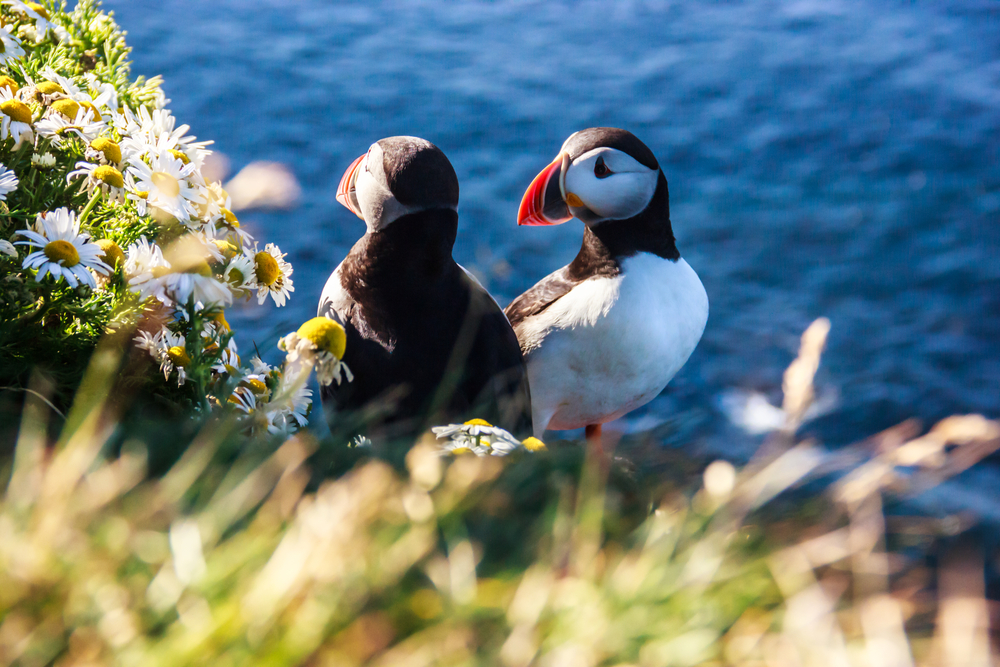
Best Time to See Northern Lights in Iceland
If you are interested in the Northern Lights, you are interested in Iceland! While there are many different places to see the Northern Lights in the world, Iceland is hard to beat.
Especially considering that there are places where you can watch them from a hot tub! The Northern Lights In Iceland are a huge draw, and if they are the reason you are coming you are not alone!
If you are wondering what is the best month to see the Northern Lights in Iceland, there are a few choices. It is possible to see the Northern Lights any month between the end of September and the end of March.
Just like the sun is out all night during summer, the nights are very long in the winter. The closer to mid-winter you visit, the longer the night and thus the higher chance of seeing the lights.
You definitely will not be able to see them during the summer! Winter is when you should book your Iceland trip if the Northern Lights are a priority.
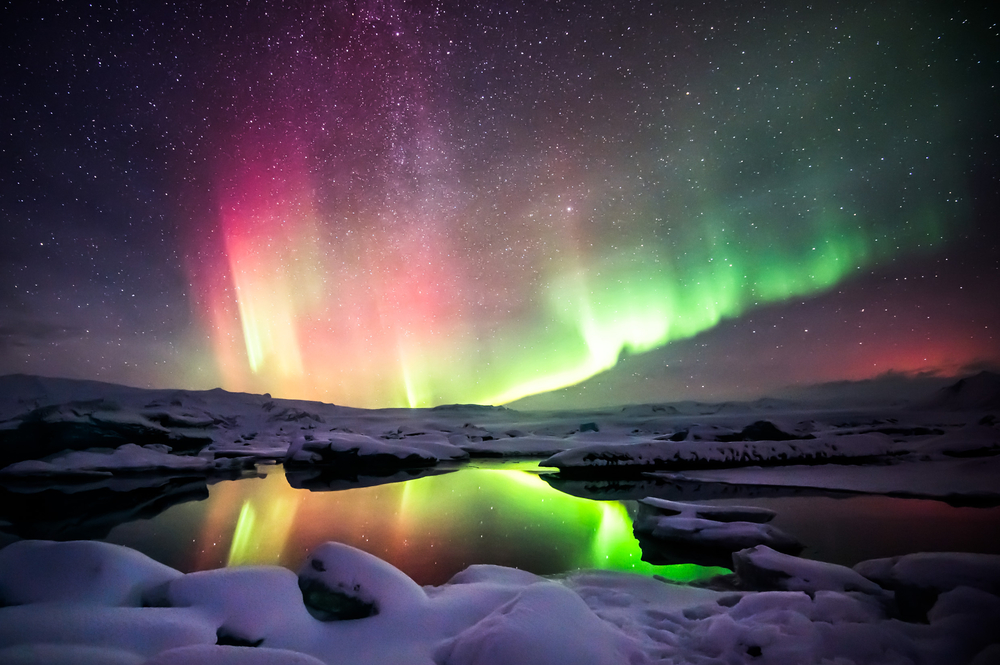
Cheapest Time to Visit Iceland
Unfortunately, Iceland is one of the more expensive countries to visit. We have gone over and over because we believe the experience is worth the money .
However, there are things you can do to make your trip much less expensive. One of those things is visiting during the Iceland off-season.
If it is your goal to do Iceland without dumping a ton of cash, we absolutely recommend the shoulder seasons or winter. Visiting right before or right after the high season of summer can save you a lot of money.
If saving money is a high priority, winter is absolutely the best time to visit Iceland. And pro tip: use grocery stores to cut down on costs even more!
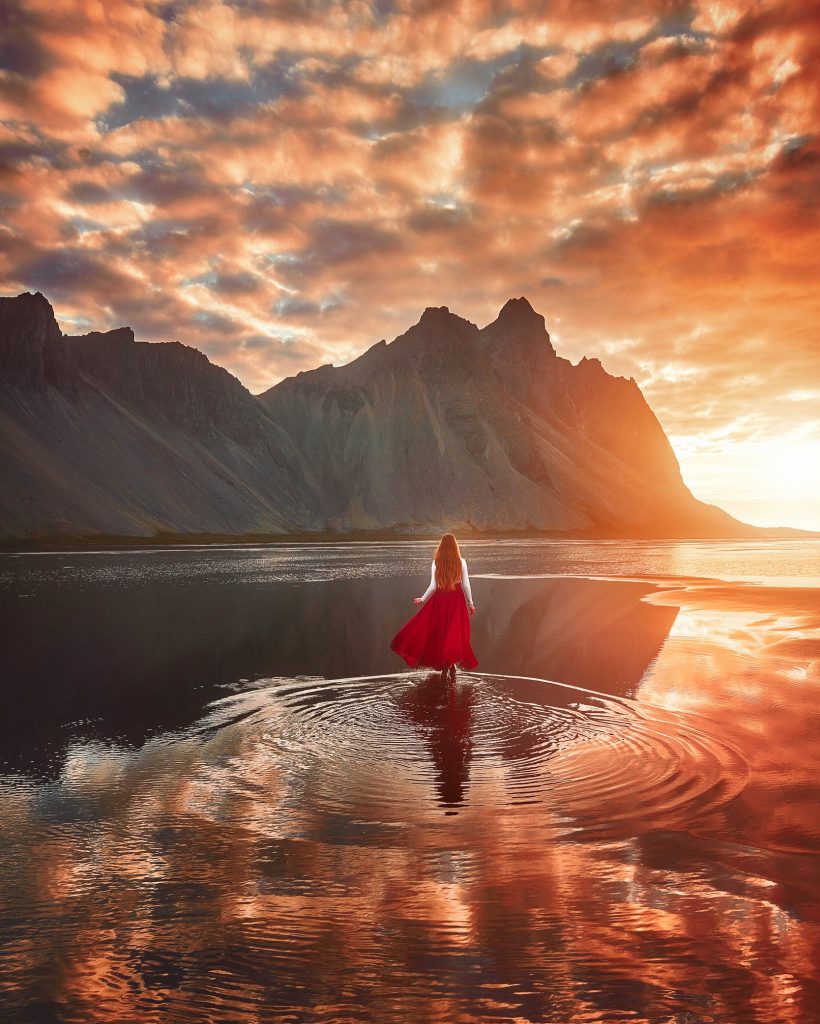
Iceland Weather Breakdown by Month
So far we have been referring to entire seasons, but we know that is kind of broad. Especially when you are planning the trip of a lifetime!
That is why we are going to break everything about Iceland Weather down month by month . This way you can know exactly what to expect.
After all, sometimes the best time to visit Iceland is simply when it best fits into your life. Whenever you make the trip, our month-by-month breakdown will help you make the most of it.
Iceland Weather in January
Happy New Year! January is a great time to visit Iceland. During this time of year you will find highs of about 36 ° F and lows of about 27 ° F.
Is that warmer than you expected? For a country named after ice, Iceland’s winters are actually quite moderate when compared with a lot of other places in the world!
That being said, January in Iceland is the coldest and windiest month. You will want to bring warm clothing and dress appropriately! Expect lots of snow and ice.
Iceland Weather in February
Honestly, the temperatures do not change much in February. What does change is the hours of daylight!
At the beginning of January, you will only get about 4 hours of daylight a day. By the end of February, this increases to about 10 hours.
February is a great month to come because there is more daylight but the crowds and costs are still at a minimum. Check out our post on things to know before you visit Iceland in February!

Iceland Weather in March
March continues with the increase in daylight hours, with about 13 hours of sunshine a day by the end of the month.
Winter weather continues in Iceland in March , although it starts sticking more to the mountaintops and less to the streets. As with most places, the weather is also better in southern Iceland than in northern Iceland.
However, it is still cold pretty much everywhere. We are getting closer to spring, but you would not really know it yet. The temperatures are still averaging between 27 ° F and 36 ° F.
Iceland Weather in April
The weather finally begins to make a bit of a change in April. Temperatures range between 32 ° F and 41 ° F during this warmer month.
What is more, there is a lot less snow! Spring starts to show its face about this time, with the country beginning to green back up again. Migratory birds start to return, including puffins.
We are also looking at around 17 hours of daylight in April as we officially move out of the low season and into the shoulder season. Don’t forget to check out this post about visiting Iceland in April!
Iceland Weather in May
May is seriously one of the best times to visit Iceland! Especially if you love the sun! The days have 20 hours or more of sunlight. It is also the driest month, with the least rainfall.
The highs are also much closer to 50 ° F, which means you almost do not even need a jacket depending on where you are from.
Of course, you will still want to bring your jackets . While the weather is much more temperate, there will still be some cold days. However, it is totally livable and the country is also becoming so much more green!
Iceland in May is also still shoulder season, which means you will not have to try so hard to find your own space while enjoying the sunshine.
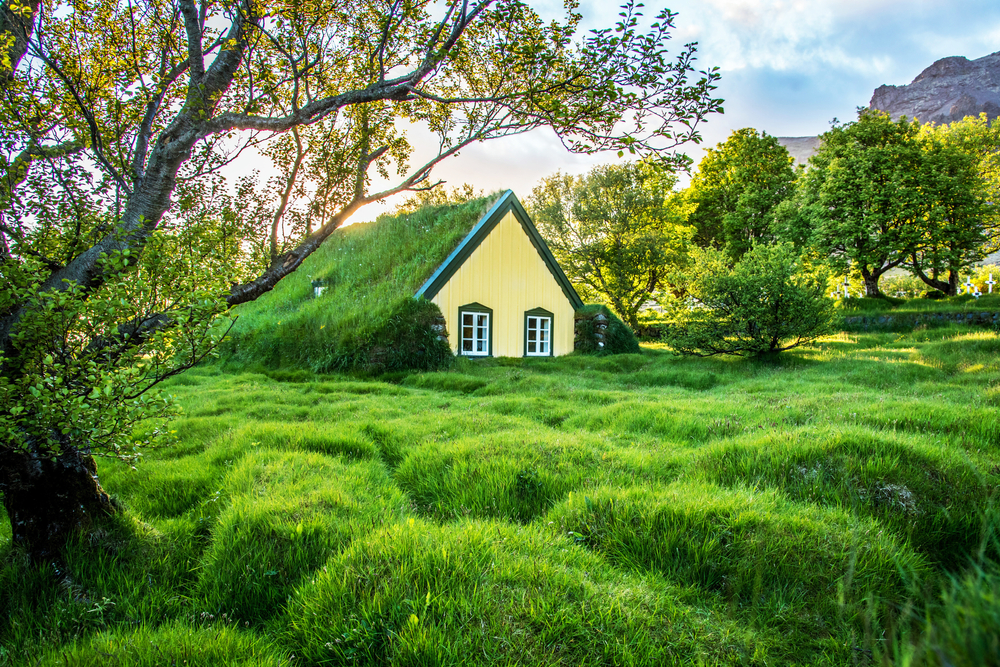
Iceland Weather in June
Welcome to high season! While it is called the high season because it is most popular among tourists, June in Iceland is also the high season for the longest days.
If getting the most out of each day is important to you, then June is the best month to visit Iceland. You can explore for many more hours in daylight.
June nights only last for about 3 hours, beginning around 11:30 PM! Yeah, blackout curtains are a big thing in Iceland summers!
While the highs average around 52 ° F, they can get much higher than that. June is the beginning of summer, and also the beginning of real warmth.
Iceland Weather in July
Now, if you are interested in heat rather than warmth , July might be a better time to visit Iceland. It is the best time of year to visit Iceland for heat, as the hottest month of the year. It is also the least windy month.
The weather in Iceland in July is generally extremely pleasant during this time of the year. While the nights are a little longer, at about 4 hours long, they do not increase by much!
Keep in mind that “hot” does not mean the same thing in Iceland as it does in other places. The average highs are around 56°F. That is part of why it is one of the most popular times to visit because it does not get any warmer than this.
Iceland Weather in August
August is the last month of the high season. While the beginning of the month is still as warm as July, temperatures start to go down by the end of the month.
August is the best time to go to Iceland if you do not mind the crowds due to the fairly standard daylight hours. The sun sets around 9 PM and rises around 5 AM. August has the least cloudy days as well.
Do keep in mind that August in Iceland goes quickly from summer to fall. By the end of the month, the slight bite to the air will have you wishing for warm pumpkin pie and spiced apple cider.
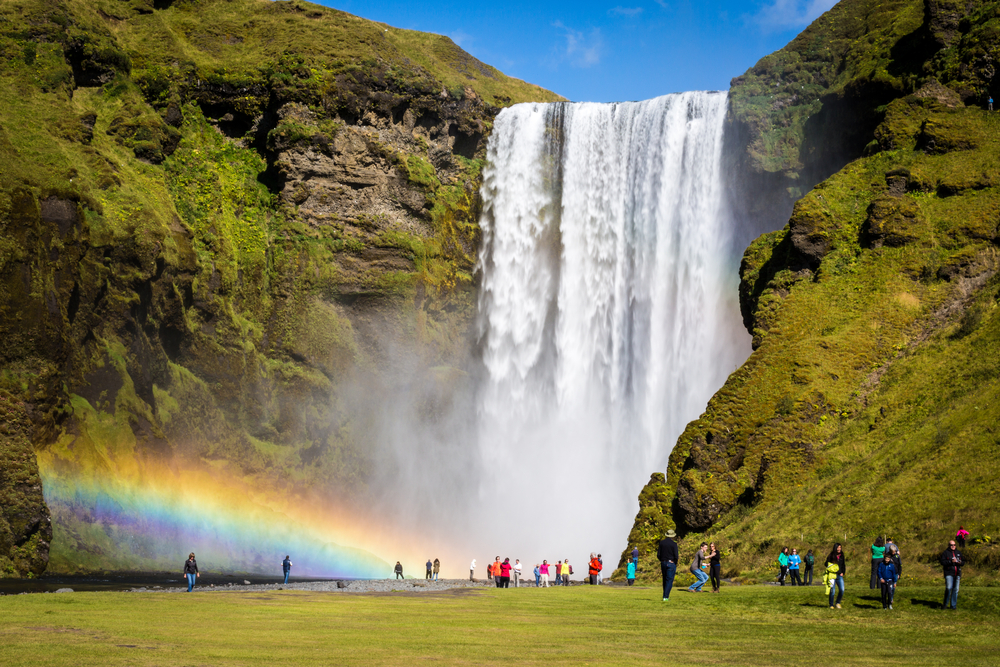
Iceland Weather in September
September still has great sunshine for Iceland, but it does go down to just below 12 hours by the end of the month. It is the warmest month with a chance to see the Northern Lights.
Temperatures are still quite nice, and we are back in shoulder season. This means that you can enjoy the nice weather and decent daylight hours without all the crowds of summer.
By the end of the month the likelihood of snow increases. If you visit Iceland in September , you will want to pack your warm clothing!
Iceland Weather in October
October in Iceland is still technically part of the shoulder season, but it is starting to feel much more like the low season of winter. Daylight is down to about 8 hours a day.
In addition, the average temperature is dropping back down to about 41 ° F. While it is not absolute winter yet, the weather should be taken into consideration at this point.
Bring warm clothes and waterproof ponchos. October is the wettest month in Iceland with an average of 14 days with precipitation.
Although it is colder, October is the best time to visit Iceland if you want to explore with as few crowds as possible. The roads are still open and you can still go pretty much everywhere you want.
Iceland Weather in November
Welcome to winter and the off-season in Iceland. November begins the coldest time of the year, although December and January are colder. This is when the snow starts to fully cover the island.
The average temperature is 38 ° F, but it can get much colder. Daylight only lasts about six hours.
We love to visit Iceland in the low season, and really do think it is one of the best times to visit Iceland. You just have to be prepared for the lower temperatures and the weather.
Iceland Weather in December
The last month of the year is one of the coldest months, second only to January. Temperature highs only reach about 39 ° F. It gets as cold as 21 ° F.
In addition, Iceland in December sees quite a lot of precipitation and snow. Daylight hours are generally pretty short.
However, this does make it and January the best time to visit Iceland for the Northern Lights! However, it is also the cloudiest month, meaning the lights can get obstructed.
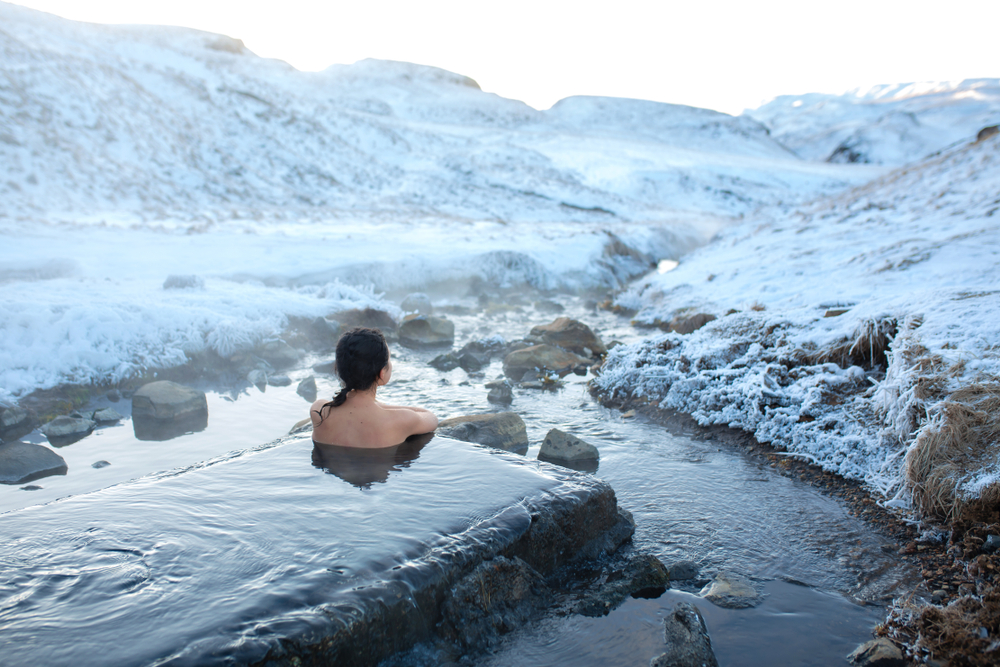
Iceland Events and Activities by Month
While the weather is a big deal, sometimes it is not as important as what you can do. After all, most weather is survivable if you plan and dress accordingly.
If you are more curious about what is going on than what temperature it will be, we have you covered! We have broken down the events and activities you can do during each month of the year.
You might be surprised by some of your options, especially during the winter!
Iceland in January
Can you even go wrong with New Year’s Eve when you are celebrating in a different country? Especially Iceland!
The country takes this holiday seriously with partying on New Year’s Eve, sleeping on the first, and shopping on the second.
And then there is Christmas–that is right, Christmas extends into January in Iceland, with the last day being on the 6th. If Christmas is your favorite holiday, then the end of December and the beginning of January is definitely the best time to visit Iceland.
Another great January tradition in Iceland is Thorrablot . This pagan celebration was canceled when Iceland went Christian but has had a resurgence in the last couple of centuries.
It is a week-long celebration of an Icelandic tradition that will not disappoint. If you want to feel like a local, prepare yourself for some things you have never eaten before, like rotten shark meat, boiled sheep’s head, and congealed sheep’s blood.
Iceland in February
February is beloved for the Winter Lights Festival . As a celebration of bright and happy things, you will love the way they light the streets with brilliant fluorescence to chase the darkness of winter away.
Öskudagur is basically Icelandic Halloween. The kids dress up in great costumes, and instead of the “trick or treat” chant, sing for their candy.
The Icelandic Food and Fun Festival is a fantastic festival that celebrates Icelandic cooking. And not even the kind that uses blood and rotten shark meat! It is all about using ingredients native to Iceland and enjoying all the culinary joys the country has to offer.

Iceland in March
Did you know that Iceland had its own prohibition period? Beer with an alcohol level of over 2.2% was banned for the majority of the 1900s but legalized again in 1990.
Iceland celebrates this legalization with the unofficial holiday, Beer Day, on the first of March every year! We think you can probably guess what the main activities are. (Drinking beer.)
DesignMarch is similar to the Food and Fun Festival in that it is a celebration of Icelandic creativity. The event features purely Icelandic products and goods.
Continuing in a similar fashion, the Reykjavik Folk Festival honors centuries of traditional music and song.
Iceland in April
Iceland celebrates Easter for days just like Christmas. Honestly, we do not know why more countries do not do holidays like this! Celebrating with just one day is so minimal!
Easter lasts from Holy Thursday to Easter Monday in Iceland. It is generally spent with family, rather than with huge parties.
April’s other holiday is the first day of summer. Given the dark of winter and the light of summer, and the very small in-betweens, Iceland actually does not traditionally recognize spring and autumn as seasons. So summer starts in April!

Iceland in May
The Reykjavik Art Festival is a big deal in May! People come from all over the world to participate in and experience creativity and fun.
If art is not your thing, May still might be the best time to visit Iceland with the Rite of Spring Festival. We know, we know, we just told you there is no spring in Iceland.
But when Iceland gave up its traditional calendar, they adopted spring and autumn into their new calendar. And they like to welcome spring with heartfelt jazz and folk music!
Iceland in June
It should come as no surprise that a country that willingly eats rotten shark meat celebrates the sea! Iceland’s Festival of the Sea happens in June, and it honors the country’s long tradition of seafaring.
Iceland also celebrates its independence from Denmark every June 17th. Like the 4th of July in the United States, Iceland National Day is a country-wide affair filled with parades, concerts, and general enjoyment of Icelandic culture.
Summer Solstice takes advantage of the Midnight Sun with all-night rock concerts. You can also join the locals in watching the sun set and rise all within the course of 2-3 hours.
Another unique Iceland festival is the International Viking Festival . It is a days-long holiday event that pays tribute to Iceland’s fierce Viking history.
Iceland in July
Innipukinn Festival is another music festival that happens in July. If you are not already getting the sense that you can hit up a music festival basically anytime you visit Iceland, well, you can. Icelandic people really love their music, okay?
They mix things up a bit with LungA , a festival specific to the Icelandic town of Seyðisfjörður . This festival still has music (as any good festival does) as well as art!

Iceland in August
Verslunarmannahelgi–say that five times fast, we dare you! Honestly, if you can pronounce it once we will be impressed. Verslunarmannahelgi happens the first weekend of August and is a quick bank holiday (kind of like Labor Day in the US). People generally celebrate by going camping.
Gay Pride comes the second weekend of August, and nowhere celebrates it as Reykjavik does! With parades, parties, and concerts, this is truly a vibrant and fantastic event.
If you like running, (like, really like) then the third weekend of August is the best time to visit Iceland! This is when the Reykjavik Marathon occurs, and it is another event that attracts people from all over the world!
The marathon wraps up with Menningarnott , a fantastic cultural celebration with cultural events, fireworks, and you guessed it, great music!
Iceland in September
The capital city of Reykjavik has two festivals in September, making it the best time to visit Reykjavik if you are wanting to have some fun during the shoulder season.
First is the Reykjavik International Literary Festival . This one is not just a big deal to Iceland, it is actually the biggest literary festival in Northern Europe!
Next is the Reykjavik International Film Festival . There is just something about literature and film that make them go hand in hand. Both of these festivals draw people from all over the world, but especially the film festival!
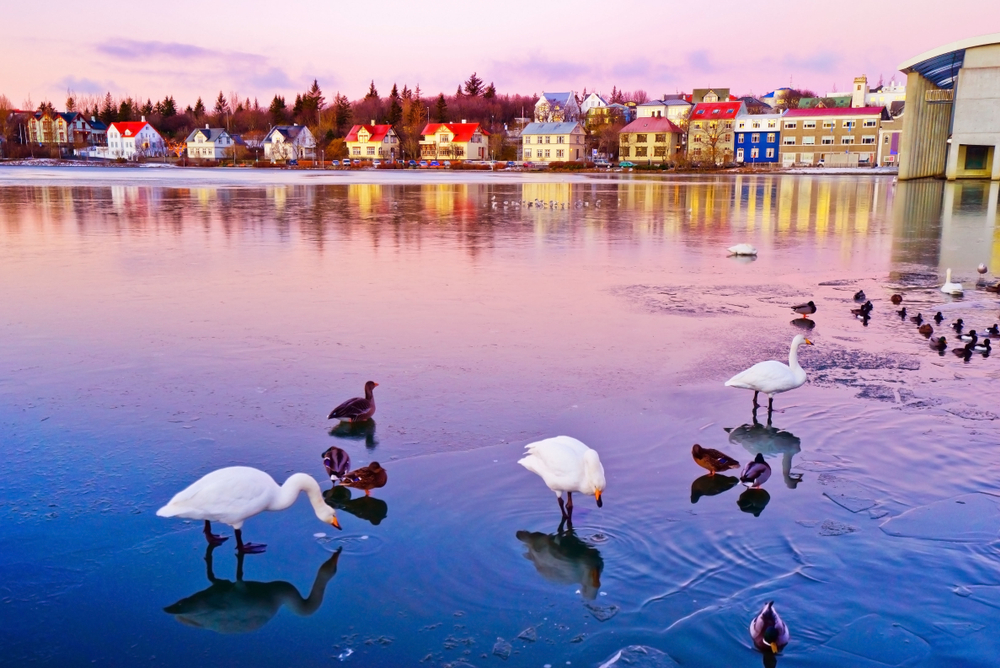
Iceland in October
Iceland Airwaves is another music festival but centers on indie and alternative music rather than the traditional folk and rock music of so many other festivals. Of course, folk and rock music still abound!
Iceland also celebrates Halloween in October, although they have not been celebrating it as long as other countries and do it a little differently. It is more of an adult holiday, but still features costumes!
Iceland in November
November does not have a whole lot going on in the realm of festivals and events. What it does have, though, it makes sure to do well.
Frostbiter is Iceland’s Horror Film Festival. So while Iceland does not have much going on in November, it is still the best time to visit Iceland if you love horror!
Iceland in December
Sorry not sorry, but Iceland has the best Christmas lights. Seriously, you have to check them out! Because the country is so dark all the time in December, they go all out with the Christmas lights.
And the way they make such a contrast against the dark? Unbeatable.
Everything about Iceland Christmas is simply unbeatable. From the concerts to the food to the country’s own unique and fun traditions, you will absolutely love it.
New Year’s Eve is filled with fireworks, bonfires, and singing. There are even costumes!
And they do not wrap things up and go to bed at midnight. Iceland New Year partying lasts long into the early hours of the next day.
December is the best time of year to travel to Iceland if you love all the December holidays!
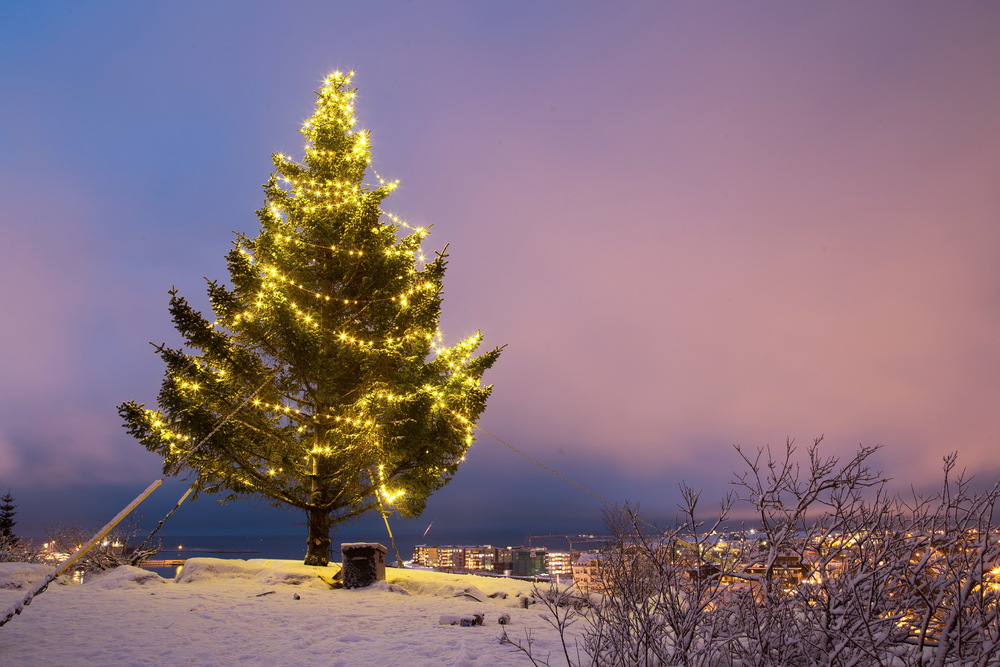
When is the Worst Time to Visit Iceland?
Honestly, there is really no bad time of year to visit Iceland as long as you plan accordingly. After reading this article, you should have a good idea of what each month has to offer in terms of weather, natural events, and festivals.
As long as you visit when you want to and pack according to the season , you will be in Iceland at the right time.
If you want to see the Northern Lights, summer is the worst time to visit Iceland. But, if you want clear roads for your rental car and warm weather, then winter is the worst time to visit.
So, When is the Best Time to Visit Iceland?
At the end of the day, the best time to visit Iceland is 100% up to you! Whatever your interests are and your budget will determine when you should visit this amazing country.
After all, this is your trip to Iceland. Plan it around what you want to see and do.
Do you want the midnight sun and purple, lupine flowers? Come during summer. Hate crowds and overpaying, but want decent weather? Give shoulder season a try. Does your Iceland bucket list involve the Nothern Lights or ice caves? Winter is your best bet!
Iceland is gorgeous year-round, and you really cannot go wrong no matter when you visit!

We hope our guide to the best time to visit Iceland has been helpful! Feel free to let us know when you decide to go in the comments below. What is your favorite time to travel to Iceland?

Reader Interactions
Leave a reply cancel reply.
Your email address will not be published. Required fields are marked *
Save my name, email, and website in this browser for the next time I comment.
- Skip to main content
- Skip to secondary menu
- Skip to footer
ZigZagonEarth
Plan unforgettable road trips!
Best time to visit Iceland in 2023 (northern lights, wildlife, roads…)
Last updated on November 1, 2023 by Claire Robinson - this article contains affiliate links. If you purchase through them, I get a small commission ( more )
When is the best time to visit Iceland? The truth is: anytime of the year. However, you may be interested in specific sights, so below are more specific answers:
- best time to visit Iceland for northern lights,
- Best time to see puffins, whales, lupin flowers in Iceland,
- best months to visit Iceland based on driving conditions and crowds.
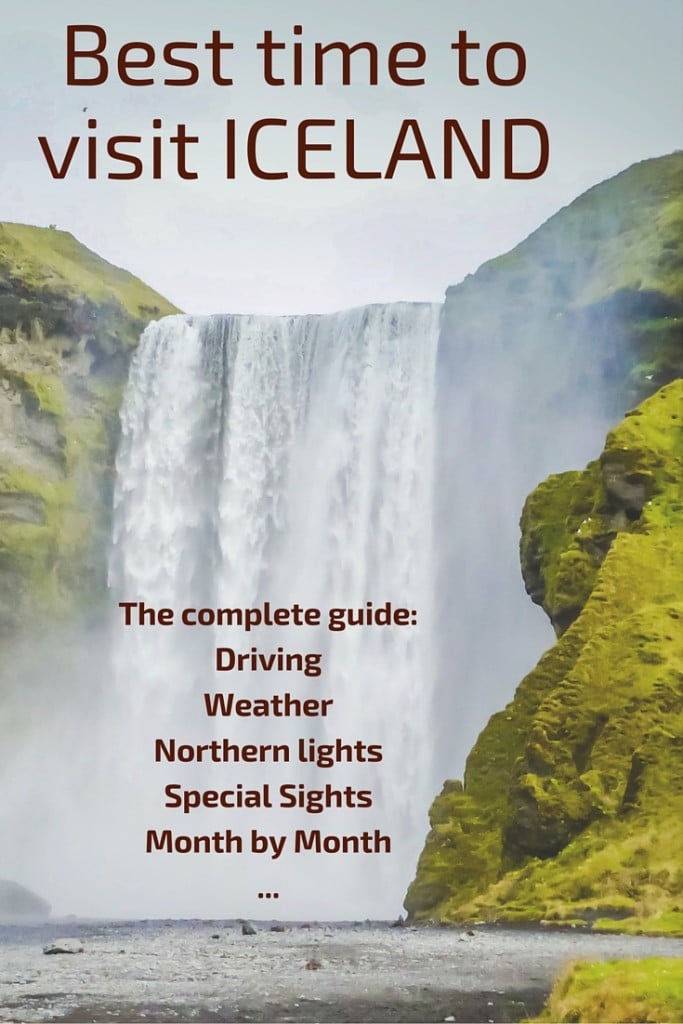
OVERALL – When is the best time to visit Iceland in 2023?
Visual overview – every year.
It really depends on what you want to see. The article below, gives you explanations about where and how to see all those special sights, but here is an overview picture to help you identify the best time for you to visit Iceland:
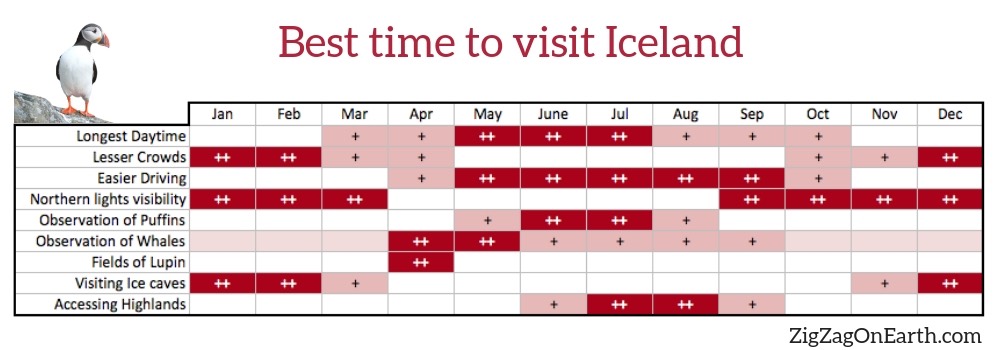
Best month to visit Iceland in Summer
I think Beginning of September is the absolute best time to visit Iceland because:
- Roads are in good condition
- The day is long enough to be able to see many Iceland Attractions
- There is enough nighttime to have a chance to see the Northern Lights
- There are less tourists than in Summer, but accommodations are still open
- The Central Highlands roads are normally still open
It is my opinion that it is the best time to see Iceland generally, but it does not take into account your wishes for special sights. So, let’s have a look in more details.

My favorites to plan your Summer Iceland trip:

My favorite platform to rent a car in Iceland: Discovercars

My favorite places to stay around Iceland:
- Reykjavik , the capital, of course: Reykjavik Konsulat Hotel
- Vik to explore the South Coast: Hotel Vik i Myrdal
- Lake Myvatn, in the north: Hotel Laxa
- Borgarnes , between Snaefellsnes and Silver Circle: Hotel Hamar

My favorite bus tour from Reykjavik (Summer): Amazing Snaefellsnes Peninsula

My favorite activity around Iceland (Summer): Whale watching from Husavik (best) or Reykjavik or Akureyri

My favorite platform to book travel-packages in Iceland: guidetoiceland
Best month to visit Iceland in Winter
I think the end of February is the absolute best time to visit Iceland in Winter because:
- The natural ice caves are still accessible

Before my tips + photos, here are my favorites to plan your Winter Iceland trip:
- Vik to explore the South Coast: Hotel Vik i Myrdal
- Lake Myvatn, in the north: Hotel Laxa
- Borgarnes , between Snaefellsnes and Silver Circle: Hotel Hamar
My favorite bus tour from Reykjavik (Winter): Chasing Northern Lights even without guarantee of seeing them

My favorite activities around Iceland: Visiting an ice-cave and Walking on a glacier
Specifics for 2023
Things to consider if planning a trip to Iceland in 2023 (in theory, but check the latest decisions for large gathering due to the virus):
- 3rd to 6th February – Reykjavik Winter Lights Festival
- Late March – Iceland Winter Games (maybe)
- June – Reykjavik Arts Festival
- June 17 – Icelandic National Day
- 8nd to 13th August – Reykjavik Pride
- December – Christmas villages
- Mid-December – Yule Lads Baths in Myvatn
You can see the complete list of festivals and events here
Best time to visit Iceland for Photography
There is no answer to that. There are great opportunities all year long with midnight sun in June, auroras in Winter… I would just recommend avoiding July and August as those are the most crowded months without something extra specific to photograph.

Conditions – Best times of the year to visit Iceland (weather, daytime, crowds…)
Length of the days.
Because of its Northern Latitude, sunrise and sunset times in Iceland vary greatly. So depending on when you visit the country, you might be limited in terms of light and can see more or less locations during the day.

Below is the amount of daylight to expect for different periods of the year
- March – 10 to 13 hours of daylight
- April & May – 13 to 20 hours of daylight
- June – 20 to 24 hours of daylight
- July & August – 15 to 20 hours of daylight
- September & October – 8 to 14 hours of daylight
- November to February – 4h30 to 8 hours of daylight
It is also important to consider how long nighttime is to see the Northern lights (more on that later).
WEATHER – Best time to travel to Iceland
I don’t recommend using weather as your first criteria for the best time to visit Iceland as it is very unpredictable. In the same day you can see the blue sky, get rain, experience strong windy moments and even get snow!
You don’t come to Iceland for the weather. Any conditions will render the landscapes magical. Just have a look at Jokulsarlon below:

You should just know that it can be cold in Summer and it is actually not as cold as we imagine in Winter. For example:
- Average temperatures in January are between -3°C and 2°C (not the -20 we were all imagining…)
- Average Iceland Summer temperatures : 8 to 15°C
Check out my complete article with detailed suggestions and tips on what to wear and pack for Iceland
How to avoid the crowds in Iceland
Of course, the Summer months are the more crowded. Actually the land is so vast that you don’t feel it when driving. You feel the crowds at each of the famous locations e.g. Golden Circle, Jokulsarlon, Seljalandsfoss.
- Therefore, I recommend traveling in April/May or September/October
- If you really want to travel in Summer, then you either go very early to avoid the crowds (lots of daylight hours) or you go to less visited areas such as the Westfjords.
Planning – Best time to go to Iceland
Driving conditions.
Driving might be one of the most important things to consider when deciding the best time for you to visit Iceland:
- The F roads to the magnificent Central Highlands are open only from Mid-June to September (depending on conditions)
- Apart from Road 1, ice and snow will be your driving partners from November to March
Check out my articles about Driving in Iceland in Summer and Driving in Iceland in Winter with videos.

Need to rent a car in Iceland?
- Compare prices on my favorite platform: Discovercars.com – one of the best rated comparison sites!
- Prefer a compact car for the narrow streets in villages
- Consider their full coverage option – it for peace of mind!
- Book early to have a large choice of vehicles!
See all my tips

Accommodations
There are more and more accommodations in Iceland so it might change. But keep in mind (at least for a couple of years):
- In Summer there are many tourists and accommodations are full very quickly
- In Winter, there are not many open accommodations, so they also get booked quickly
- The shoulder months of May and September are maybe the easier time to find accommodation in Iceland
In any case, if you plan on visiting remote locations in Iceland, you should book your hotels or guesthouses in advance. Check out my Iceland Accommodations article for general information and 12 suggestions with personal reviews.
Planning a road trip – things to see
It is possible to go on a road trip both in Summer and in Winter. However, in Winter, many points of interest are not accessible. The places that can be visited in both Summer and Winter offer magical experiences all year round. Below you can compare the waterfall of Skogafoss in both seasons. You can see more example on my Summer vs Winter article .

To plan your itinerary, you can check out:
- My general post about planning an Iceland road trip
- My suggested itineraries for 5 days in Iceland
- My suggested for 7 days in Iceland itineraries
- My 4 itineraries to spend 10 days in Iceland
- And my favorite itinerary for 14 days around Iceland
- or get one of my practical eBooks to help you plan your ideal itinerary:
Plan your dream trip to Iceland with my guides!
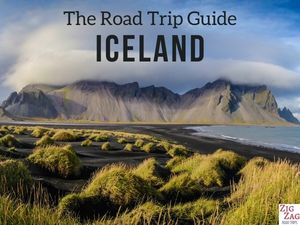
- 8 easy-to-plan maps
- 100+ pre-selected locations
- GPS coordinates
- Useful planning tips
- 130+ large photos
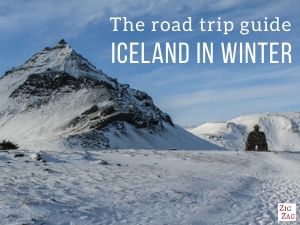
- 6 easy-to-plan maps
- 75+ pre-selected locations
- 115+ large photos
Best time to visit Iceland for NORTHERN LIGHTS
The northern lights, also called aurora borealis, are lights (often green) which seem to dance in the sky. To be able to see them, you need a dark night and a clear sky. So, when is the best time to visit Iceland for Northern lights?

Best time to go to Iceland for Northern lights
The best months to see the Northern Lights are from late September to March , when there is enough nighttime to be able to see them. There is nothing specific per year.
Best month to see northern lights in Iceland – can viewing be guaranteed?
No, there are no guarantees. There is no one month that you can pick and when you are sure you will be able to see the auroras. It depends on the solar activity and the cloud coverage. When the sky is all cloudy, you will see nothing at all.
Try not to plan your trip during the full moon. The darker the night the better.
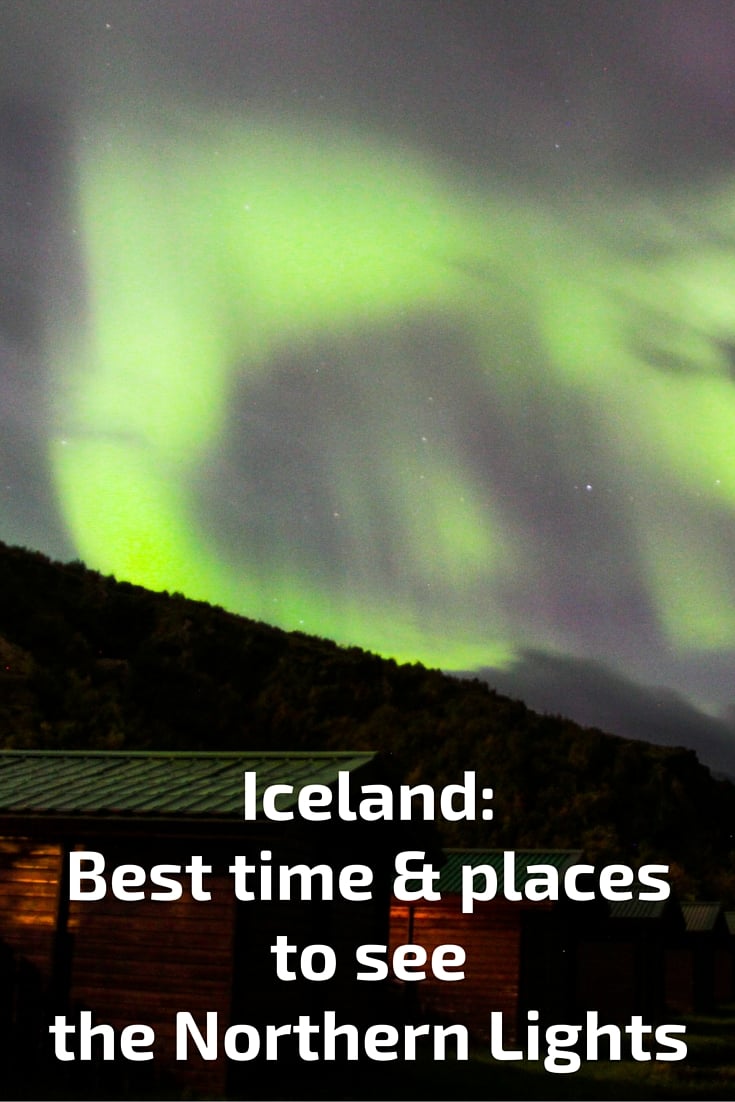
Best places
- In remote locations away from any light source
- North Iceland is considered to be better as you have more clear nights
- Facing North is also recommended. Although not a rule – so for example, Kirkjufell is a great location
Practical Guide – Interested in hunting and capturing the Aurora Borealis? Learn more on how to see the northern lights in Iceland with tools to use, how to get ready, tips to photograph the Northern Lights…

Northern Lights excursions
If you don’t want to chase them yourself, you should consider organised tours in the evening. There are different options, for example from Reykjavik:
- BUS TOUR – One of the cheapest options is to go on a bus tour. You leave from Reykjavik and the driver takes you to the best spots he knows depending on the forecast – Check out Program, availability and Price
- SMALL GROUP TOUR – This is my favorite option, it is easier to go from one spot to another chasing the Northern Lights because you can gather everyone more quickly and you can go off the beaten tracks – Check out Program, availability and Price
- NORTHERN LIGHTS CRUISE – A more original option is to go on a boat off the coast of Reykjavik to find the dark and hopefully see the Northern Lights – Check out options
- A Cruise option is also available from Akureyri in the North – Check out Program, availability and Price
Best time to see WHALES in Iceland
Iceland is a great place to observe whales, as they enjoy the cold waters and abundant feeding grounds. Species visiting the island include the orca, minke, humpback and blue whale.
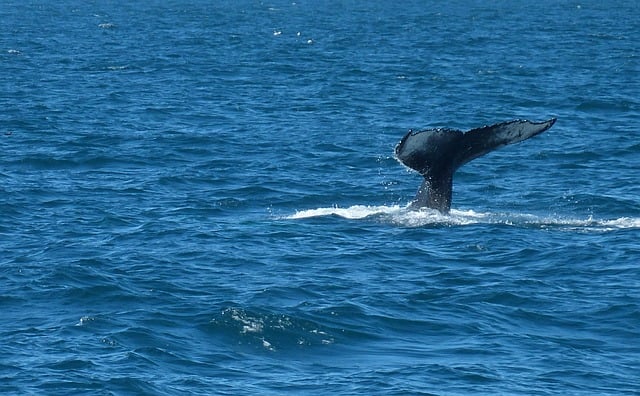
Whale watching Iceland – best time of the year:
- Whales can be seen around Iceland all year
- However, more sightings are reported between April and September
- Killer whales are mostly spotted in April and May
Best places
Whale watching Boat tours depart mostly from Reykjavik (South West) and Akureyri or Husavik (in the North). The North is considered a better whale watching spot.
Whale excursions options
- Whale watching cruise from Reykjavik, on a boat with heated cabin – Check out program and Book
- Whale watching experience from Reykjavik on a Boat – Check out program and Book
- 3 hours Whale watching boat trip from Akureyri in the North – Check out program and Book
- Or leave from the Traditional fishing town of Husavik – Check out program and Book
I don’t drink coffee
But I also like other drinks and sweets! Do you like the free content you find on my blog? All my tips and practical information, without intrusive advertising…

Best time to see PUFFINS in Iceland (and places)
The puffin is a strange looking bird with a black back, white underparts, and a distinctive colorful beak.

Best time to see Puffins in Iceland
- Puffins come to the coast to nest from May to Mid-August, which is the Iceland puffins’ season
- From mid-June to mid-July, the parents fly back and forth from the sea to the nests with food, so it is a great time to observe them
Best places to see them
Iceland is the perfect place to see puffins. Actually it is the best place in the World, because it home to the majority of the world’s population. Love this fun fact? Find out more in this list of 25 fun facts about Iceland .
There are good places to see puffins in both South and North Iceland. However it is way easier to admire them from a boat. Iceland Mag has a great article and a map with prime locations to observe the puffins in their natural environment.
Puffin Excursions
As I said, they are easier to observe by boat. There are specialized excursions departing from Reykjavik – Check out this tour with great reviews
Best time to see ICE CAVES in Iceland
Ice caves are cavities that form naturally in a glacier and create strange formations.

November to March. Outside of this period the cave can collapse
Around glaciers… You should not go visit them by yourself. Always go with an experienced guide. Organized tours are available and should be booked in advance
Some might notice a cave in Langjokull toured in summer. This is not an ice cave but a man-made tunnel in the ice.
Most beautiful
Know that caves disappear every year. New ones are formed, sometimes similar, others are completely different. Do not expect to see what you see on the professional photos they use for marketing. If you are on Winter self-drive road trip , I would choose the Jokulsarlon Tour by Guide to Iceland. This may not be the most impressive of the blue caves, but if conditions permit you will get to see both a blue cave and a black cave. In my opinion, black ice caves are even more fascinating – check out program and availability
Check out my article to help you choose your ice cave tour
Plan your trip to Iceland this Summer:
- My itineraries : 5 days , 1 week , 10 days , 2 weeks
- Where to stay in Iceland
- Where to stay in Reykjavik: best hotels
- 36 tips to rent a car in Iceland
- Guide to driving in Iceland
- How to plan a road trip in Iceland
When to go to Iceland to see LUPIN FLOWERS
Although lupin flowers exist in different colors around the world, they are mostly lilac in Iceland.

Best time
Lupin flowers normally bloom mid-June, perfect to catch them under the midnight sun
Best locations
- Driving along the South Coast you will see many fields full of them
- Vik is often surrounded by those flowers
EVENTS and other things to see & when
Best time to see frozen waterfalls.
Iceland is full of various amazing waterfalls but not all freeze during Winter and they are partially frozen mostly in January and February.

Just be careful driving and walking. If the waterfall is frozen, then everything around it also!
Note: the famous Seljalandsfoss and Skogafoss waterfalls get surrounded by ice and snow but do not freeze completely.
Want to see a VOLCANO eruption?

Best time: … when they erupt
Best place: you never know which one will become active. Although Icelandic people fear that Hekla will erupt soon.
As I visited Iceland, Bardarbunga was active. I could not take a helicopter tour to get closer but on my flight from Reykjavik to Akureyri I spotted the smoke coming from it!
Where to stay in Iceland?
My favorites:
- Reykjavik , capital city: see best rated accommodations – or my article on where to stay
- Selfoss , between Golden Circle and South Coast: see best rated accommodations
- Vik, near waterfalls and glaciers: see best rated accommodations
- Höfn , gateway to the East fjords: see best rated accommodations
- Egilsstadir , between fjords and North Iceland: see best rated accommodations
- Reykjahlid , for the wonders of Lake Myvatn: see best rated accommodations
- Akureyri , capital of the North: see best rated accommodations
- Grundarfjordur , on the Snaefellsnes Peninsula: see best rated accommodations

Best MONTH to visit Iceland – pros and cons
Let’s summarize month by month to help you decide the best time to visit Iceland for you.
Iceland in Winter – November to February
- Pros – Winter magic, snowy landscapes, frozen waterfalls, ice caves, less tourists
- Cons – Short and colder days, Difficult driving conditions, lower number of open accommodations, no access to Central Highlands

Iceland in March
- Pros – Still snow on landscapes, ice caves are often still accessible, less tourists, some years the weather is beautiful, good balance of night and day
- Cons – Sometimes difficult driving conditions, lower number of open accommodations, no access to the Central Highlands
Iceland in April
- Pros – landscapes on transition (less snow), less tourists, good balance of night and day, higher number of Whales, partly frozen waterfalls
- Cons – Unpredictable driving conditions, lower number of open accommodations, no access to the Central Highlands
Iceland in May
- Pros – a lot less snow, more roads open, flowers start popping up, less tourists, higher number of Whales, puffins arrive towards the end of the month
- Cons – no access to the Central Highlands
Iceland in June
- Pros – Midnight sun, high flow from waterfalls, puffins, whales, lupin, the F-roads to the Central Highlands should open, during the month
- Cons – Many tourists, no more snow on the landscapes, no chance of seeing the Northern Lights
Iceland in Summer – July and August
- Pros – warmer weather, long days, puffins (until end July), whales, high flow from waterfalls, access to the Central Highlands
- Cons – Many tourists, no more snow on the landscape, hardly any chances of seeing the Northern Lights
Iceland in September
- Pros – good balance day-night, higher chances to see Northern Lights, whales, high flow from waterfalls, roads to the Central Highlands should still open, Autumns colors
- Cons – Less greenery, getting colder
Iceland in Autumn – October
- Pros – good balance day-night, higher possibility of seeing the Northern Lights, Road conditions still OK, autumn colors, snow appearing on some landscapes
- Cons – No access to the Central Highlands, rainiest month, getting colder

Planning a road trip in Iceland? Check out my travel guides to save you time:
And keep track of your own trip!

Want to see more of Iceland’s beauty?
All articles about Summer and Autumn:

All articles about Winter:

Inspired? Share it on your favorite platform!
Reader Interactions
March 19, 2019 at 6:29 PM
This is a wonderful helpful website. I love the chart! M
June 29, 2019 at 3:29 AM
Do you know when the best time to do a cruise around Iceland would be – for calmer seas.
June 29, 2019 at 10:09 AM
Hi Debra I am sorry I have no idea. But for daylight and temperature from the decks, Summer would be the best 🙂
August 17, 2019 at 5:01 PM
This was very helpful. You have a gorgeous picture of a car driving on a road towards a mountain/glacier with the caption Driving in September. Where was the photo taken? Thank you.
August 17, 2019 at 9:42 PM
Hi Carol This was taken on a side road off road 1, on the South Coast.
Par Claire Robinson Region Lovers SARL 76600 Le Havre FRANCE VAT FR21845103191
Follow ZigZag on Facebook
Follow ZigZag on Pinterest
Website in French: ZigZagvoyages.fr
Website in German: ZigZagreisen.de
Website in Spanish: ZigZagviajes.com
And discover the French regions:
Normandielovers.fr LoireLovers.fr CorsicaLovers.fr Provencelovers.fr
Privacy / Terms of Use / Disclosure Policies / Refund policy
Become an affiliate for the ZigZag road trip guides
As an Amazon Associate I earn from qualifying purchases. ZigZagOnEarth.com is a participant in the Amazon Services LLC Associates Program, an affiliate advertising program designed to provide a means for sites to earn advertising fees by advertising and linking to Amazon.com, Amazon.uk and Amazon.ca
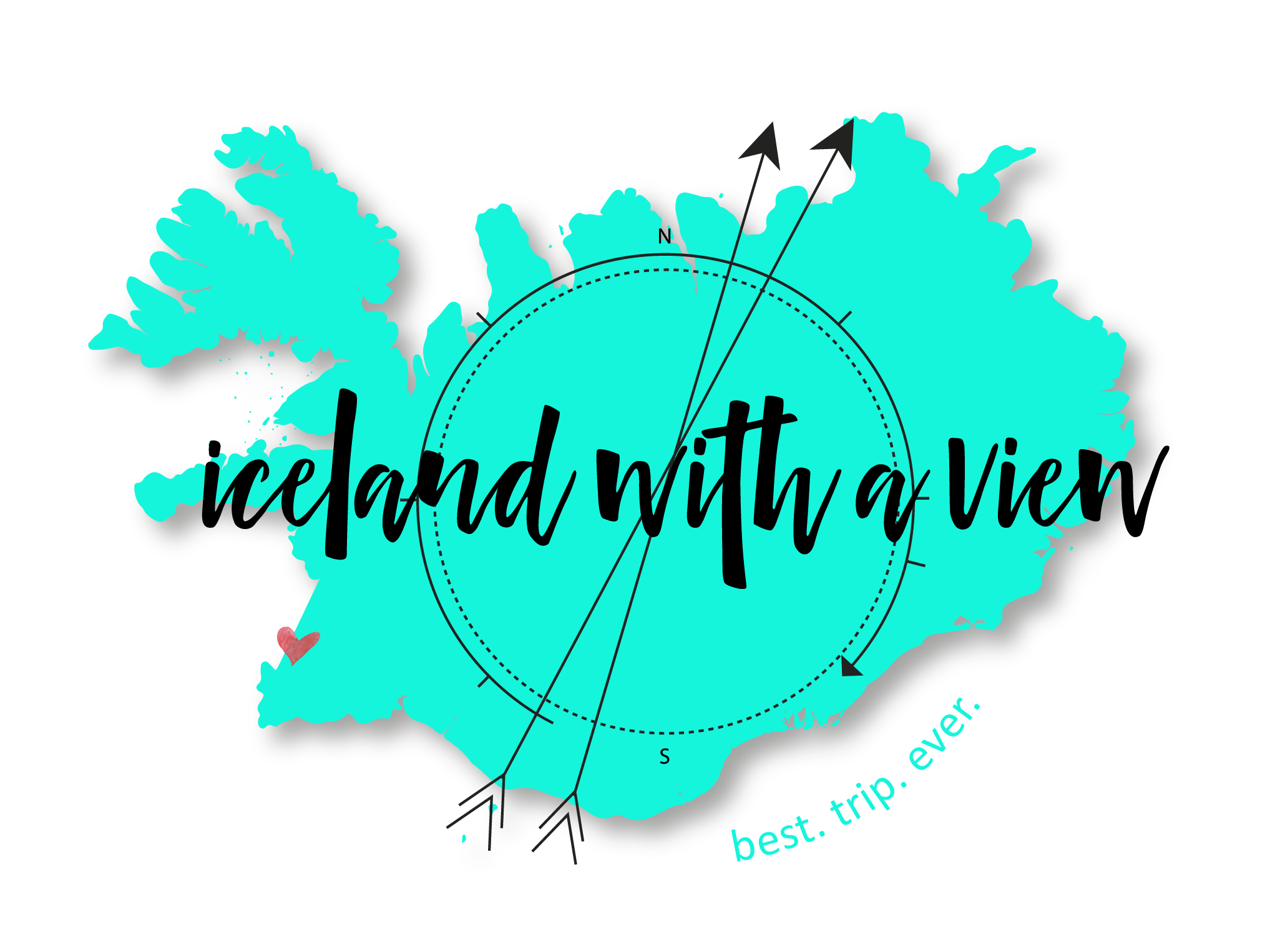
Iceland Animals & Wildlife: 7 Exciting Creatures To Spot On Your Trip!
Hello, my fellow Iceland animal lovers! Are you ready for some serious cuteness overload?
While Iceland might be famous for its jaw-dropping landscapes, it’s also home to a whole host of adorable animals!
From the fluffy Arctic fox to the majestic reindeer, there are so many fascinating creatures for you to discover in Iceland!
In this guide, I’ll show you the best places to witness these amazing species – as well as the ideal times to visit to get a chance at spotting them.
Ready to dive into the world of Iceland wildlife together?
Icelandic Horse

When you visit Iceland, you simply can’t miss out on the Icelandic horse – it’s one of the country’s most treasured animals. These stunning creatures are used for farm work, horse shows, and leisurely rides, and you’ll come across them all over Iceland.
It’s important to keep in mind that there aren’t any wild horses in Iceland, and every horse you see belongs to someone. So, as you travel, be mindful of their owners and don’t approach them without asking for permission first.
Want to get up close and personal with these magnificent creatures? A tour is the way to go! You can pet and feed them, snap photos, and even take a ride on an Icelandic horse!
Horseback Riding Iceland
Horseback riding in Iceland is such a unique way to explore Iceland’s rugged countryside.
There are plenty of horseback riding tours in Iceland that cater to all levels of experience, so you can gallop through Iceland’s stunning landscapes no matter your skill level.
Another bonus? The Icelandic horse’s gentle nature if perfect for beginners looking to give horse-back riding a go!
You can search for a horseback riding tour by visiting my Tours page !
Iceland Puffins
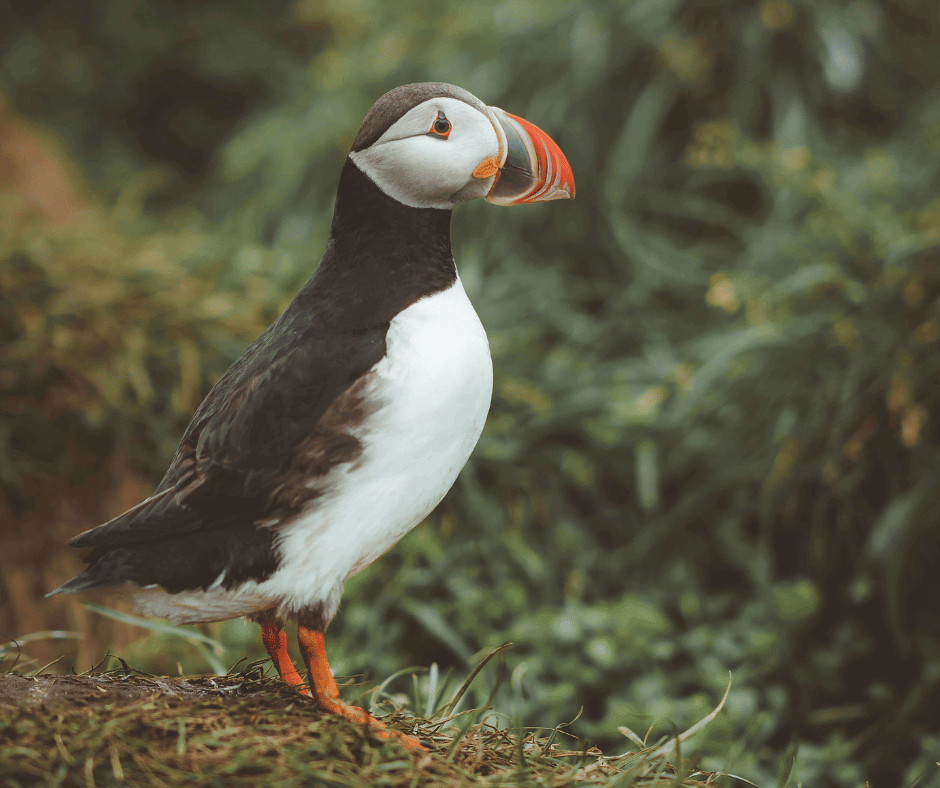
Ready to meet the cutest birds in Iceland? You’ll LOVE spotting the puffins! These adorable animals are native to Iceland and are a must-see for wildlife lovers, and it’s easy to see why.
Fun fact: Puffins are monogamous! How sweet is it that they choose to love one bird for the rest of their lives? 😍
Where To See Puffins In Iceland
Some of the most concentrated areas for Puffin-watching include Vestmannaeyjar, Borgarfjörður Eystri, and Látrabjarg cliffs in the Westfjords. So keep your eyes peeled for these beautiful birds on your Icelandic adventure!
Iceland Puffin Season
You can spot Puffins along the cliff sides of Iceland from April through August, with the best viewing opportunities between June and August.
Whales In Iceland
Whales are one of the most beloved animals in Iceland! Y ou won’t want to miss whale-watching if you have a soft spot for these gentle creatures. The most common whales you’ll spot that are native to Iceland are the minke whale and the humpback whale.
Best Time To See Whales In Iceland
Whale-watching season in Iceland runs from April to October, with the peak prime time happening between June and August.
While technically it’s possible that you MIGHT spot whales from the shore, I highly recommend booking a whale-watching tour.
Getting up close and personal with these magnificent creatures is a truly magical encounter. It’s a MUST-DO Iceland wildlife experience!
Húsavík Whale Watching
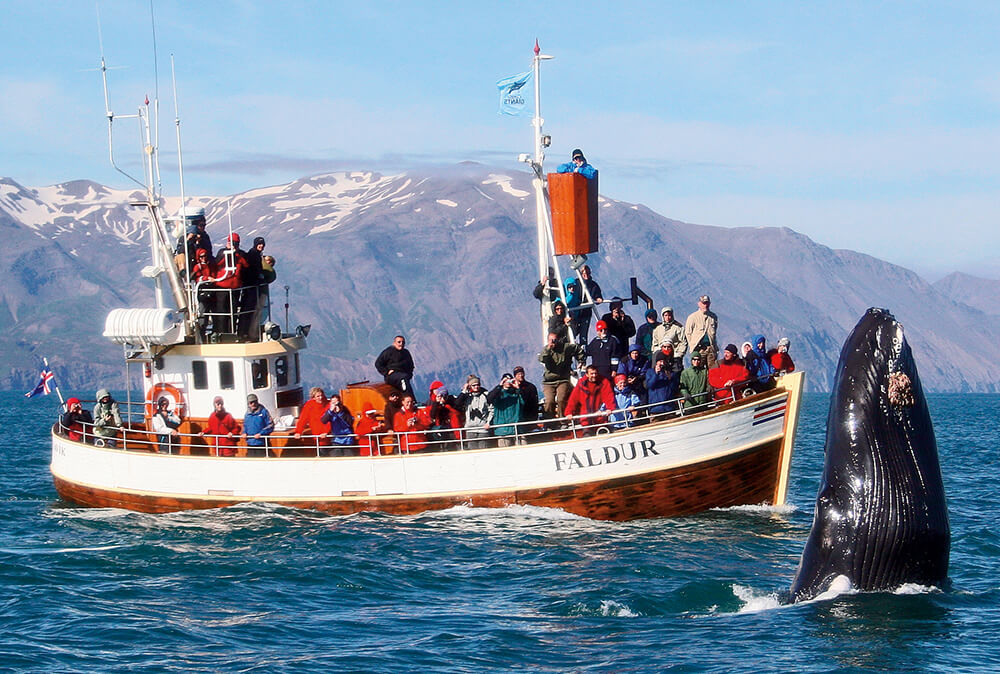
If you’re looking for the best whale-watching in Iceland, Húsavík is the place to be! Known as Iceland’s whale-watching capital, this town is not too far off the main road and boasts some of the country’s finest whale-watching tours. But even if you’re not planning on visiting Húsavík, don’t fret! You can still find whale-watching tours in Reykjavík, Dalvik, and Akureyri.
My go-to Húsavík whale watching tour company is Gentle Giants . I love them so much that I’ve even partnered with them to give Iceland with a View readers a 10% discount code.
All you need to do is apply the coupon WHALESWITHAVIEW at checkout and your discount will be applied!
Book your whale-watching tour here!
Iceland’s Arctic Fox
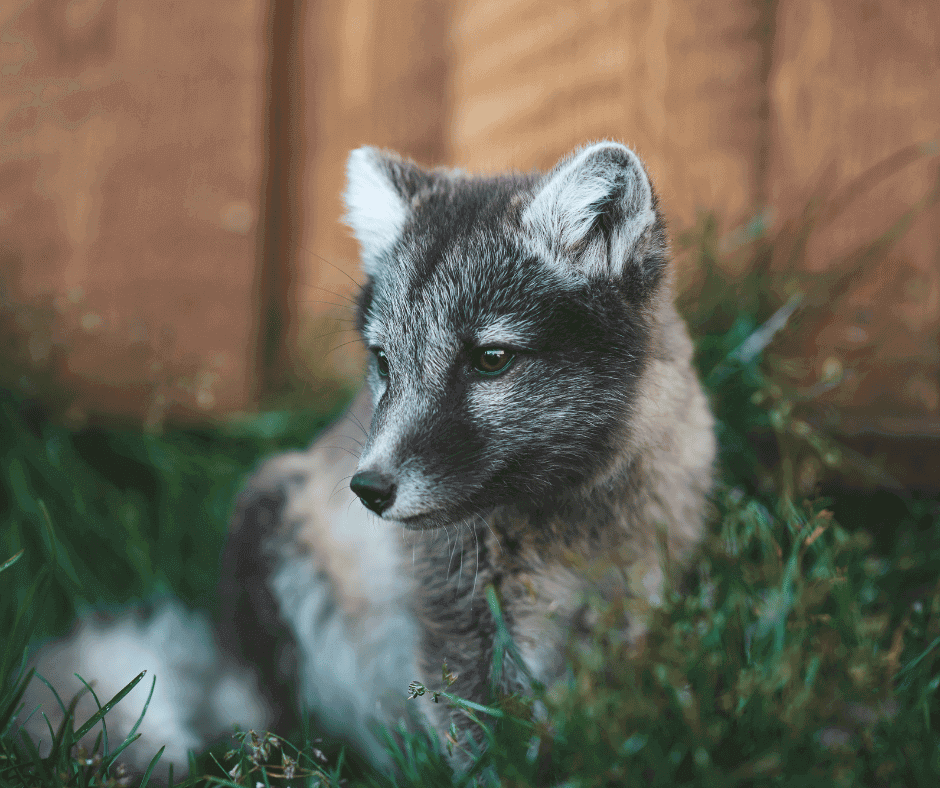
Here’s a fun wildlife fact for my nature geeks!
The Arctic fox is the only native mammal in Iceland.
It’s incredible when you DO get to spot one of these white, fluffy creatures, but they’re quite shy around humans.
While it can be difficult to find them, you might just get lucky and catch one if you’re in the right location. Some easier spots to see them are the Hornstrandir Nature Reserve in the West Fjords and Þórsmörk . I’ve spotted quite a few of them running around near the volcano huts.
Icelandic Seal

Icelandic seals are another sight to behold for wildlife lovers. They can be found year-round, but some of the most common places to see them include Jökulsárlón, the Vatnsnes Peninsula, and the Hvammstangi area – which even has a popular seal museum where you can learn all about these adorable Iceland animals.
So make sure to add a seal-spotting excursion to your Iceland itinerary – it’s an unforgettable experience!
Reindeer In Iceland
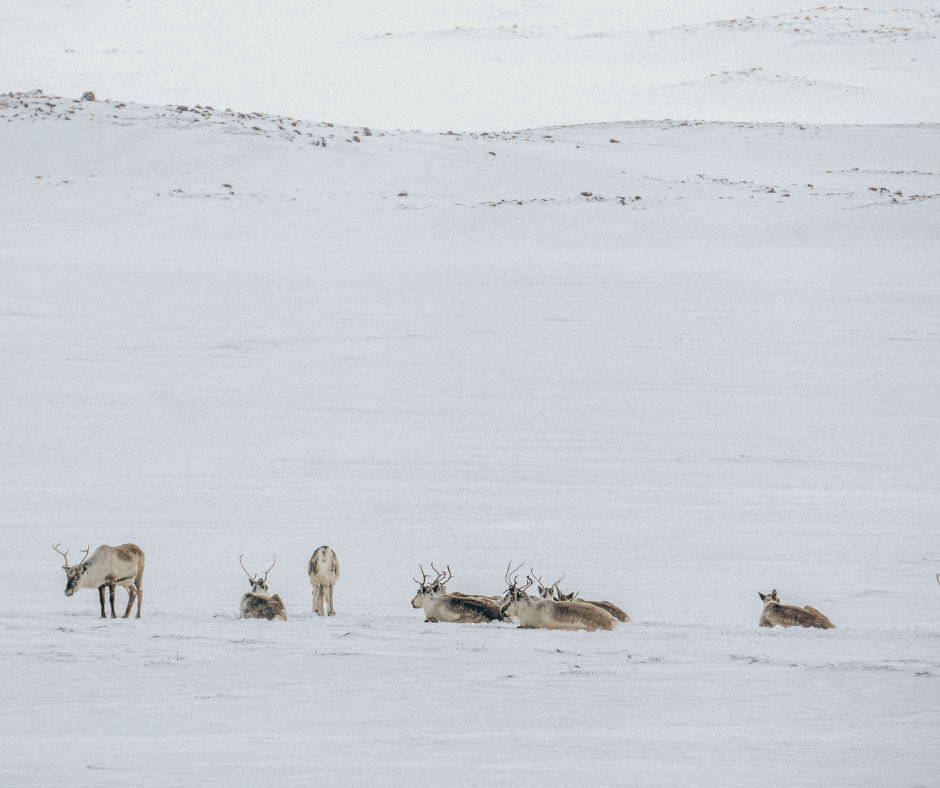
Have you ever seen a reindeer up close? They’re like a regular deer, but super-sized – and it’s SO cool when you actually see one out in the wild!
Reindeer aren’t technically a native animal to Iceland. They were actually imported from Norway in the 1900s and can now be seen in different parts of the country.
However, spotting reindeer isn’t easy. Some of the areas where Reindeer are most concentrated include East Iceland and parts of Northeast Iceland, so keep your eyes peeled around these parts!
Icelandic Sheep
If you’re traveling to Iceland between May and September, get ready to see sheep – lots and lots of sheep! These fluffy animals are a common sight in Iceland, and you can see them all over the country – grazing in fields, hiking up cliffs, and even crossing the roads.
They’re an important part of Icelandic culture, spending their days in the mountains, drinking fresh water, and getting all the vitamins and sunshine they need to thrive!
But come September, it’s time for the farmers to round them up and bring them back to the farms to be used for meat and wool. In the meantime, enjoy looking at these adorable creatures – just be careful when driving as they can go for a stroll and unexpectedly cross the roads!
Frequently Asked Questions About Iceland Wildlife
If you’re curious about Iceland’s wildlife, I’ve got you covered! Here are some frequently asked questions about animals in Iceland that you might find helpful.
Are There Snakes in Iceland?
Nope, you won’t find any snakes in Iceland. The country’s harsh climate and remote location have kept snakes away. So if you’ve got a snake phobia, Iceland will be your idea of heaven.
Are There Penguins In Iceland?
While you might expect to find penguins in a land famous for ice, penguins aren’t actually native to Iceland. Penguins can be found in the southern hemisphere and the Antarctic region.
Are There Polar Bears In Iceland?
Polar bears are not native to Iceland, but they can sometimes be spotted on the country’s northern coast, coming over from Greenland on Icebergs. However, they are extremely rare visitors to Iceland and sightings are very uncommon. If you do happen to spot a polar bear while in Iceland, be sure to keep a safe distance as they are potentially dangerous predators.
Are There Sharks Around Iceland?
Yes, there are sharks in Iceland, but not Great Whites like you might be thinking of!
The most commonly spotted shark around Iceland is the Greenland shark, which can reach up to 7 meters (23 feet) in length. Despite their impressive size, these sharks aren’t usually dangerous to humans and won’t attack unless provoked.
Are There Dangerous Animals In Iceland?
Iceland has some pretty amazing wildlife, but luckily none of it poses a big threat to humans! Thanks to the country’s isolation and harsh climate, predators have been kept at bay. Of course, while it’s always a good idea to be careful when exploring Iceland’s wilderness, you can relax knowing that you’re not in the presence of any seriously dangerous animals.
Whether you’re a birdwatcher looking to spot some puffins, a whale enthusiast eager to catch a glimpse of these magnificent creatures, or a nature lover hoping to explore Iceland’s rugged countryside, there’s something for everyone in Iceland.
And let’s not forget about the sheep, the country’s beloved and endearing fluffy residents, who roam freely during the warmer months and provide a delightful backdrop to any Icelandic adventure.
Remember to be respectful of the animals and their habitats, and always seek permission before approaching any domestic animals you find on your adventures.
Want to know the Icelandic animals and incredible wildlife you can see on YOUR specific route?
Take your planning up a notch with my Iceland Itineraries .
My itineraries help you remove stress from planning and MAXIMIZE your adventure!
In each itinerary, you’ll get:
- Detailed itinerary to make the most of each day (without feeling rushed)
- Accommodation recommendations, restaurant suggestions, and information on guided tours
- Thorough route information for navigating your trip — so you don’t end up driving by that must-see attraction
- Easy to download to your phone or tablet to use on your trip!
Check out all of my Iceland Itineraries HERE!

Pin it for Later!
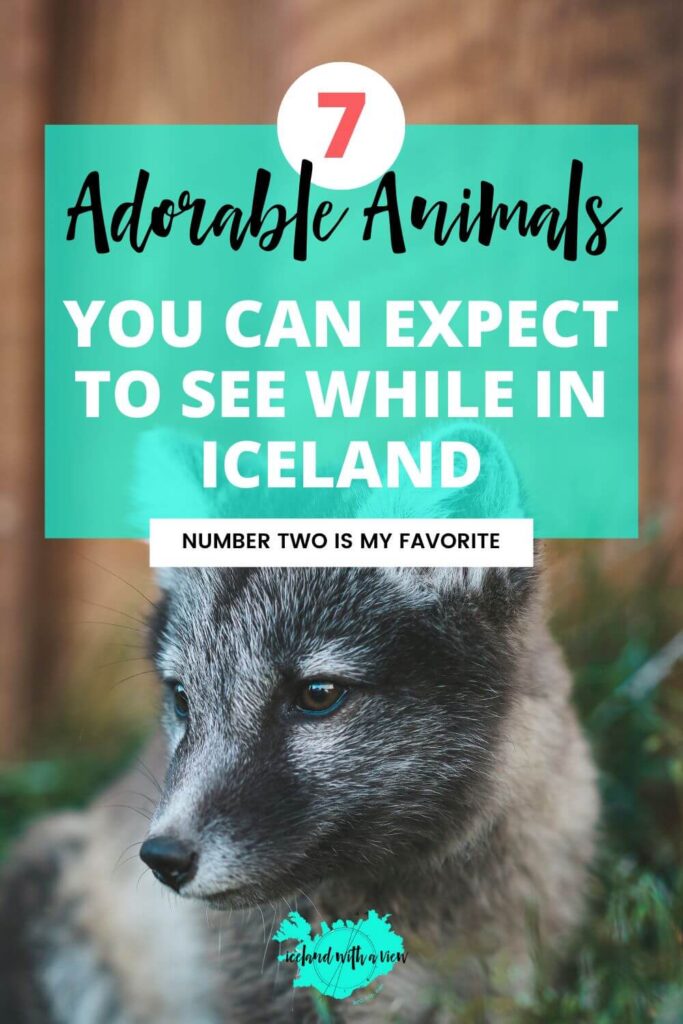
Similar Posts

Reykjavík Food & Drink Guide: The Best Foodie Hot Spots In Iceland’s Capital
One of the best ways to experience a culture is through your stomach! Whether it’s enjoying the unique flavors of Reykjavík’s food scene or bonding over a local beer, you’ll definitely feel connected to the heart and soul of Iceland. …

How To Get Around Iceland – 10 Transportation Options
Are you wondering how to get around Iceland? In this post, I’ll share ten Iceland transportation options to navigate this beautiful country!
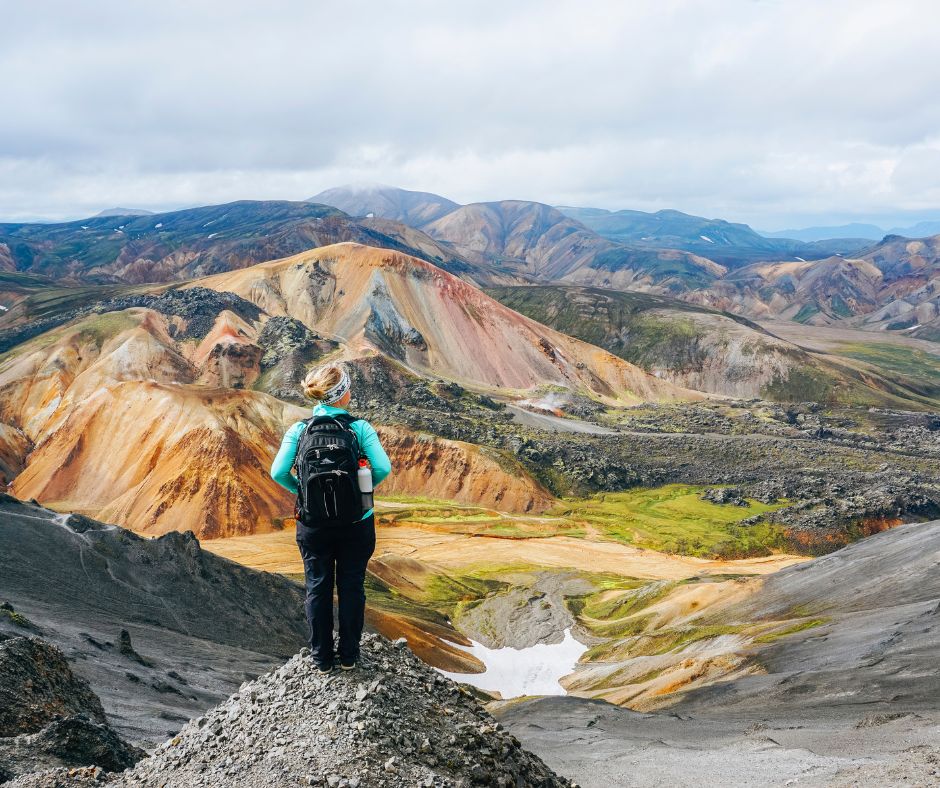
Solo Travel in Iceland: Why it’s the Best Country in the World to Visit Alone
Solo travel in Iceland – now that’s an adventure filled with endless possibilities! If you can imagine yourself on a black sand beach at sunset, with a beverage in your hand in the most beautiful place on earth, know this:…

Eating Gluten-Free in Iceland: Expert Tips, Best Restaurants + More
So, you’re gearing up for an unforgettable trip, but wondering… Can I eat gluten-free in Iceland? If you’ve heard me talk about yummy Icelandic hot dogs and the best cinnamon rolls in the world, you might be thinking about what…
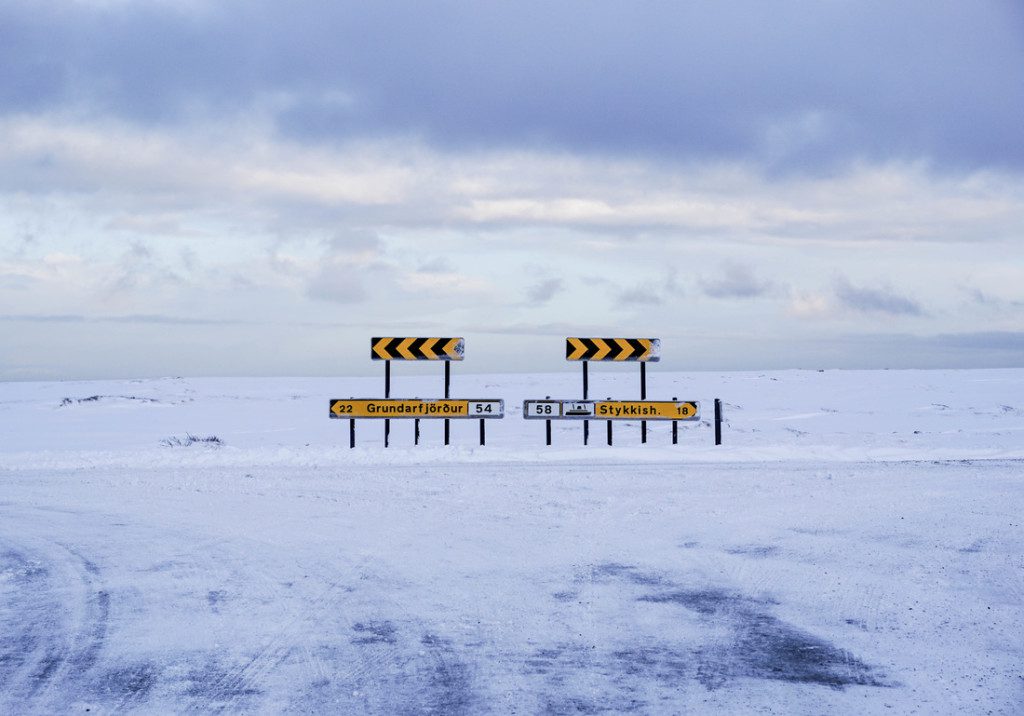
Road Signs You Need to Know Before Driving in Iceland
Driving in a foreign country can sometimes be overwhelming. Amiright? First of all, the only thing on your mind is getting to your awesome destination. Second, you’re driving a rental car and maybe it’s manual and you haven’t used a…
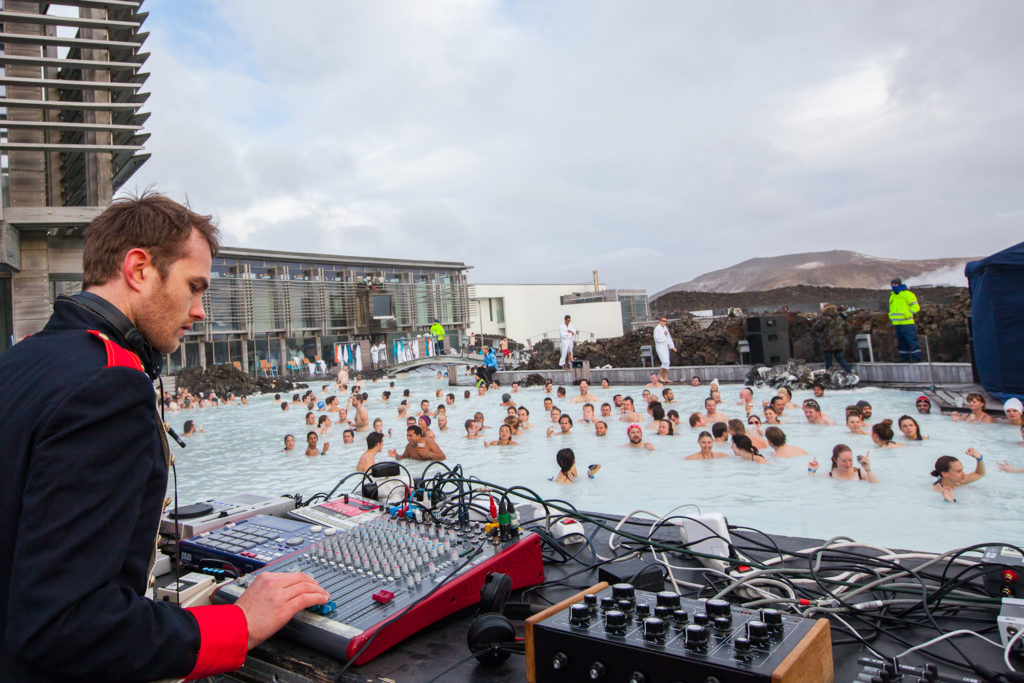
The Best Festivals and Music Events in Iceland
There’s no shortage of fun festivals and events in Iceland. If you’re into music, dance, culture, art, or all of the above then you are in luck, I have a whole calendar of things for you! In Iceland you can…
Privacy Overview

The Best Months to Visit Iceland: Fewer Crowds, the Northern Lights, and Prime Puffin Spotting
The best time to visit iceland depends on your itinerary..
- Copy Link copied

Whether you want to see the Northern Lights or go hiking, Iceland has plenty to do and see throughout the year.
Ragnar Th. Sigurdsson/age fotostock
Iceland sparkles and awes year-round, but what you can do while you are there varies dramatically from season to season. For most visitors, the best time of year to visit Iceland is undoubtedly summer, since the daylight stretches to 20-plus hours, and even the most remote regions become accessible.
But the shoulder seasons in May and September are a chance to avoid the heavy crowds, and winter to spring, spanning from October to April, shows a completely different face of the country.
Here’s the best time to visit Iceland, depending on what you have planned for your trip.
Hiking and the Highlands
Best Months: June–August
Part of the majesty of Iceland, of course, is getting out into its roiling lava fields, up on its crater rims, and alongside its thundering waterfalls. Summer is prime for hiking because the snow has melted and the trails have begun to harden (no mud-slush for you!) Also, this is the season when the interior highland F-roads open to four-wheel drive (4WD) traffic and tours—check out Midgard Adventure in the south and Fjalladýrð in the northeast. Some roads begin to open as early as the beginning of June, but others may not open until deep into July, and then they begin to close and become impassable by late August or early September. Similarly, Hornstrandir Nature Reserve in the Westfjords is at its most accessible from June to August.
Plus, in the summer you have upwards of 20 hours a day of sunlight to get out and get moving, and the weather, though always changeable, is at its warmest, averaging from 46 to 55 degrees Fahrenheit. This is also peak time for other activities like rafting, canyoneering, kayaking, and diving the Silfra Fissure at Þingvellir National Park.
Avoiding the Crowds
Best Months: October–April
Iceland in winter, when the weather is cooperating, can give you thrilling opportunities to visit extremely popular places like the Dyrhólaey Peninsula and the Dettifoss waterfall without the crowds. As an added benefit, the car rental and hotel prices drop in some regions. Downside? Outside of Reykyavík, many tourist-dependent hotels, restaurants, and shops close in true winter.
Also, winter exploring is not for the faint of heart if you plan to drive yourself, as roads are often snowy or icy, and snowstorms regularly pass through. Iceland is well equipped, though, with excellent weather forecasting and websites for road conditions , and rental cars have snow tires (a 4WD vehicle is the best bet at this time of year). The rewards are giant: Think about the possibility of standing alone on a volcanic beach in a snowscape of white-and-black drama.
If true winter seems too intense, choose September or May—a good compromise, as average temps range from 40 to 50 degrees Fahrenheit.
Best Months: May–September
One of the grand pleasures of a trip to Iceland is cruising its remote roads through open landscapes and along wave-swept shores, absorbing the majesty of the country. For example, you can make a wellness road trip in the Westfjords , connecting natural springs and town pools with the occasional luxe spa. Or go for a waterfall tour around the Ring Road. The experience is much better in good (or, at least, not bad) weather, so late spring to late summer is an ideal time to visit. However, during high-season summer, the Ring Road can get busy, especially in the south, where most tourists go, creating snaking lines of traffic. This is easily avoided, though, by simply venturing further afield—consider routes like the Diamond Circle route or the Arctic Coast Way .

Come to Iceland in the summer for a chance to have up-close encounters with adorable puffins.
Nicholas Kampouris/Unsplash
Wildlife Watching
Best Months: Puffins May–mid-August, birdwatching mid-May–July, whales April–September
A trip to Iceland offers the opportunity to see wildlife you don’t usually encounter in your backyard. Seasons vary by animal, of course, so if you’re looking for cavorting puffins, come starting in May, when they return from the open ocean, and get there before mid-August, when they leave again. The Vestmannaeyjar Islands are tops for their abundant colonies (they also have a beluga sanctuary), or go on a puffin tour at Ingólfshöfði in the back of a charming tractor wagon.
Birdwatching of other sorts is generally a summer activity in Iceland’s wetlands and lakes. like North Iceland’s Mývatn—birds are most active mid-May to mid-June as they arrive and build nests—and bird cliffs, like Látrabjarg in the Westfjords. Some areas close during nesting to protect the birds’ habitat. The elusive Arctic fox, the only mammal native to Iceland, is tough to spot. It’s most likely to be seen on the move near sunrise and sunset along coastlines and in summer when you can visit the Westfjords’ Hornstrandir Nature Reserve.
Whales and dolphins pass by year-round, and tours leave from Reykjavík, Húsavik (in the north), Grundarfjörður, and Ólafsvík (on the Snæfellsnes Peninsula), but April to late September or early October are the best months because the cetaceans arrive en masse to feed in local waters.
Animal activities, like excellent horseback riding or visiting the Icelandic goat farm at Háafell, though easiest in summer, happen year-round.
Cultural Life
Best months: Year-round
Part of Iceland’s immense charm is its welcoming, fascinating, vibrant people and their culture. And that’s available in all seasons. Sure, summer sees festivals like Pride, National Day, and Reykjavík Arts Festival , and cities and towns are wide open for business. But as darkness spreads across the land, Icelanders play on into the winter at music festivals Iceland Airwaves and Dark Music Days or the midwinter feast of Þorrablót, when Icelanders celebrate their culture, and you can sample fermented, smoked, and unusual (for you!) Icelandic fare. Reykjavík’s excellent museums, galleries, music clubs, and design shops boom year-round.

One of the best places to see the Northern Lights is by Skógafoss Waterfall.
Photo by Balazs Busznyak/Unsplash
Northern Lights
Best Months: September–April
Always a treasure hunt, the search for shimmering curtains of the Northern Lights is easiest with long winter nights—more darkness equals more chance to see them. But you need to find clear skies and high solar activity ( Aurora Forecast is a helpful resource). Interestingly, the most activity occurs around the equinoxes (September/October and March/April), when solar particle ejections are at their highest, though you have a shot from November to February as well, simply because there are up to 20 hours of darkness per night.
Snow and Ice Sports
Best months: glacier hikes year-round, ice caves October/November–March
Naturally, snow sports like skiing are best in winter, when there’s more snow. Same goes for ice caving, when these glistening complexes become more stable at glacier edges. But you can hike on glaciers, ice climb, and go snowmobiling throughout the year. In all seasons, go with a local guide (check out Icelandic Mountain Guides and Tröll Expeditions )—the crevasse-laden glaciers are never stable enough for newbies.

The Nordic Nomad
Regions & islands
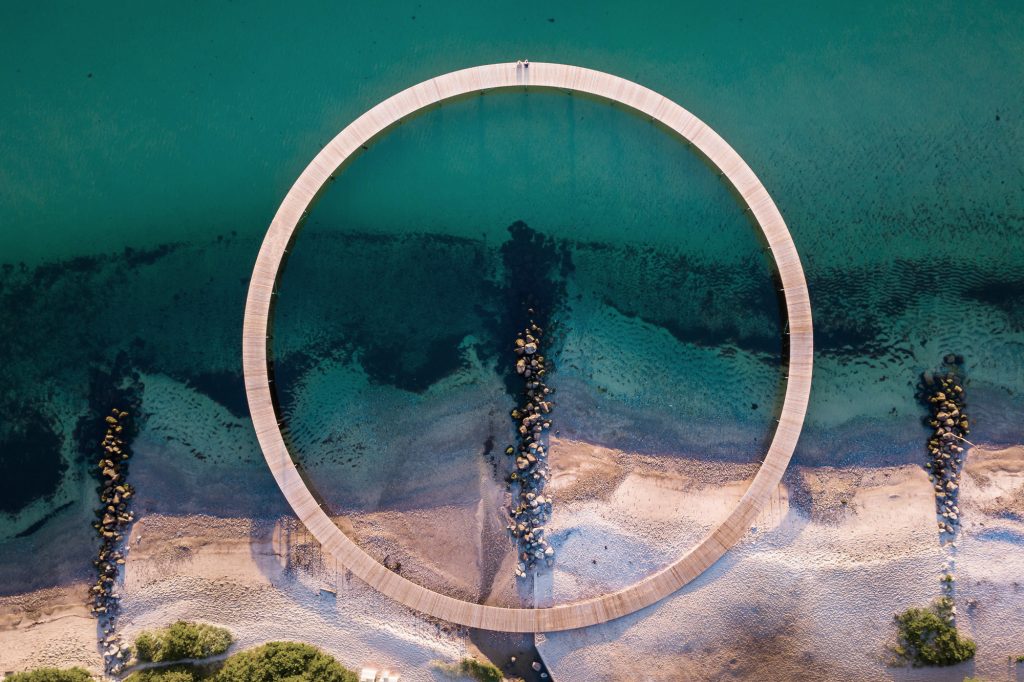
Cities & towns
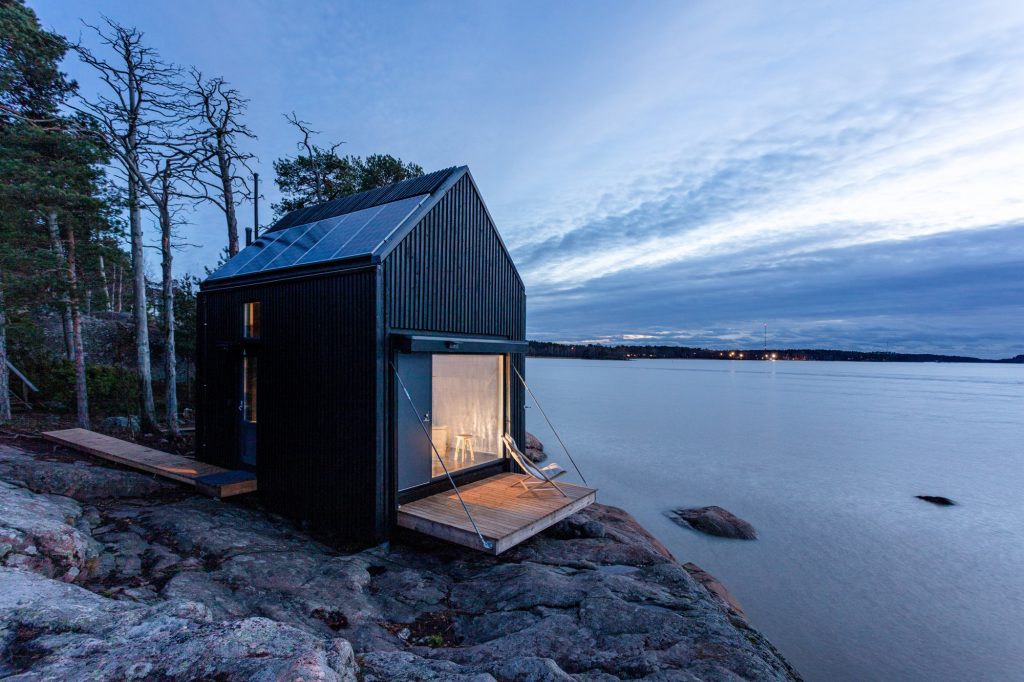
The in-depth guide to choosing the best time to visit Iceland
The Nordics • Iceland • The in-depth guide to choosing the best time to visit Iceland
How to determine the best time to visit Iceland

What is the best time to visit Iceland?
Wondering when’s the ideal time to explore Iceland? From our adventures and the tales we’ve gathered, there’s no one-size-fits-all answer. Iceland is enchanting year-round, but your perfect season depends on what experiences you’re chasing.
Summer brings those endless days we’ve all heard about, with the sun barely setting. It’s a dream for explorers; we have trekked through the Highlands bathed in 24-hour daylight, feeling like the day just doesn’t end. It’s prime time for hiking, wildlife watching and soaking in the vibrant life of Icelandic towns and countryside.
However, autumn and spring offer their own charm. We have witnessed Iceland draped in the golden hues of autumn and spring’s fresh bloom – both are breathtaking. These seasons boast fewer visitors, making it easier to enjoy Iceland’s stunning landscapes at a more relaxed pace. The temperate weather is perfect for those who prefer milder adventures.
Winter, on the other hand, transforms the island into a snowy paradise, ideal for those magical Northern Lights we have all dreamt of seeing. Though the days are short, they’re incredibly sweet, with snow-covered landscapes and cosy nights. We’ve marvelled at the Northern Lights – the aurora borealis – dancing across the sky, a truly unforgettable experience. Make this a must-experience on your bucket list.
So, when’s the best time to visit Iceland? It hinges on your preferences. Let’s explore the options be delving into what each season has to offer.

What can I expect from Iceland in spring?
When you think about visiting Iceland in spring, you’re essentially signing up for a front-row seat to nature’s grand reopening act. This period, stretching from April to June is a whole experience filled with burgeoning life and longer days, tempered by the lingering kiss of winter’s chill.
Weather and temperatures
The spring season introduces a milder climate, with our thermometers often reading between 0°C to 10°C (32°F to 50°F). Although the tail end of winter might surprise us with a snow shower in April, by the time June arrives, we’re greeted with longer, sunnier days. This unpredictable weather underscores the importance of packing layers, a tip we always share with fellow travellers.
Exploring the regions
Our ventures into the Golden Circle during spring reveal a quieter, yet equally majestic side of Þingvellir National Park, Geysir Geothermal Area and Gullfoss Waterfall. The reduced crowds afford us more space to fully immerse in the beauty and grandeur of these sites. The South Coast, too, becomes a beacon for us nature lovers, with accessible attractions like the striking black sand beaches of Vik and the serene Jökulsárlón Glacier Lagoon, where the sight of drifting icebergs is simply mesmerising.
In spring, we also find the trails beckoning us for more adventures. The paths in Þórsmörk, accessible a bit later in the season, offer breathtaking views that we can’t help but recommend to anyone seeking to connect with Iceland’s wild side. Additionally, the return of puffins to the cliffs is a spectacle we eagerly anticipate each year. These charming birds add a vibrant touch to the cliffs, making spring an ideal season for bird watching.
Seasonal highlights
The power of Iceland’s waterfalls in spring cannot be overstated. Fed by the melting snow, waterfalls like Seljalandsfoss and Skógafoss swell, their roar and might a testament to nature’s force. Our journeys here are always humbling, reminding us of the raw beauty Iceland holds. For those of us keen on ornithology, spring’s the season when bird life flourishes, offering unique opportunities to observe Iceland’s avian residents up close.
Spring in Iceland not only invites exploration through its transitioning landscapes but also offers a variety of activities that make the most of the unique climate and natural beauty of this season. Beyond the hikes and wildlife watching, spring is the perfect time for road trips around the island, where the roads are less burdened by winter’s snow, allowing for smoother travel to distant attractions. It’s an opportunity to dive into the geothermal pools scattered across the country, which seem even more inviting against the cooler air.
Iceland spring pros and cons

What can I expect from Iceland in summer?
Summer in Iceland, spanning from June to August, is a chapter of endless daylight and nature in full bloom, offering an unparalleled experience for those who venture to this island nation. Based on our adventures and the shared experiences within our community, here’s what summer in Iceland has in store.
The summer months welcome warmer temperatures, typically ranging from 10°C to 15°C (50°F to 59°F), occasionally reaching up to 20°C (68°F) or more on the warmest days. This season bathes the island in nearly 24 hours of daylight, especially around the summer solstice in June, creating the extraordinary phenomenon of the Midnight Sun. This extended daylight allows us, and indeed all visitors, to maximise our explorations and adventures across the island.
Summer is the prime time to delve into all corners of Iceland, with every region accessible to explore. We often recommend the Westfjords for those seeking untouched wilderness; here, the dramatic landscapes and bird cliffs, such as Látrabjarg, are in their most glorious state. The Highlands also become reachable, offering hiking trails through otherworldly landscapes that are inaccessible at other times of the year.
Our journeys have taken us along the Ring Road encircling the island, where each stop presents a new marvel, from cascading waterfalls and geothermal springs to picturesque villages. The long days mean you can wander through the lava fields of Landmannalaugar or the serene beauty of the Eastfjords well into the evening.
One of the most magical aspects of summer in Iceland is the opportunity to experience its vibrant wildlife. Whale watching becomes particularly rewarding, with tours departing from Husavik or Reykjavik offering chances to see these majestic creatures in their natural habitat. The puffins, too, are a sight to behold, particularly in the Westman Islands, where they nest in large colonies.
Festivals and cultural events pepper the summer calendar, from the Secret Solstice music festival in Reykjavik to traditional celebrations in small towns and villages. These events offer a glimpse into the rich tapestry of Icelandic culture, something we always encourage visitors to immerse themselves in.
The endless daylight of summer encourages all forms of outdoor activities. Whether it’s hiking, kayaking, glacier tours, or simply enjoying the natural hot springs scattered across the country, the opportunities are as endless as the daylight. For us, one of the greatest pleasures of summer in Iceland is the chance to connect with nature on such an intimate level, from the quiet of early morning walks to the stillness of nightless nights.
Read the full article on summers in Iceland .
Iceland summer pros and cons

What can I expect from Iceland in autumn?
Autumn in Iceland, from September to November, is a season of transformation, where the landscape bursts into spectacular shades of red, orange and yellow. Our collective experiences have shown us that this period offers a quieter, yet equally captivating, alternative to the bustling summer months.
As autumn progresses, the temperature starts to cool, ranging from about 5°C to 10°C (41°F to 50°F) in September and dropping to around 0°C to 5°C (32°F to 41°F) by November. This season sees a mix of crisp, clear days and the return of darker evenings, setting the stage for the Northern Lights’ return. We always remind travellers to dress in layers, as the weather can shift quickly, and to be prepared for both rain and the occasional snowfall as winter approaches.
Autumn is an excellent time for us to explore the less-trodden paths. The countryside, adorned in autumnal hues, offers breathtaking scenery, making it a perfect time for photographers and nature enthusiasts. The Ring Road remains a popular route, with fewer tourists and more opportunities to enjoy the sights at a leisurely pace.
The Snæfellsnes Peninsula, with its dramatic coastline and the iconic Snæfellsjökull glacier, becomes a place of stark beauty under the autumn sky. Meanwhile, the Eastfjords, less visited than other parts of the country, offer tranquillity alongside spectacular fjord landscapes.
Autumn marks the beginning of the Northern Lights season, a phenomenon we eagerly anticipate each year. The darker nights provide a canvas for this celestial dance, with viewing opportunities increasing as the season deepens.
This season is also rich in cultural experiences, with various harvest festivals and events that allow us to delve deeper into Icelandic traditions. It’s a time when the country celebrates its bounty, and we often join in the festivities, from apple picking in the North to enjoying the new season’s first catch in coastal towns.
Hiking remains a popular activity in early autumn, with trails in the national parks offering stunning vistas of the changing foliage. It’s also an ideal time for hot spring visits; soaking in a geothermal pool surrounded by autumn’s palette is an experience unlike any other.
Whale watching continues into the early part of the season, and sea kayaking among the fjords offers a unique perspective on the country’s rugged coastline. For those of us drawn to the night sky, chasing the Northern Lights becomes a captivating pursuit, with various tours and spots around the country known for their optimal viewing conditions.
Iceland autumn pros and cons

What can I expect from Iceland in winter?
Winter in Iceland, spanning from December to February, immerses the island in a magical stillness and offers a distinct kind of beauty that draws adventurers and dreamers alike. Through our travels, we’ve uncovered the serene allure and vibrant culture that define Icelandic winters.
Winter brings colder days with temperatures often hovering between -5°C to 3°C (23°F to 37°F). While it’s the darkest season, with short days and long nights, this creates the perfect backdrop for one of Iceland’s most magnificent natural phenomena – the Northern Lights. Packing warm and waterproof clothing is essential, as the weather can be unpredictable, ranging from clear, crisp days to snowy conditions.
The allure of Iceland’s winter landscape is undeniable. Reykjavik becomes a cosy haven, its streets lined with twinkling lights, offering warmth and cheer. Outside the city, the snow-covered landscapes, frozen waterfalls and ice caves offer a surreal beauty that is uniquely accessible during these colder months.
The South Coast’s waterfalls, like Skógafoss and Seljalandsfoss, take on a mystical appearance, partially frozen and framed by snow. Venturing into the ice caves beneath Vatnajökull, Europe’s largest glacier, becomes a highlight, offering a glimpse into a mesmerizing world of blue ice.
The Northern Lights are, without a doubt, one of the main draws of Icelandic winters. The extended hours of darkness provide ample opportunity to witness the auroras’ dance across the sky, a sight that continues to captivate us year after year.
Winter festivals and cultural events, such as Þorrablót, the mid-winter feast, allow us to engage with Icelandic traditions and cuisine, offering insight into the country’s heritage. New Year’s Eve in Reykjavik, known for its impressive fireworks display, is a celebration we always look forward to, embodying the community spirit and festivity of the Icelandic people.
Winter activities in Iceland are plentiful, from snowmobiling on glaciers to soaking in geothermal hot springs amidst the snow. Dog sledding and horseback riding through the winter landscape offer unique ways to explore the countryside, while skiing and snowboarding are available for those seeking a more adrenaline-fueled experience.
Iceland winter pros and cons

When are the peak and off-peak tourist seasons, and how will they affect my travel experiences?
Navigating through Iceland’s tourist seasons is akin to choosing the perfect moment for an unforgettable adventure. We’ve seen how the island transforms with the ebb and flow of visitors, shaping not just the landscape but our experiences within it.
Peak season
Summer, stretching from June to August, is when Iceland truly comes alive. It’s when we’ve basked in the glory of the Midnight Sun, marvelling at how the landscapes unfold in endless daylight. This is the season of abundance, not just in natural wonders but in the buzz of fellow travellers sharing the trails, the warmth of the locals hosting numerous festivals, and the vibrancy of Icelandic culture in full swing. While we’ve revelled in the energy of crowded sites and the lively atmosphere, we’ve also navigated the challenges of higher prices and the need to book our adventures well in advance.
Off-Peak season
The charm of visiting Iceland in the shoulder seasons – spring (April to May) and autumn (September to October) – lies in the more intimate experience of its majesty. We’ve found these months to bring a quieter beauty, with fewer tourists and more moments of serenity amidst the shifting landscapes. It’s a time when we connect more deeply with the locals and enjoy the natural beauty at a more leisurely pace, often benefiting from lower travel costs.
Winter, from November to March, holds a special place in our hearts. It’s a season that cloaks the island in a quieter, reflective mood, perfect for those of us chasing the ethereal Northern Lights or simply looking to immerse in Iceland’s winter wonderland. The shorter days and cooler nights bring their own kind of magic, one that we have embraced with warm layers and open hearts, finding joy in the festive lights and the snow-draped tranquillity.
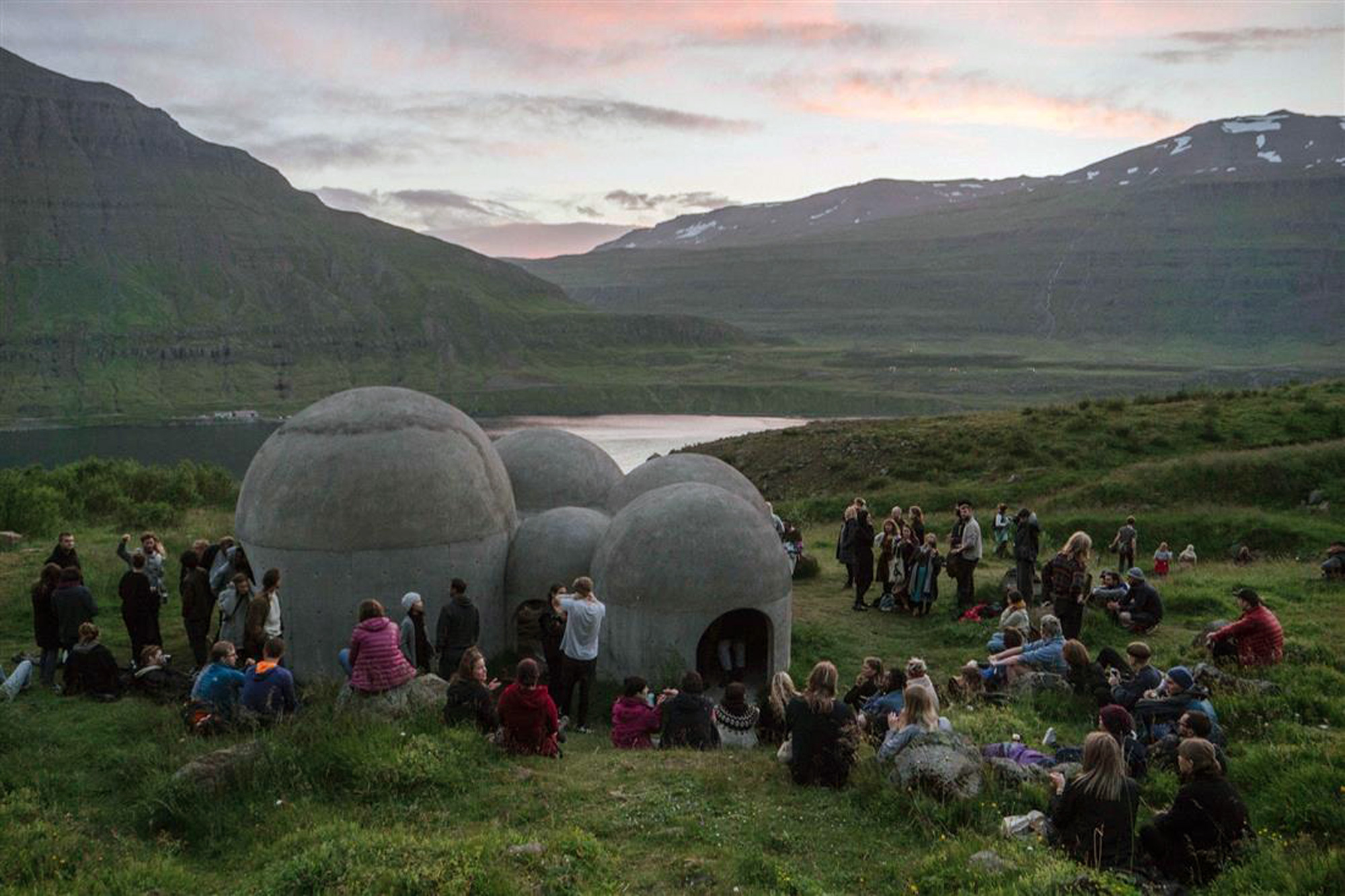
What are the best times for specific activities and festivities?
Diving into Iceland’s calendar year, we’ve discovered that each season brings its own set of activities and festivities. Whether you’re an adrenaline junkie, a nature lover or a culture enthusiast, knowing when to catch these experiences at their peak can elevate your Icelandic adventure.
In the spring, we’ve eagerly joined the locals in welcoming the return of longer days at the First Day of Summer celebration in April, a tradition rooted deep in Old Norse culture, marking the beginning of the brighter half of the year. This period is also prime for whale watching as migratory paths bring these majestic creatures closer to Iceland’s shores, particularly around the Snæfellsnes Peninsula and the North.
Summer in Iceland is synonymous with festivals that celebrate the sun that never sets. We’ve danced under the sky at the Secret Solstice Festival, an unforgettable experience that aligns with the summer solstice. The National Day on June 17th, commemorating Iceland’s independence, fills the streets with parades, concerts and family activities, showcasing a proud nation in full festive spirit.
As autumn paints the island in vibrant colours, we’ve found ourselves amidst the magic of the Reykjavík International Film Festival. It’s a time when the art scene flourishes, inviting cinephiles and creators into intimate venues for screenings of international and local films. The onset of the darker nights also marks the beginning of the Northern Lights season, turning the sky into a canvas of ethereal beauty best observed from late September onwards.
Winter brings its own charm with Christmas markets popping up in towns and cities, enveloping the cold air with the warmth of holiday spirit, twinkling lights and the scent of traditional treats. But it’s the New Year’s Eve celebrations that truly capture the essence of Icelandic winter. With community bonfires creating beacons of light and fellowship across the island and a fireworks display that rivals any around the world, it’s a welcoming of the new year that stays with you forever.

What are the recommendations if I seek to avoid crowds while still enjoying Iceland’s beauty?
Seeking the serene beauty of Iceland without the hustle of crowds is an art we’ve honed over our travels. Here are some recommendations that have allowed us to enjoy the tranquillity of this majestic land, away from the busier paths.
Exploring the less-travelled Westfjords offers a retreat into some of Iceland’s most remote and stunning landscapes. Here, the cliffs, waterfalls and fjords stand in quiet majesty, often with no other soul in sight. The roads are more challenging, but the rewards are unparalleled in peace and beauty.
Early morning or late evening excursions to popular sites like the Golden Circle can also bypass the peak visitor times, allowing for a more personal experience with these wonders. The soft light of these hours adds a magical touch to the already breathtaking scenery.
Visiting during the shoulder seasons of late spring and early autumn presents a sweet spot. The rush of summer tourists has either not yet arrived or has left and many of Iceland’s attractions retain their allure with the added bonus of quieter surroundings.
Seeking out hidden gems that are off the usual tourist radar can lead to some of the most rewarding experiences. Places like the Hvalfjörður fjord, the Berserkjahraun lava fields or the charming town of Seyðisfjörður offer beauty and solitude in equal measure.
Finally, engaging with local guides and tours that specialize in off-the-beaten-path adventures can uncover secret spots unknown to most visitors. These experiences not only support local businesses but also offer insights into Iceland’s culture and nature that can’t be found in guidebooks.

What are the best months for specific wildlife sightings?
For wildlife enthusiasts, Iceland presents an array of opportunities to observe unique species in their natural habitats, each peaking in visibility at different times of the year.

Whale watching
The summer months from May to September are prime for whale watching, especially in Husavik, often dubbed the whale watching capital of Iceland. During this period, the calmer waters and warmer weather enhance the likelihood of spotting various whale species, including the humpback, minke and even the massive blue whales. Whale sightings are more frequent in June, July and August, aligning with their migration patterns to feed in the nutrient-rich Icelandic waters.
These charming birds are a must-see, with their breeding season spanning from April to August. Notable locations for puffin spotting include the Westman Islands, home to Europe’s largest puffin colony and Látrabjarg cliffs in West Iceland. These areas allow for relatively close observation of puffins in their natural setting, especially during June to August when they are most active on land.
The Vatnsnes Peninsula in North Iceland is notable for seal watching, with the best chances of seeing grey and harbour seals along the coast. Summer offers the most reliable opportunities for seal sightings, complemented by informative exhibits at the Icelandic Seal Center, which provides insights into their habits and the best spots for observation.
For those interested in observing Iceland’s only native land mammal, the reindeer, East Iceland is the place to be. These majestic creatures are more commonly sighted around Snæfell and the East Fjords, where they migrate seasonally. While they roam the highlands during summer, they move to the warmer lowlands in winter, making them a unique sight against Iceland’s diverse landscapes.

The 10 best boutique and luxury hotels in Reykjavík, Iceland

Suðurland’s stays: the 8 best hotels along Iceland’s south coast

- New openings , Stay
The 2023 hot list: the 10 best new hotels in Scandinavia and the Nordics

Highland Base in Selfoss, Iceland
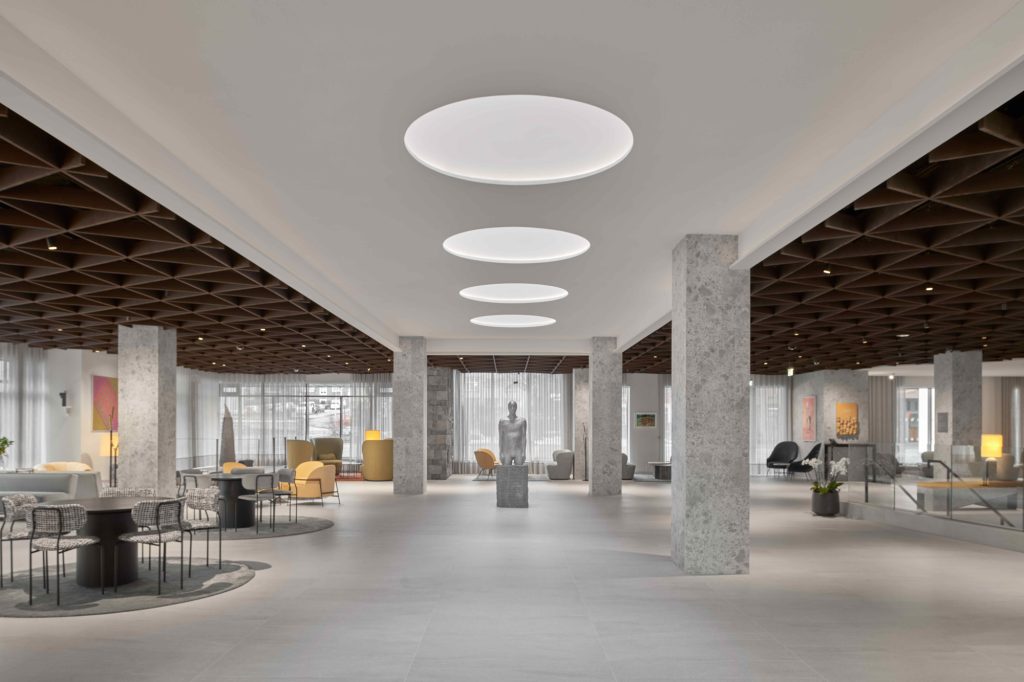
Iceland Parliament Hotel in Reykjavík, Iceland

Iceland’s most remarkable off-grid stays in nature

The Retreat at Blue Lagoon in Grindavík, Iceland

Ion City Hotel in Reykjavík, Iceland

The Reykjavík Edition in Reykjavík, Iceland

101 Hotel in Reykjavík, Iceland
Stay in the know.
Sign up for the latest hotspot news from the Nordics.

The 15 best boutique and luxury hotels in Helsinki

48 hours in Copenhagen, Denmark

The 10 best boutique and luxury hotels in Oslo

Tekla in Copenhagen, Denmark

Blue Lagoon in Grindavík, Iceland
48 hours in malmö, sweden, 48 hours in stockholm, sweden, stay in the know: sign up for the latest hotspot news from the nordics.
Get our free on-the-go Nordic hotspot map!
Best Time to Visit Iceland: Seasons, Tips & More
- Last Updated: December 9, 2022
- Norbert Zohó
If you’re thinking about Iceland for your next vacation destination, you will probably also be considering when is the best time to visit Iceland. With amazing attractions and activities all throughout the year, Iceland is an awesome destination at any time. Naturally, your preferences will almost certainly play a huge part in when you visit the Land of Fire and Ice.
Iceland’s summer months see lush verdant landscapes and long, sunny days because of the famous midnight sun. In wintertime, the stunning Northern Lights dance across the dark skies. Do you prefer to see cascading waterfalls or icy landscapes?
We’ll take you through the pros and cons of visiting Iceland at different times of the year, helping you decide on the best time for your vacation. Keep readings for expert tips related to seasonal activities and experiences, and find out when is the best time for you to plan your trip to the magnificent Nordic treasure.
The Off Seasons: Spring and Autumn
The summer in iceland, the winter in iceland, the best time to visit iceland in good weather, the best time to see the midnight sun, the best times to witness the northern lights, the best time for hiking and camping, the best time for traveling around the ring road, the best time to visit iceland’s must-see places: the golden circle and the south coast, the best season for whale watching, the best time for puffin and bird watching, the best time for glacier adventures, the best time to visit iceland’s natural ice caves, the best time for a family vacation, the best time to visit iceland for honeymoon, how long should your icelandic vacation be.

The Travel Seasons in Iceland
There are three main travel seasons in Iceland: peak season, secondary peak season, and low season. The peak season is in the summer months (June, July, and August), and the second peak season is during the winter (November to March ). Spring and autumn make up the low season, also referred to as the shoulder season.
While Iceland offers plenty of wonders all year round, every season has unique characteristics and diverse events and activities. There are advantages and disadvantages of each season in Iceland.
Spring and autumn are the two shortest seasons in Iceland, each lasting for just two months. Spring is the months of April and May, while September and October are the autumn months. These four months comprise the low season in Iceland.
Flights to Iceland are cheaper than at other times of the year, and visitors can also score lower prices and terrific deals on accommodations and car rentals too. The cheaper prices make the low season an ideal time for budget travelers to discover Iceland.
The low season naturally sees fewer visitors than the high season. If you prefer to dodge the tourist crowds and have a quieter vacation, visiting Iceland in the low season could be for you.
April and October have nicer weather than in winter, though it isn’t as pleasant as during the summer. Expect fairly chilly temperatures, rain, and darker days. The shoulder months of May and September can be suitable for camping and hiking, although the changeable conditions mean that nothing is guaranteed. Typically, however, May and September experience relatively mild temperatures and lots of sunny days.
Over the low season, May usually sees the best weather, with the least amount of rainfall and wind. On the flip side, if you were set on seeing the Northern Lights , it won’t happen in May—the nights just aren’t dark enough. There are greater chances of seeing the marvelous Aurora Borealis in September or October, thanks to the darker night skies.
Puffins return to Icelandaround late April, so you’ll be able to spot the cute seabirds in May. You won’t see them, however, in the later off-season months of September and October. You will, though, be able to see whales during autumn.
The main disadvantage of Iceland in the low season is the unpredictable and quickly changing weather conditions. You can experience sunny days and mild temperatures, but rain, snow, and storms are common too. The road conditions aren’t as safe as during the summer months; while usually fairly safe in April, roads can still have snow and ice.
In essence, visiting Iceland in the low season is great if your main priority is saving money and spending less on your vacation, though the tradeoffs will be poorer weather. You will also need to be more flexible with your plans.
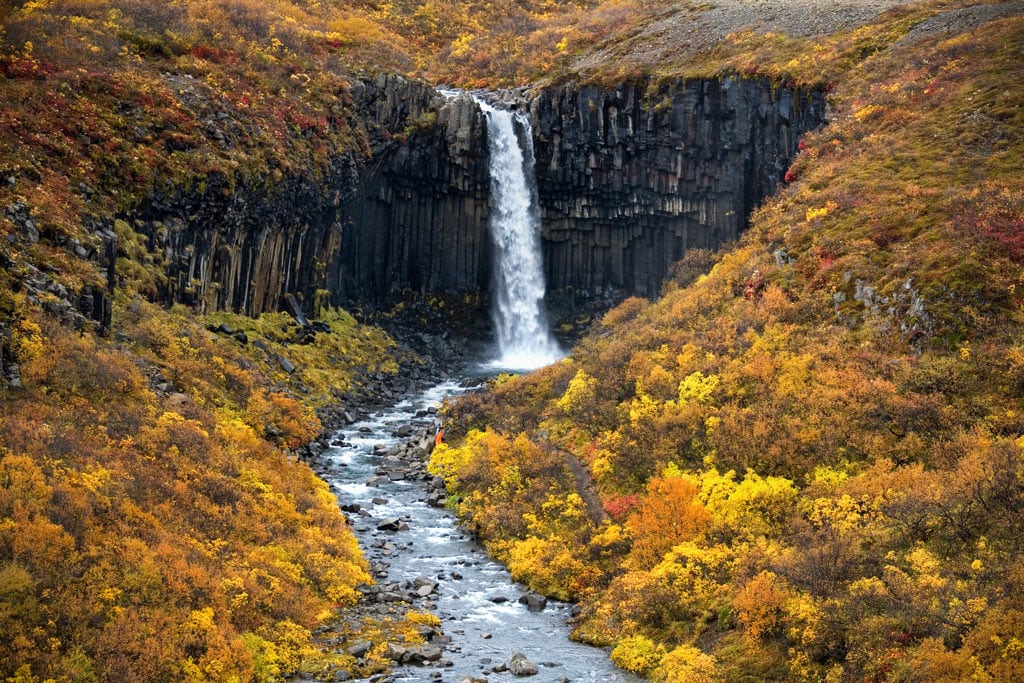
The summer months of June, July, and August make up Iceland’s peak travel season; this is the country’s busiest time for tourism.
The weather is the most pleasant in the summer, with the highest temperatures, mostly sunny and bright days, and the least chance of wind, rain, and storms.
There are more hours of daylight over the summer. In fact, it never fully goes dark, thanks to the famous Midnight Sun. The skies take on gorgeous shades of red, orange, purple, yellow, and pink at nighttime, and there’s enough light to be able to travel and even hike. Summer is the only period when visitors can sleep under canvas in tents, and it’s also the most appropriate time to travel around Iceland in a motorhome or camper van.
Summer offers the best driving conditions in Iceland. It is possible to reach the nation’s most remote corners by car, although some mountainous roads and destinations do still require the use of robust four-wheel-drive vehicles. Regular paved roads, including the Ring Road, are accessible by small cars and bicycles.
The summer is the prime time for hiking through Iceland’s amazing landscapes. The hiking trails are fully accessible, there’s lots of wildlife to spot, and the Highlands burst into bloom after the long, cold winter. You’ll spot creatures like reindeer, sheep, Icelandic horses, and Arctic foxes roaming around Iceland’s terrain, while whales and puffins are easy to spot near the coast.
Awesome summer activities include regular and glacier hiking, caving, and trying various water sports. There are plenty of sightseeing excursions too, along with a wealth of cultural events and music festivals.
The downsides of visiting Iceland in the summer are the prices, traffic, and crowds. Accommodations can be booked up far in advance and campsites can be crammed with tents and campervans, particularly places close to popular destinations and attractions. Well-known attractions can be incredibly busy, especially at peak times. There is little chance for spontaneity, as you must plan your trip in advance.
Summer is the most expensive time for an Iceland trip, with higher costs for accommodations, plane fares, and vehicle rentals.
Another disadvantage of a summer vacation in Iceland is that you cannot see the magnificent Northern Lights; the nights just aren’t dark enough. Additionally, almost all glacial ice caves are closed to visitors in the summer.

Iceland has a second peak season over winter—November to March . Lots of people visit Iceland to see stunning winter landscapes, spectacular ice caves, and frozen waterfalls in addition to the famous Northern Lights. There are terrific winter activities, like snowmobiling, to try too.
The long, dark nights are ideal for spotting the Northern Lights in all their glory. In fact, there are some 19 to 21 hours of darkness each day to watch for one of nature’s finest spectacles.
Iceland is full of festive cheer in December, and winter sees exciting firework displays and bonfires in the capital of Reykjavik.
Christmas and New Year aside, winter prices are usually lower than in the summer. It’s easier to find bargain flights, and you may also find cheaper accommodation. You won’t, however, be able to enjoy the cheapest accommodation option of camping, and touring by motorhome or campervan is also strongly discouraged.
Although popular, winter does see fewer visitors than in the summer, meaning that you don’t need to plan your vacation quite so far in advance, and you won’t get swallowed up in huge tourist crowds when visiting Iceland’s diverse attractions.
You may spot reindeer and horses outside over the winter, but you are unlikely to see much other wildlife. Whales and many bird species head south for the winter, and sheep are protected inside farm buildings.
A major drawback of winter is the weather. Winter is the coldest time of year, with strong winds and rain as well as many storms. There may be snow and ice too. Iceland’s roads can be difficult to drive in the winter, sometimes perilous, and there are lots of areas that are inaccessible with a regular car. The shorter hours of daylight also limit the amount of time people can realistically travel. December has the darkest days, gradually getting lighter, with March having more daylight than the depths of winter .

The Best Time to Visit Iceland
Iceland is a world of wonder at any time of the year, with terrific activities and fascinating sights all year round. That said, depending on your preferred experiences there may be a better time for you to visit. We’ve put together the most popular places, attractions, and activities and provided details of the best times to visit Iceland for each. This helps you plan your trip according to your wishes.
Summer experiences the best weather in Iceland. Between June and August is the perfect period for people who don’t like cold conditions and love warm, sunny days with little wind. July and August are the warmer months, but August does generally have more rain (usually in the second half of the month) than July. Conversely, June is the driest month but also the coldest.
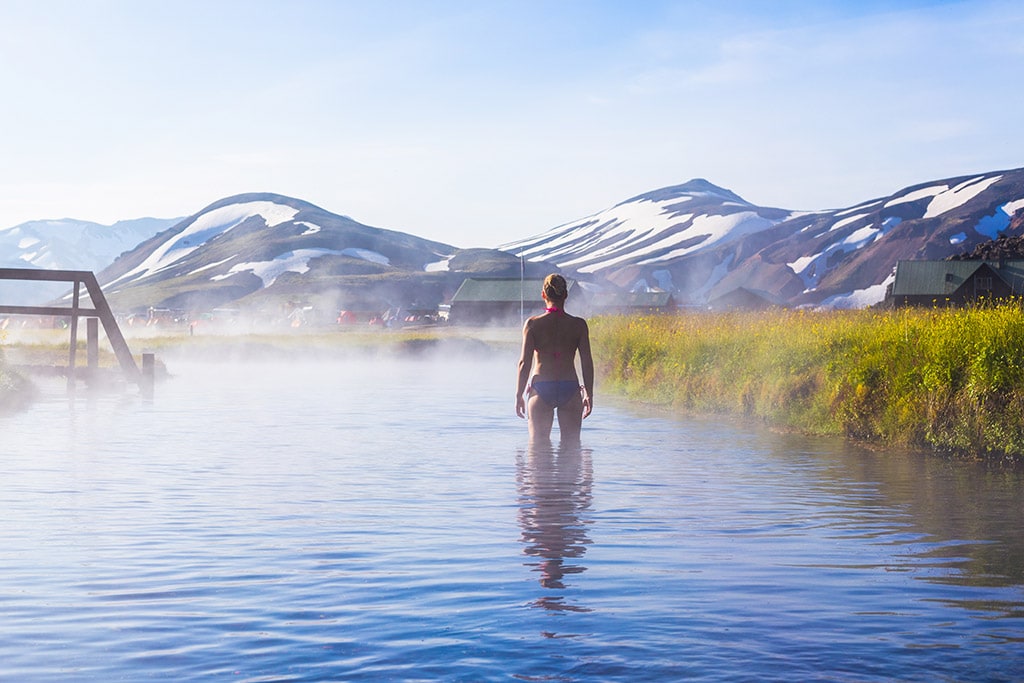
While there are light, bright nights between late April and mid-August, the height of the famous midnight sun is from May to July. The peak is on June 21st—the summer solstice, or the longest day.
Over summer the sun doesn’t dip down below the horizon enough for darkness to fully fall, meaning that it’s light (to a degree) all through the night. In good weather conditions the stunning hues of sunset and sunrise color the skies for many hours throughout the night. There couldn’t be a better time to enjoy the start and end of each day and to take beautiful photographs.
In the south and around Reykjavik the sun sets just enough for you to experience sunset, before quickly rising again with glorious sunrise tones. In the north of the island, however, there is no true sunset.

Many people visit Iceland with the primary intention of witnessing the awe-inspiring phenomenon that is the Northern Lights. Visible from late August to early April in Iceland, better weather conditions increase your chances of spotting the aurora. Regarding temperature, September and October are the mildest months. Of these two months, September is better when it comes to cloud cover and rain.
Even though the temperatures are colder, November and February are also good months for seeing the Northern Lights. The longer hours of darkness give more time to get out and try to spot the magical lights.
November and February usually have clearer skies than December and January due to the fact that they are drier with less precipitation. (September is, however, still the driest month during the Aurora-spotting season .)

There are many spectacular hiking trails through Iceland’s gorgeous mountains. Accessing these trails, however, really depends on the weather. As the weather is better in summer, with higher temperatures, drier conditions, and less wind, it follows that this is when you will find better trail conditions; the summer is, therefore, the best time to hike in Iceland. Furthermore, most of the country’s well-known hiking areas can only be accessed over the summer, particularly those in Highland areas.
Mountain hiking trails are typically at their best between late June and late August. You might be able to enjoy coastal hiking trails, however, between May and September. Hiking is strongly discouraged during the winter, for safety reasons. Only strongly experienced hikers should attempt to hike in Iceland over the winter, and crampons should always be used.
The most popular and most comfortable time for camping in Iceland is during the summer. Temperatures don’t fall below 0°C (32°F) over nighttimes. Wild camping isn’t legal in Iceland, but there are more than 200 official campsites spread across the island. Most are open from the middle of May until the end of September. Winter conditions are not suitable for camping in tents.
The road conditions are at their safest and best from May to October, making this the best time to explore Iceland by campervan or motorhome. Some campsites remain open all throughout the year to cater to people who need a place to park their vehicles and sleep during the winter. Traveling on Iceland’s roads during the winter can be tough for all vehicles, particularly larger vehicles like motorhomes and campervans; strong winds, snow, and ice can make winter driving in Iceland exceptionally hazardous and challenging.

Exploring Iceland is magical at any time of year, though the limited hours of daylight in the winter are an important consideration when planning your trip.
If you are planning to take a self-driving vacation, keep in mind that the best driving conditions are generally from May to October. Driving in Iceland in the winter is usually difficult, especially if you have no prior experience of handling a vehicle in wintery conditions.
Guided tours are available at all times of the year, and can access places that you may not be able to reach independently. You can travel safely and conveniently to beautiful destinations under the care of an experienced local guide. Sometimes, groups travel in vehicles that have been adapted for the terrain and the conditions.
When considering the best time to travel around Iceland’s famous Ring Road, think about the key things you wish to experience along your route. For example, are you keen to hike through nature and admire verdant landscapes and vibrant meadows filled with wild blooms, or are dazzling ice caves and frozen cascades more your thing? Midnight Sun or Northern Lights? Are you mainly interested in discovering the local heritage and culture? Perhaps you dream of relaxing in the warmth of charming guesthouses while you watch the snow falling and blanketing the ground outside? Your preferences will help you to decide the best time for you to travel around Iceland’s Ring Road.
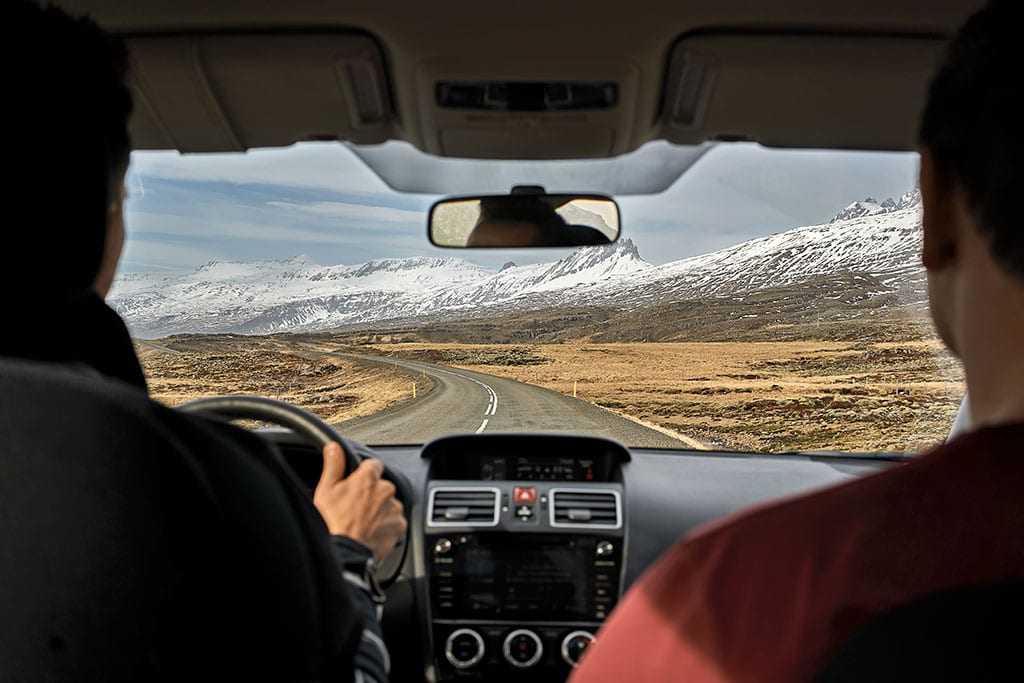
Although you can access Iceland’s most famous natural sites all throughout the year, the majority of visitors opt to experience them in the warmer summer months. This is when you’ll find the best weather and road conditions, but this also means that the roads have the most congestion and the attractions have the biggest crowds. If you prefer a quieter vibe with fewer people around, visit in the shoulder months of May or September.
If your time is limited in Iceland and you just have a few days’ vacation, the South Coast and Golden Circle are likely to be high on your travel wishlist. It’s possible to drive to these destinations at any time of year, though the weather means you’ll need to plan your trip(s) that bit more. The natural sites are stunning in the winter, although do keep in mind that they look different to in the summer.

It’s possible to spot whales all year round in the waters off Iceland’s coast. The best time to spot these magnificent sea creatures is over the summer. Migratory whales return to Iceland around the beginning of April. Although migratory whales depart again at the end of autumn, some whales, those who aren’t breeding, remain through the winter months too.
Female whales reach maturity in around five to seven years. When mature, whales breed once in every two to three years, and spend more than a year nursing their young. When not breeding, whales don’t need to make the long migratory journey and so remain in Icelandic waters.
Orcas (also known as killer whales), however, breed all throughout the year. Their migratory patterns depend on food supply. Since there are many fish, such as herring and capelin, in the cold winter waters, the distinctive black and white orcas are drawn to Icelandic waters to feed.
Especially great for nature lovers, you can watch beautiful sea creatures on a whale-watching trip . Head out to sea for a few hours to observe whales in nature. Northern Iceland’s Húsavík is a top spot for seeing whales in the wild, and Snæfellsnes (on Iceland’s northern peninsula) is a great place to see orcas.
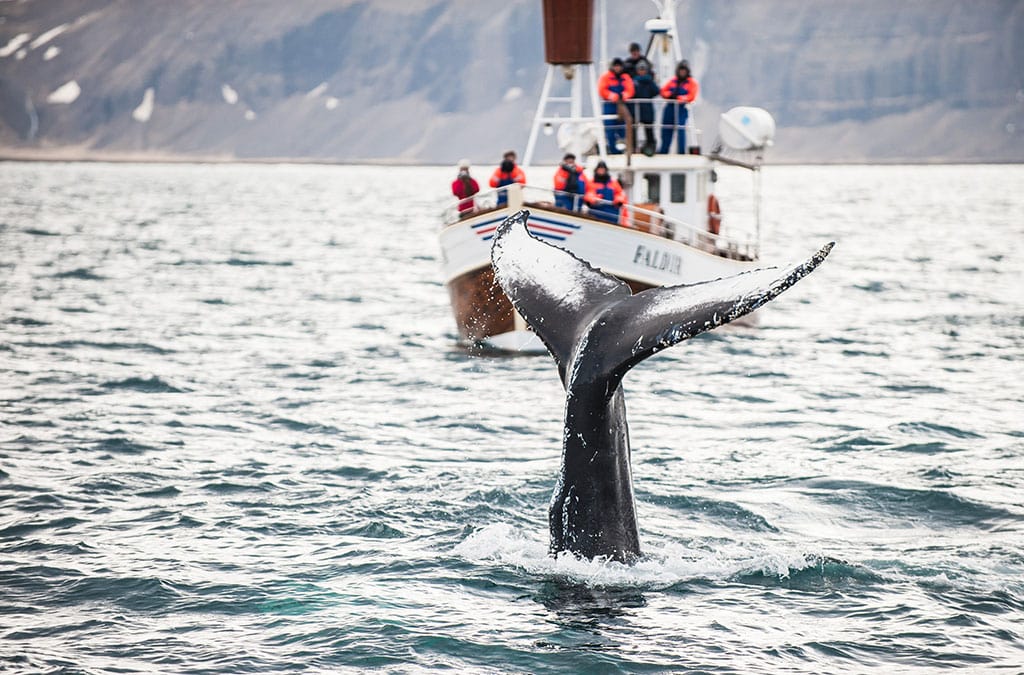
You can spot various bird species in Iceland throughout the year, including blackbirds, ducks, swans, oystercatchers, and gyrfalcons.
Many avian species are migratory, though, meaning they are only present in Iceland at certain times of the year. This naturally results in some months being better than others for birdwatching. Plus, if there are particular bird species that you’re keen to see you should plan your trip around when they are at their largest numbers in Iceland.
Migratory birds generally start to return to Iceland in April. If you wait until May, however, the numbers are greater and thus the chances of fruitful bird-watching experiences are higher. The numbers of migrating birds are highest from May until the middle of August. That said, the best time for birdwatching in Iceland is considered by enthusiasts and experts to be from the latter half of May and the first three weeks in June.
After the winter, the first bird to come back to Iceland’s shores is the golden plover. It makes its arrival towards the end of March, signaling the eagerly awaited arrival of spring. Known as the lóa in the native language, the golden plover is the county’s most celebrated type of bird. After the golden plover returns, other birds too start making their comeback, eventually, their warbling, tweeting, whistling, and chattering creating the enchanting natural summertime soundtrack. Most Icelanders know a catchy poem-cum-folk song about the birds’ return, which includes the message: “The golden plover has arrived to banish the snow, to banish the boredom, that it can do. … It has told me to wake up and work, and full of hope welcome the summer.”
Lots of visitors wish to see the famous Atlantic puffins around the coast of Iceland. The puffins return in April and are abundant through the summer. With around 8 to 10 million puffins calling Iceland home in the summer months, it’s little wonder that Iceland is sometimes referred to as the puffin capital of the world! Puffins leave Iceland in September, following most other species who depart around mid-August.

Iceland offers an exciting array of glacier activities, such as ice climbing, glacier hiking , and snowmobiling . As Iceland’s magnificent glaciers are accessible in all their beauty all year round, visitors can therefore enjoy incredible glacier adventures at all times. You will need to consider the weather, however, to make sure you dress appropriately for the conditions.
For hiking on glaciers and ice climbing, it is particularly important to ensure you dress for the conditions. You’ll be provided with all the necessary safety equipment, but you’ll wear your own clothes underneath. If you don’t have appropriate clothes though you can normally rent them from the tour companies. For snowmobiling adventures, you’ll be given gloves, a balaclava, and a helmet for both safety and warmth, as well as a protective overall to keep you warm and shield you from the wind and rain.
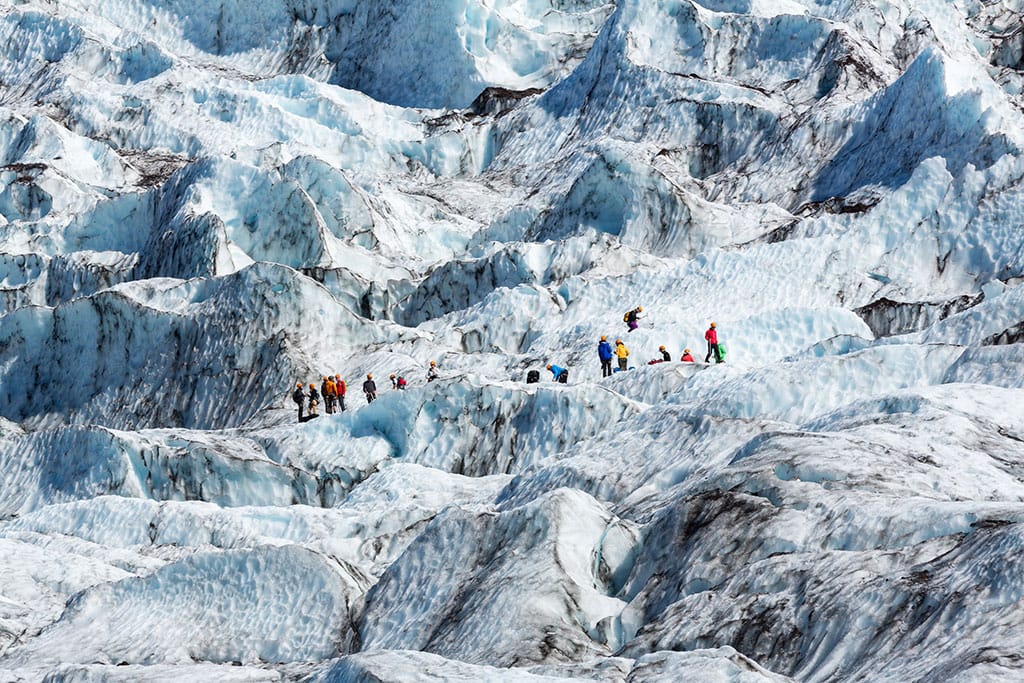
Winter is the best time to explore spectacular ice caves in all their ethereal beauty. Every October, tour companies go on scouting missions to find new caves, with tours starting up in early November. Iceland’s ice cave season runs from November until late March / early April (weather dependent). This is when it is safe to visit the country’s ice caves.
Throughout the five or so months of the ice cave season, some periods are better than others for adventures. Fewer tours are available in December and January, largely because of the limited hours of daylight.
As the days become lighter in February and March , more ice-caving tours operate. There are more hours of daylight to explore the ice caves and it’s a great time to get the best photographs of your adventures.
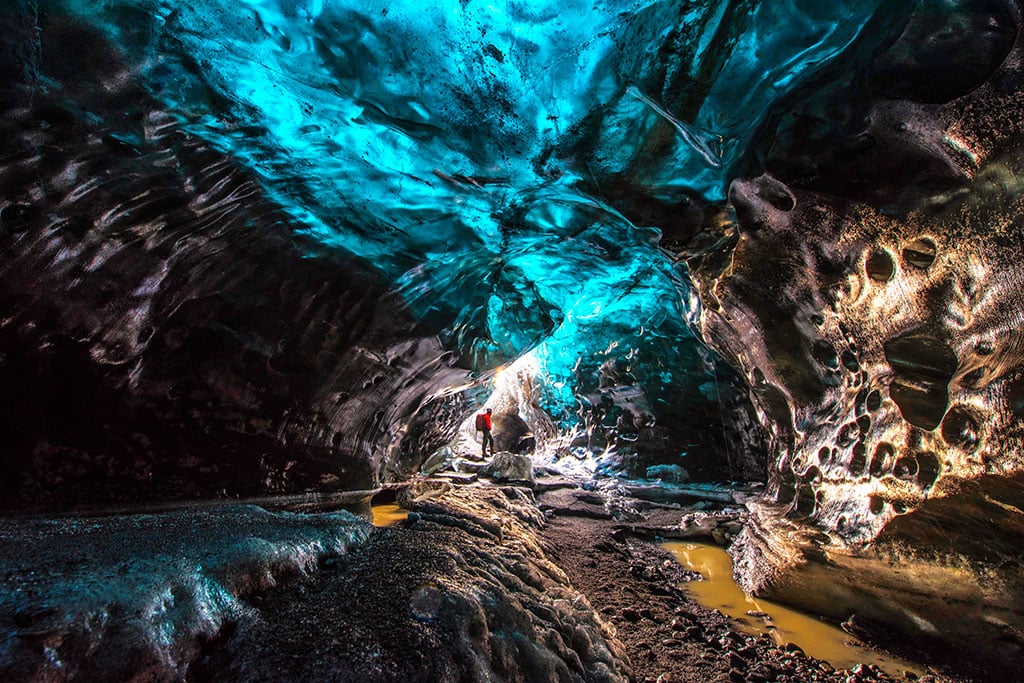
A family trip to Iceland will probably depend on existing time availability, such as holidays from work or school. There will probably be certain experiences that you’re keen to enjoy—you can look above for inspiration and ideas. For example, would your family prefer to experience the Northern lights or the midnight sun? Are you an active family that wants to spend time outdoors and spotting nature, or are you captivated by wintery landscapes?
Many families choose to visit Iceland in the summer, as this is when you will find the most child-friendly activities and things for people of all ages. The range of activities help to enhance any family vacation, providing educational and cultural understanding and education to complement and richen sightseeing around Iceland.
Driving around the island is one of the most convenient ways for families to fully make the most of their time in Iceland. Rent a car or book a self-driving package and discover Iceland at your leisure. You can choose which places to add to your itinerary, how long to spend at each place, where to stop to eat, when to take bathroom breaks, and so on. You’re completely in control of your holiday. Travelling at a slower pace is recommended for families, especially in the winter months when you’ll need to have some flexibility and may need to make last-minute changes to plans if roads are closed etc.

Iceland is the perfect romantic destination for a honeymoon. Lovebirds can explore the nation’s gorgeous landscapes, discover the creative culture, and enjoy a diverse selection of tours and activities.
While you might already have set your honeymoon dates if you are able to choose when to take your honeymoon we really recommend a visit in the low season. Prices are lower and there are much fewer crowds to interrupt your newly wedded bliss.
The best time for an Icelandic honeymoon, however, does largely depend on what you are expected to see and do.
Summer is lovely, with plenty of lush greenery and endless sunny days. On the flip side, it’s the busiest tourism time, with the highest prices and biggest crowds. Autumn is brilliant, with smaller crowds and lower prices, not to mention the possibility of witnessing the Northern Lights and attending cool music festivals.
Visiting Iceland in the winter can be really romantic, with the chance to make many magical memories of your first vacation as a married couple. Many major attractions are still accessible, but without the large crowds, and the snowy landscapes are enchanting. You can still spot the Northern Lights and then return to a cozy accommodation to relax and snuggle up.

In a nutshell, the more time you can spend in Iceland, the better! You can scratch the surface of Iceland’s famous attraction in a shorter trip of a few days, but you’ll truly get the most out of your holiday if you can stay for at least a week. With a week’s vacation, you can tick off the most popular places, enjoy typical activities like snowmobiling and hiking on a glacier, and take a relaxing dip in an enticing geothermal pool. And all at an unhurried pace.
With ten days or more you can travel more extensively around the island and visit some off-the-beaten-track gems and remote countryside treasures. This is a great way to get away from the masses and enjoy relative peace and quiet.
If you want to understand Iceland more like a local, plan to stay for at least two weeks … longer if possible. As well as headline attractions you can spend long days hiking in picturesque nature, stroll around lesser-visited seaside communities, marvel at remote fjords, and escape the tried-and-trodden path in places like the Eastfjords, Westfjords, and the north. There will be more opportunities to relish local cuisine, interact with locals, and learn more about the unique Icelandic culture.
Have you decided on the best time for your trip to Iceland? Or perhaps you’re still looking for a bit more guidance? In any case, contact our expert Iceland travel consultants to start the ball rolling in planning your amazing vacation.
- Share on Facebook
- Send in Messenger
Related Posts
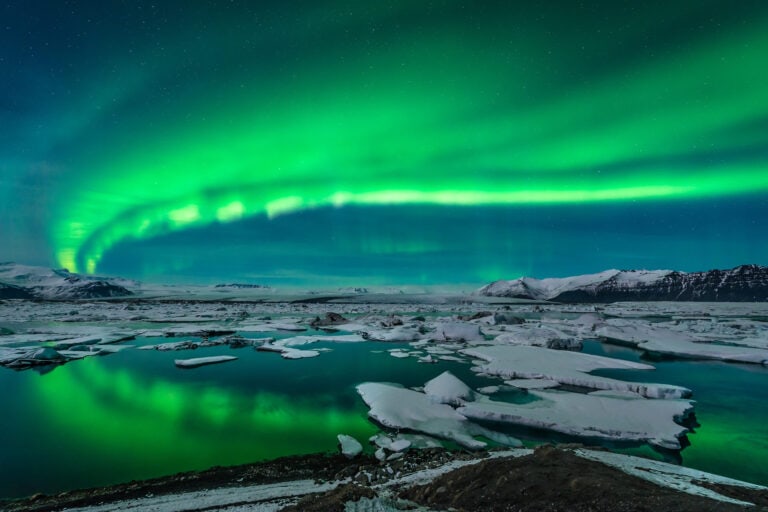
The Aurora Hunter’s Practical Guide to the Northern Lights in Iceland – 2024 Winter Edition
The Aurora Borealis is a magnificent natural phenomenon that lights up Iceland’s night skies for more than seven months of the year. The chance to

The Spa Lover’s Guide to Iceland: 9 Luxurious Geothermal Baths to Visit in 2024
Every visitor should add at least one geothermal spa to their itinerary. You can read below some of the best places to look at before deciding which one, or ones, are for you.
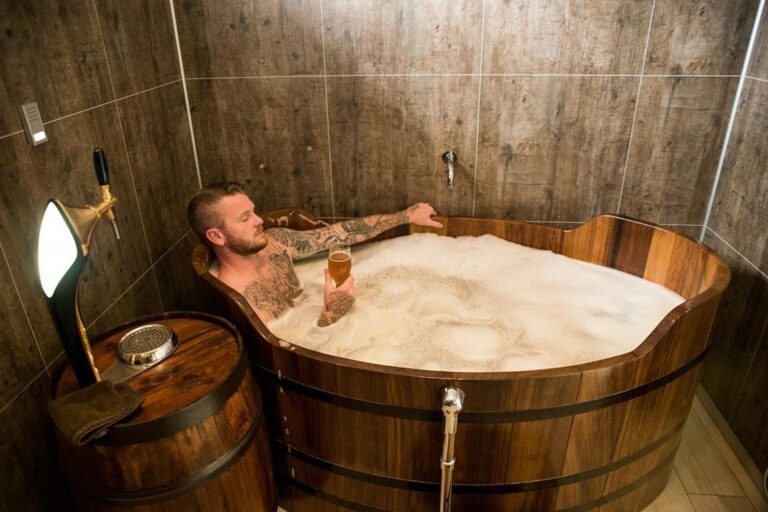
24 Unique Things to Try in Iceland in 2024
Iceland is considered by many to be the world’s most beautiful country. The wide variety of natural wonders available on a tiny island is unsurpassable.
Recent Blogs

13 Exciting Attractions to Visit on the Reykjanes Peninsula
Featured vacation packages, adventure-packed carbon neutral premium self-drive iceland tour – 8 day, sustainable iceland family adventure – 8-day co2 neutral self-drive tour, activity-filled co2 neutral self-drive tour – 5 days, action-filled luxury summer adventure, activity iceland by icelandia.
Authorized Tour Operator and Travel Agency certified by the Icelandic Tourist Board under the registered name Ferðaskrifstofa Kynnisferða, part of the Icelandia family .
- US/Canada: 1 (888) 642-8669
- International: (+354) 533 6003
- [email protected]
- Klettagarðar 12. 104 Reykjavík, Iceland
- Private Tours
- Vacation Packages
- Our Car Fleet
- Privacy Policy
- Terms & Conditions
- Environmental Policy
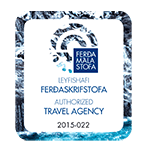
Tours offered on this website are sold under the license of Ferðaskrifstofa Kynnisferða.
© All rights reserved
Special offer
For a limited time on selected super jeep tours.

The Best Guide to Whale Watching in Iceland

Whales of Iceland
- Minke Whales
Humpback Whales
- White-Beaked Dolphins
- Harbor Porpoises
Blue Whale and Fin Whale
Sperm whales, beluga whales and narwhals, long-finned pilot whale, what are the best whale watching tours in iceland, reykjavik whale watching tour, husavik whale watching tour, akureyri whale watching tour, hauganes whale watching tour, olafsvik whale watching tour, when is the best time for whale watching in iceland, whale watching in iceland in summer, whale watching in iceland in winter, should you experience iceland whale watching during summer or winter, where is the best place for whale watching in iceland, reykjavik whale watching, whale watching in north iceland, whale watching from the snaefellsnes peninsula, the verdict, whales in icelandic folklore and sagas, keiko the killer whale, commercial whaling in iceland.
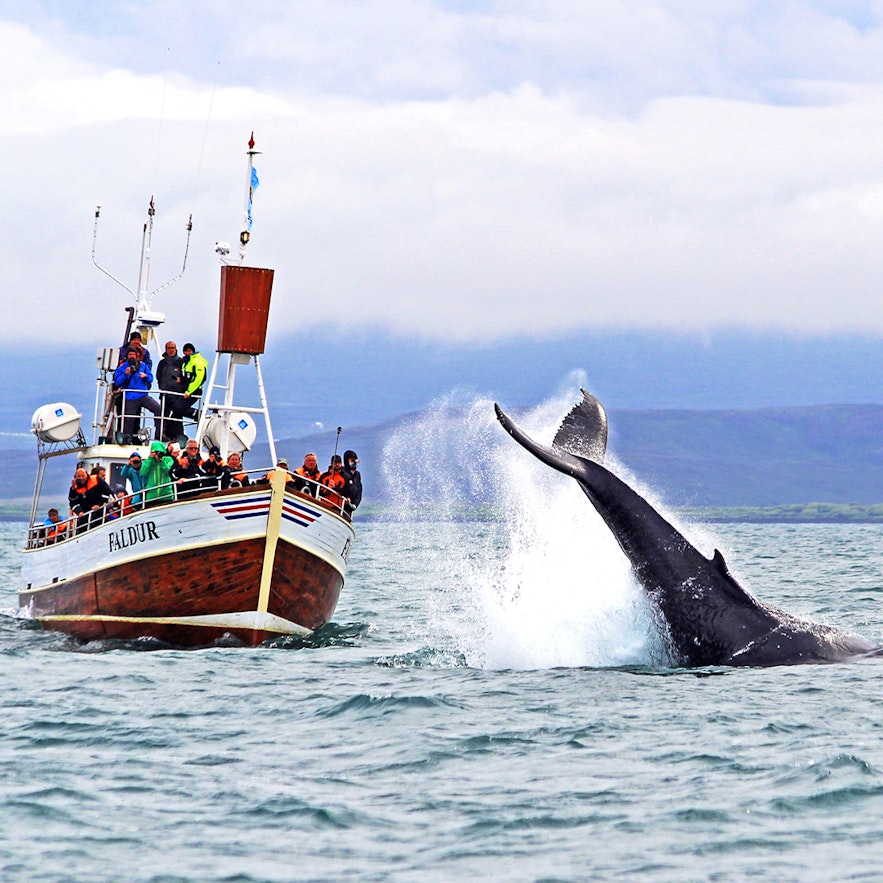
Discover why whale watching in Iceland has become a popular activity over the last two decades. When is the best time to see whales in Iceland? Where can you go whale watching? Read on and get the answers to everything you need to know about whale-watching in Iceland!
Spotting these gentle giants of the sea is a great way to spend a day in Iceland, whether you're in Reykjavik or out in the country. If you're planning on staying in the city, book a hotel in Reykjavik and rent a car in Iceland to get around the country easily. There is a wide selection of whale watching tours to choose from, so you're sure to find the right one for you.
Top Whale Watching & Puffin Tours
The reykjavik whale watching tour, family-run husavík whale watching tour, whale watching tour with transfer from akureyri.
Whales have been a significant part of Iceland's history since its settlement in the late 9th century. As an example of that, the Icelandic word for a stroke of good luck is 'hvalreki', which translates literally to 'beached whale'.
Whaling was also practiced for centuries in Iceland alongside fishing. Today, the ocean's gentle giants are seen more as something to appreciate from afar. Whale watching is essential to any Iceland trip, just like seeing the northern lights , hot springs , and glaciers .
Here you can catch whales splashing around under the northern lights or illuminated by the midnight sun , depending on what time of year you visit. Whale watching from Reykjavik is easily accessible, just a short walk from the city center, making it an easy activity to do despite a busy itinerary. There are also towns and villages throughout the country that offer whale watching, so there are plenty of options to choose from.
Abundant summer daylight combined with a unique mixture of cold and warm sea currents makes the Icelandic territorial waters home to a wide variety of krill and fish.
As a result, Iceland is a bountiful feeding ground that attracts 24 different whale species, from the enormous sperm whale to the diminutive harbor porpoise.
The chances of spotting specific types of whales on a whale-watching trip vary depending on the port of departure. However, the minke whale is the most commonly sighted animal and can be seen all around Iceland throughout the year.
Below is a list of the most common species found on whale-watching tours in Iceland, followed by honorable mentions of some of the rare species.
Minke Whales
Minke whales are the most common whales found in Iceland’s waters, with many migrating here throughout summer and a few lingering through the winter months.
They're small compared to other species but can still exceed 30 feet (9 meters) in length. Their behavior is usually rather shy, but due to their numbers, you can regularly see them from almost all whale-watching ports, including Reykjavik.
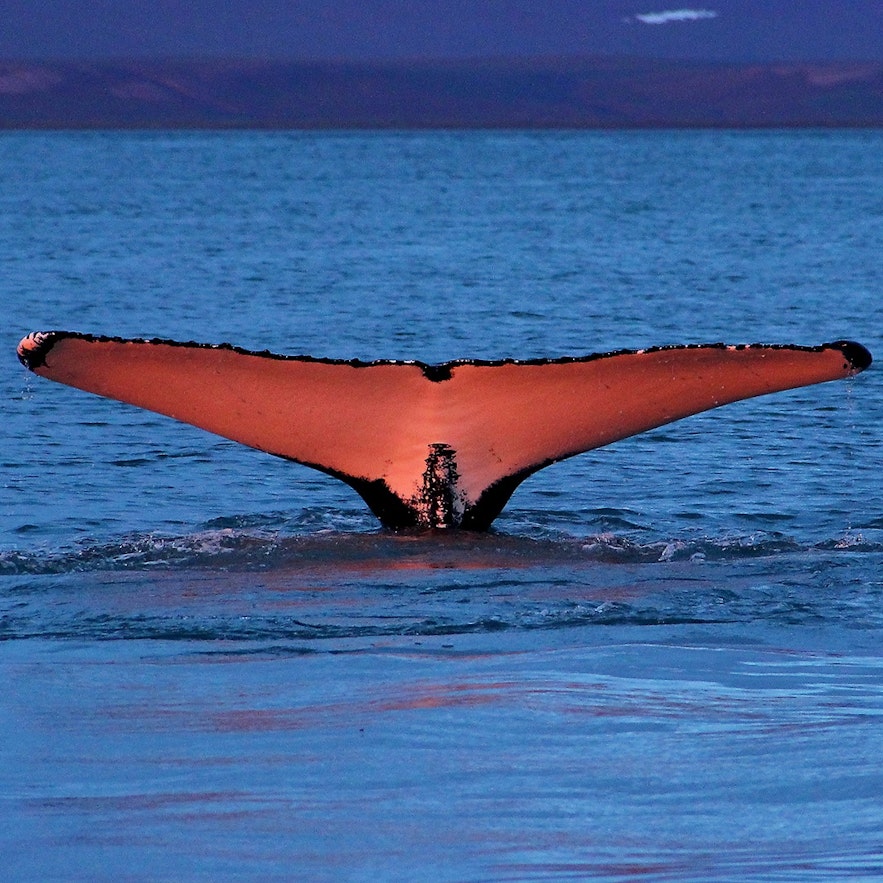
Humpback whales can be seen in Iceland during the summer months.
Unlike minke whales, humpbacks are renowned for their gregarious and acrobatic behavior. You could say that humpback whales are the attention-seeking divas of the whale world.
They are a common sight on whale-watching tours, breaching, feeding, or slapping their tails and flukes.
Tour operators from northern towns, such as Akureyri and Husavik , have had seasons in which they have spotted at least one humpback on every excursion

White-Beaked Dolphins
White-beaked dolphins are the most commonly seen dolphin around Iceland, staying close to the shore throughout the year.
They live in pods ranging from a few individuals to a hundred, and, though a bulky species, you can often see them bow-riding, breaching, and playing at the surface.
Not only can you see these dolphins swimming in Iceland's waters, but they can also be seen on the Icelandic 5 krona coin. So if you're lucky enough to see them on your whale-watching tour, you can keep the coin as a (rather cheap) souvenir.
Harbor Porpoises
The adorable harbor porpoise is one of the smallest whale species. It can be seen widely in Iceland's waters throughout the year. However, you might need someone with a trained eye to point them out.
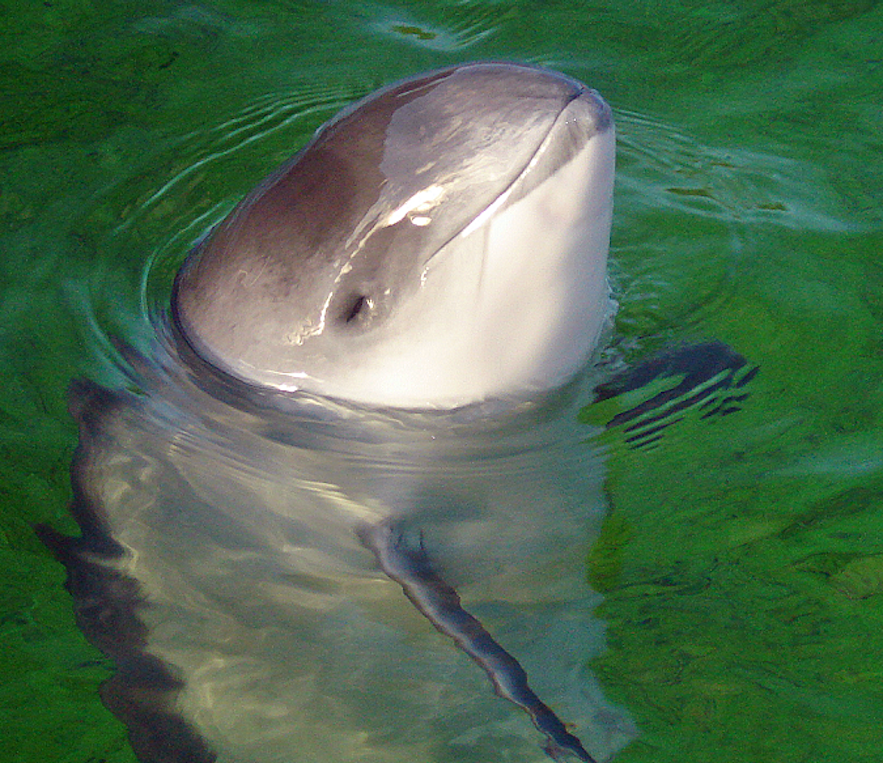
Photo from Wikimedia Commons Library. No edits made.
They're small and shy and usually only appear at the surface, alone or in small groups, for moments at a time. When feeding or threatened, they can race across the surface while splashing their tail, in a behavior known as roosting. It's a dramatic and eye-catching display and would make any whale-watching trip memorable.
Orcas
Despite being called killer whales, orcas are the world’s largest dolphin species, and about 5,000 of them live around Iceland throughout the year, coming closer to the shore during the summer months.
Orcas can appear on whale-watching trips but are not as easy to find as other species due to their transient nature. However, their great size and occasional acrobatic behavior make them a favorite among whale watchers.
Orcas, sometimes called the "wolves of the sea", are voracious eaters and require 400 to 750 pounds (175 to 350 kg) of food every day. In Iceland's waters, they mainly feed on herring and capelin. But they are also known to eat salmon, turtle, shark, and even their fellow sea mammals such as dolphins, seals or porpoises.
If you're eager to go orca watching in Iceland, they're most commonly seen in the East Fjords ' rich herring grounds, around the Snaefellsnes Peninsula , and along the South Coast .
Orcas are especially beloved in Iceland because of a certain well-known orca individual that was born in Iceland's waters and later became a star of the silver screen! More on that famous whale later in the article.
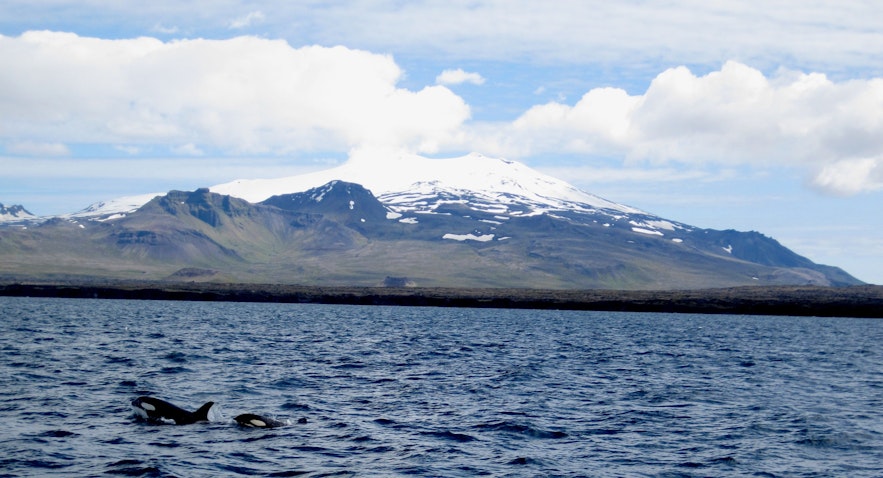
The species above are the ones most commonly seen on a whale-watching tour in Iceland. However, a wide array of Icelandic whales can occasionally be spotted in the island's waters. Below is a list of other species that the most fortunate will have the opportunity to see.
Humpback and minke whales may be the most common baleen whales, but they are not the only ones that can be seen swimming in Iceland's waters.
The two most enormous creatures ever to live on Earth, blue whales and fin whales, can also be seen throughout the summer months, although rarely.
Blue whales can reach a length of 100 feet (30 meters) and a weight of 165 tons (150 tonnes). Despite their massive size, they feed almost exclusively on krill. Interestingly, their lifespan is similar to that of humans, with individuals reaching an average age of 80 to 90 years.
Fin whales are the second largest animals on Earth, behind only the aforementioned blue whales. On average, they have a size of 65 feet (20 meters) and weigh 40-50 tons. They are more commonly seen around Iceland than the blue whale, with an estimated 30,000 to 40,000 individuals living in the North Atlantic Ocean.
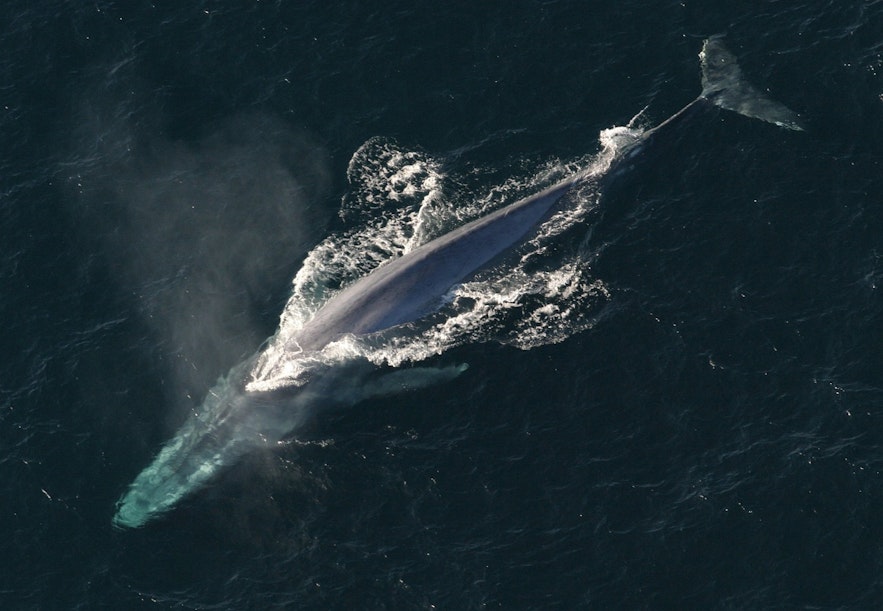
Sightings of the largest toothed whale, the mighty sperm whale, are not uncommon off Iceland’s West Coast in spring and summer. There are estimated to be about 23,000 individuals in the sea around Iceland and the Faroe Islands.
Despite the relatively large size of its population, they are rarely spotted since they can hold their breath for an extraordinarily long time. At its longest, the sperm whale can hold its breath for up to two hours and therefore only needs to reach the surface to breathe once or twice during the entire length of a whale-watching tour in Iceland.
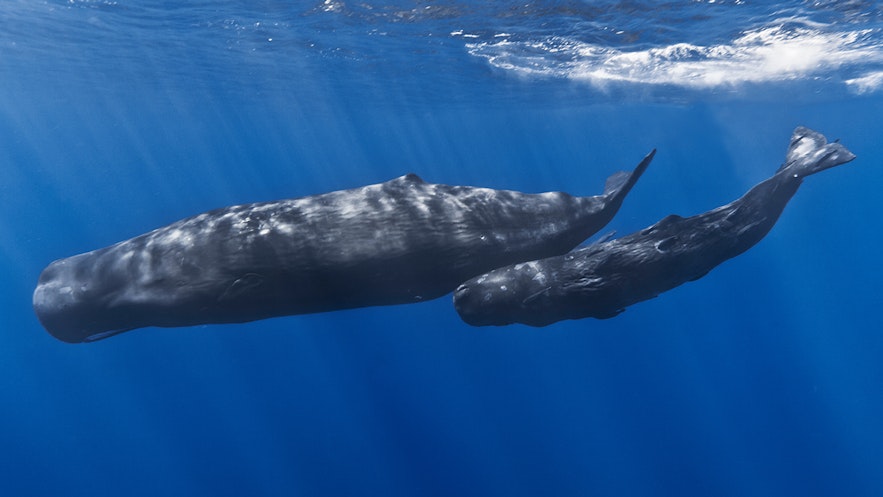
Photo by Gabriel Barathieu from Wikimedia Commons Library . No edits made.
In the northern waters, groups of belugas and narwhals have occasionally been spotted as stragglers. While their usual habitat is around Greenland, within the Arctic Circle.
Narwhals are famous for the male's tusk, which is, in fact, a long canine tooth. The long tusk is not necessary for survival and serves a similar purpose to the antlers of a stag or the feathers of a peacock, as an assessment of hierarchical status.

Photo from Wikimedia Commons Library . No edits were made.
Beluga whales are closely related to narwhals and belong to the same family of whales. Similarly to narwhals, beluga whales spotted in Iceland are stragglers as their natural habitat is further north in the Arctic Circle.
The Westman Islands are home to the world's first beluga whale sanctuary , where visitors can meet two female whales: Little White and Little Grey, in their new home in Klettsvik Bay.
Despite its name, pilot whales are actually a species of large dolphins. They are noticeable for their unusually long pectoral fins.
There are estimated to be about 350,000 individuals in the North Atlantic alone. However, they are a very transient species that spend most of their time offshore, so they are not seen in Iceland's waters as much as one might expect.

We advise you to check out this list of whale-watching tours to see all of the current options. You’ll be able to choose your tour from various vessels, ranging from traditional Icelandic oak boats to modern RIB speedboats, and tours lasting from a couple of hours to whole days.

The puffin breeds in large colonies on offshore islands and coastal cliffs, and therefore some tours include puffin watching . So you can check two things off your must-see list at once.
Below is a list of the most affordable Iceland whale-watching tours, sailing from the country’s main whale-watching ports.
- Whale Watching Tour from Reykjavik
- Price: about 87 USD
- Chances of seeing a whale: 99 percent
- Availability: all year
- Common species: minke and humpback whale, whale-beaked dolphins, and harbor porpoise
- Husavik Traditional Whale Watching
- Price: about 76 USD
- Availability: April to November
- Common species: humpback whales, minke whales, blue whales, and white-beaked dolphins
- Akureyri Whale Watching by Eyjafjord
- Chances of seeing a whale: 95 percent
- Common species: humpback and minke whale, harbor porpoise, and white-beaked dolphin
- Whale Watching and Sea Angling
- Price: about 75 USD
- Availability: April to December
- Whale Watching on the Snaefellsnes Peninsula
- Price: about 74 USD
- Availability: April to October
- Common species: orcas, minke whales, harbor porpoises, white-beaked dolphins, and humpback whales
You can enjoy whale-watching tours throughout the year, but depending on the whale-watching season, the experience can differ.
There are advantages to Iceland whale watching in summer over winter, and visa-versa, that you should consider before booking your trip. Let us break it down for you.

With calmer winds, fewer storms, and clearer skies, not only are whale-watching tours less likely to be canceled, but your chances of seeing cetaceans breaking the flat surface of the water are much higher.
Furthermore, standing on the deck for the tour's duration is more comfortable and a lot more enjoyable.
However, the balmier weather is not the only reason whale watching in summer has advantages over whale watching in winter. The second main draw is the greater diversity of marine life.
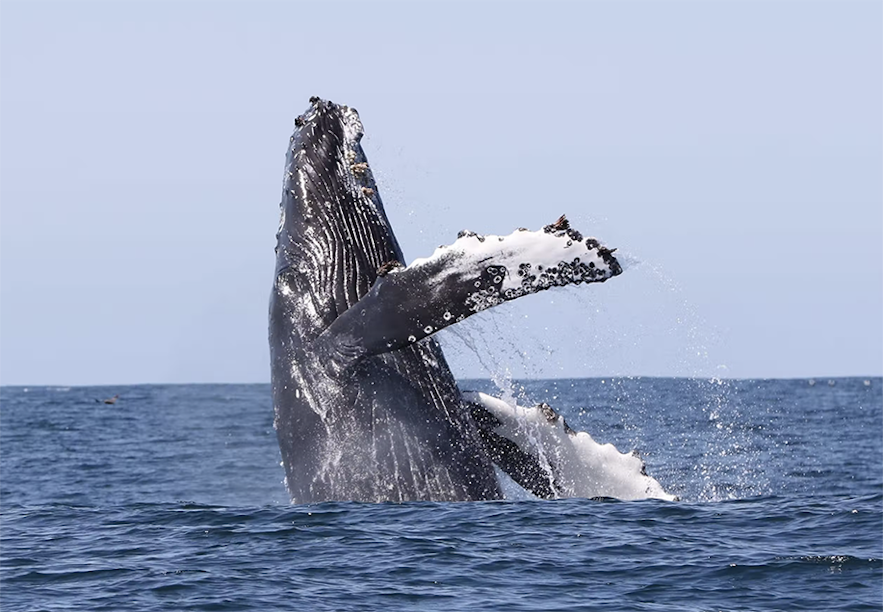
As a result, between April and October, you can expect to see some of the world's largest creatures on your whale-watching tour in Iceland.
No matter the port you leave from in summer, you have an excellent chance of seeing minke and humpback whales.
It’s also worth noting that the white-beaked dolphins and harbor porpoises that frequent Iceland’s waters year-round are just as common in the summer months.
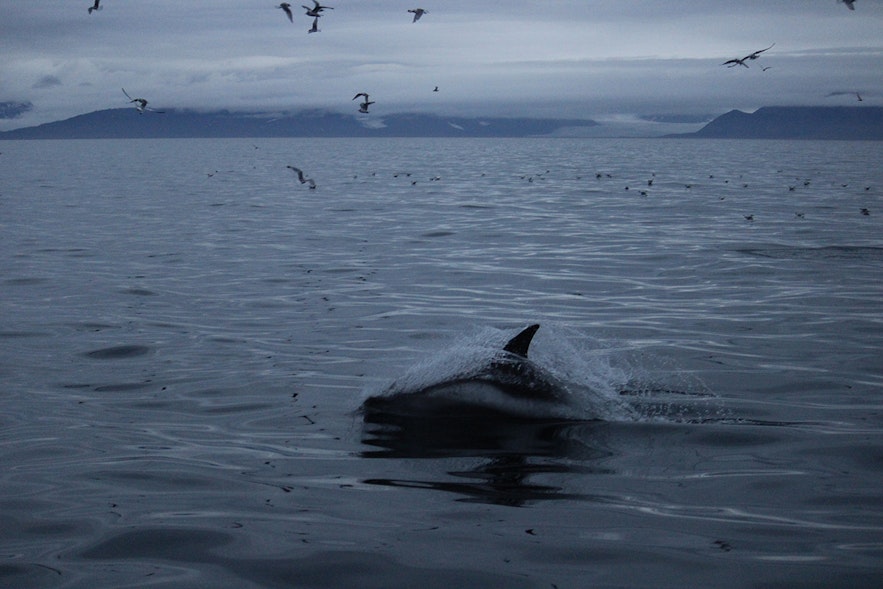
Photo from Wikimedia Commons Library . No edits made.
Though they prefer deeper water than those in Faxafloi Bay , sperm whales and northern bottlenose whales are also more commonly found in Iceland in summer.
You can often see sperm whales in Breidafjordur Bay , where the water is deep enough for them to hunt. Northern bottlenose whales are more randomly distributed offshore but occasionally come into shallower seas when pursuing prey.
However, these are not the only whale species that come to Iceland in summer and make each whale-watching tour that much more spectacular.
Basking sharks, the second-largest fish species, can also be found cruising near the surface occasionally during this season.
These enormous, prehistoric creatures move slowly and have a very calm nature, meaning sightings often last longer than with the whales, who dive to feed.
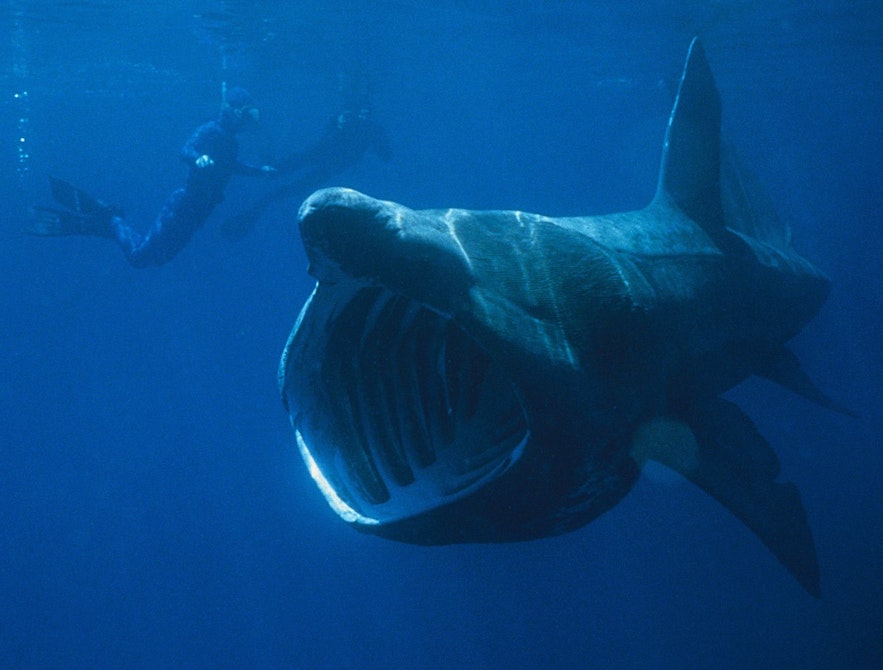
In addition to whales, you can see birds such as arctic terns, great skuas, and puffins on tours from Reykjavik, Akureyri , Husavik, and the Snaefellsnes peninsula . They're frequently spotted bobbing on the water's surface, circling overhead, or diving for fish.
Another advantage of whale watching in the summer is that you can partake in a smaller vessel such as a RIB for a much closer, more personal encounter. The best option for a RIB boat whale-watching tour is from Reykjavik .
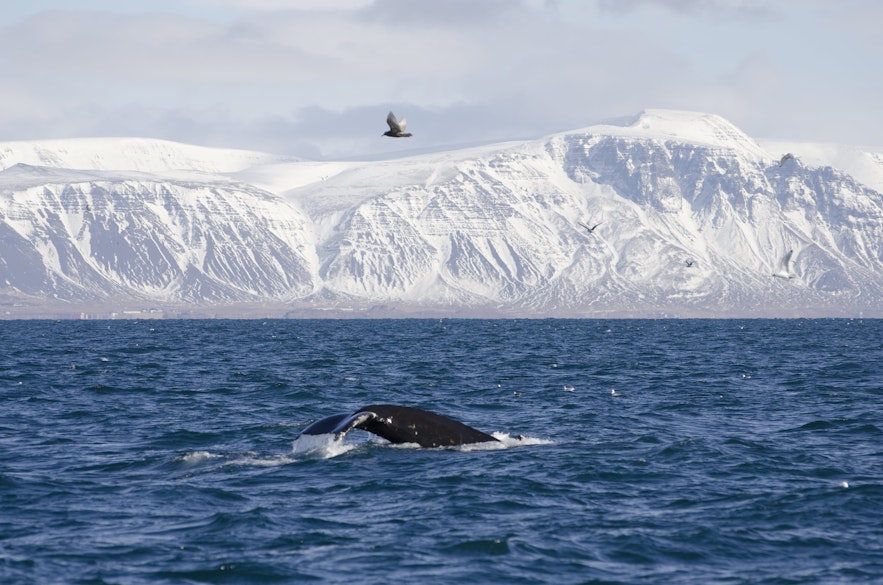
Despite the many advantages of summer whale-watching tours, going whale-watching in the winter also has its benefits.
First, winter whale-watching tours are much less busy. The summers are high-season for the number of visitors in Iceland, making whale watching in the winter less crowded.
If you don't mind bracing cold winter conditions, you are likely to have a lot more space to search for sea mammals and spot them from the viewing deck when they do appear.

Regarding the cetaceans you’ll see on winter whale-watching tours, the most common are white-beaked dolphins and harbor porpoises.
However, it's not unheard of for great whales to occasionally linger throughout winter, so it’s reasonable to hope to see minke whales and occasionally humpbacks.
The second advantage of whale watching in winter applies solely to whale watching in certain areas. Breidafjordur bay , between the Westfjords and Snaefellsnes peninsula , is a herring wintering ground, and the abundance of food attracts many predators.
The apex predator of the ocean around Iceland, the orca, is, therefore, more common to see in Breidafjordur in the winter rather than in the summer.
The herring in Breidafjordur also means that humpbacks who linger throughout winter will often congregate there.
Meanwhile, in North Iceland , you are far more likely to see belugas than you would be during summer.
While these curious, gregarious animals are common in Iceland's waters and only come here by chance, this occurs when they have migrated away from the Arctic into waters with less ice.
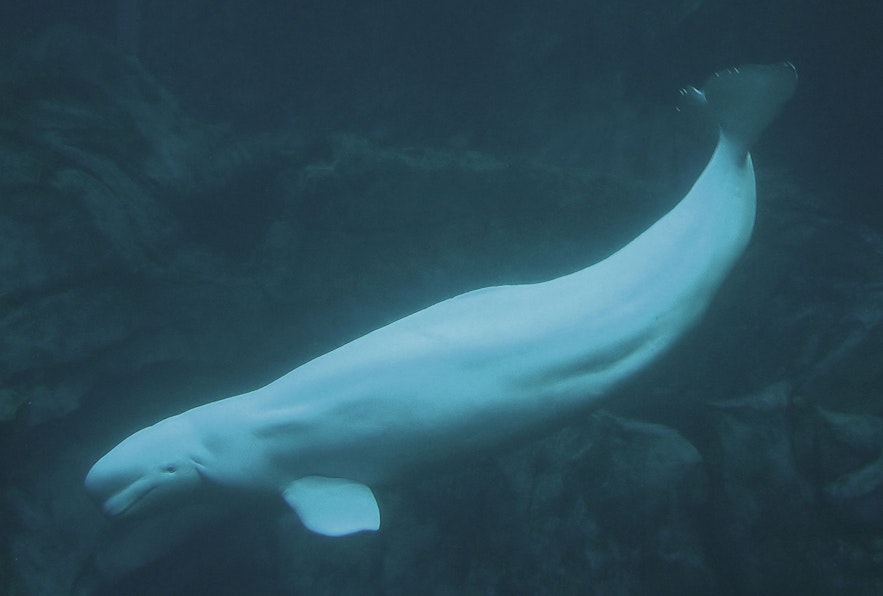
A final advantage of whale watching in winter is that it allows you to experience some incredible nature, regardless of the wildlife you may encounter.
Searching for whales in Iceland while surrounded by the snowy mountains of Eyjafjordur fjord , for example, makes the scene even more spectacular and will make the sighting of a whale all the more dramatic.
There’s also the slight chance to see the northern lights on a winter whale-watching tour, which would undeniably be an unforgettable experience.
Wondering when you can see whales in Iceland? Whale watching is usually more enjoyable, successful, and rewarding during summer.
The exception to this is on tours from the Snaefellsnes Peninsula due to the success rates of seeing orcas.
Regardless, excursions go on throughout the year for a good reason. Iceland has an abundance of cetaceans you can reliably see, irrespective of the whale-watching season. So, whichever season you travel in, you’ll have a wonderful Iceland experience.
The time of year you decide to go whale watching and the port you choose to depart from on a whale watching tour will affect what you see.
Different species frequent different areas, so if you seek to see a particular animal, you should be aware of the best places in Iceland to go.
Seeing the whales and dolphins of Iceland is a mesmerizing and rewarding experience, and there are a wealth of places from which to do it.
The town of Husavik in North Iceland is dubbed “the whale-watching capital of Europe,” but there are plenty of other places to take a whale-watching tour.
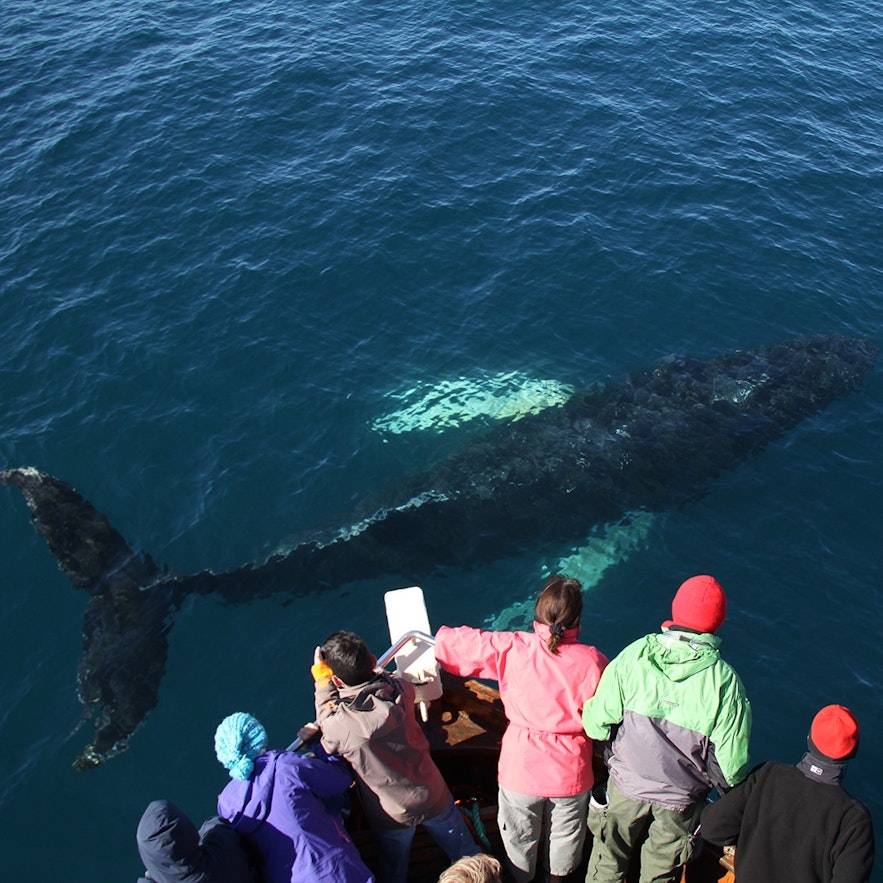
Which location to choose for your tour depends on your expectations. On the most affordable whale-watching trip departing from Reykjavik , the most commonly spotted animals are minke whales, white-beaked dolphins, and harbor porpoises. The chances of seeing humpback whales are much higher on a Husavik whale-watching trip in Skjalfandi Bay in North Iceland .
If you stay in Iceland's capital city, embarking from Reykjavik’s Old Harbor is the easiest option.
The usual departure point is within easy walking distance from most downtown hotels. As tours tend to last three hours or less, they allow you to enjoy an incredible experience without taking up a decent chunk of your day.
This length also means that if a tour is canceled due to inclement weather or if you didn’t see any whales, you might be permitted to join another tour for free. This arrangement is unlikely to mess up any other plans for those staying in the capital.

The convenience of whale watching in Faxafloi bay is undoubtedly part of its appeal, but it’s not the only lure. In clear weather, you should be able to see a vast amount of iconic Icelandic sites on a tour from Reykjavik.
To the south, you’ll see the cone-shaped volcanoes that line the barren Reykjanes peninsula . Whereas to the north, it’s often possible to see Snaefellsjokull glacier in the distance.
Furthermore, Faxafloi is a reliable place to find white-beaked dolphins, harbor porpoises, and minke whales throughout the year.
In summer, humpbacks are common, and because they nest in the thousands on the islands of Lundey and Akurey , you can spot puffins on almost every outing.

North Iceland whale-watching tours that leave from Akureyri and Husavik into Eyjafjordur and Skjalfandi Bay, respectively, have the highest success rates in Iceland. Tour operators from both locations experience sightings on 100 percent of tours in summer.
In summer and from these destinations, the main appeal is humpback whales. The wealth of food in the cold northern waters draws them into the fjords, the depths of which still allow them to dive to hunt.
However, humpback whales are not the only common species. As with the rest of the country, harbor porpoises and white-beaked dolphins also frequent the waters.
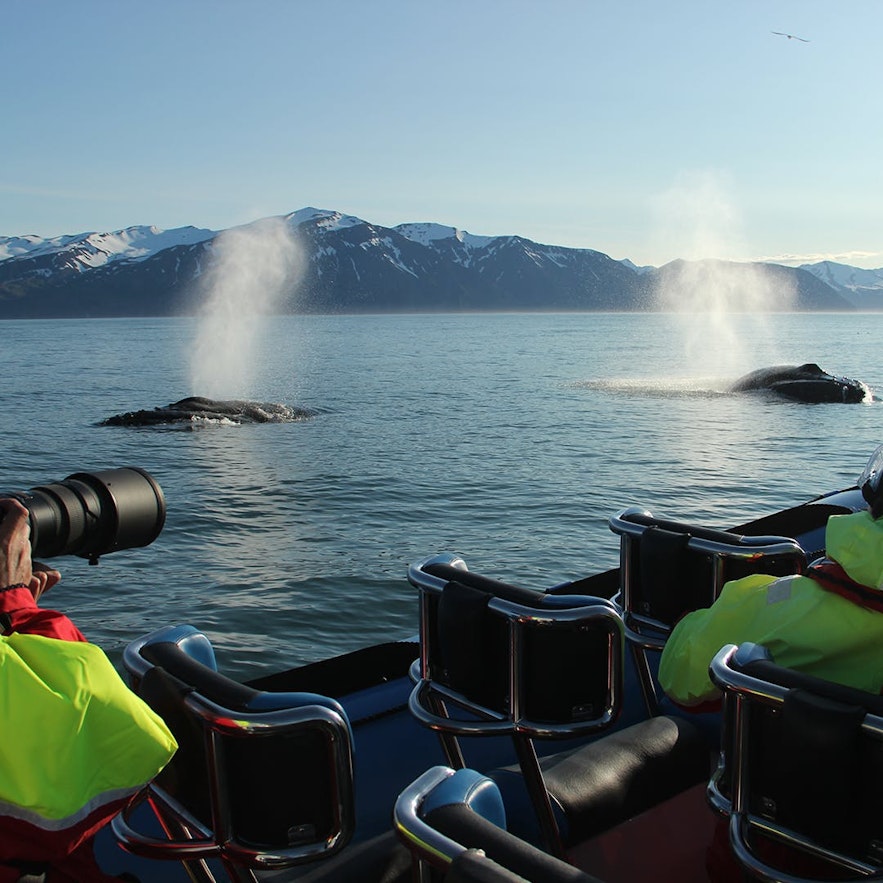
North Iceland is also the best place for your chance of spotting some of the lesser-seen whales.
Blue and fin whales also come there seeking food, although rarely, so do stray beaked whales, narwhals, and belugas.
All 24 species of cetacean you can find in Iceland’s waters have been seen in the north, something no other part of the country can claim.
The difference between whale watching in Akureyri and Husavik is slight but exists.
Skjalfandi has a higher number of cetaceans than Eyjafjordur. Having a higher number of animals means more chances of sightings and watching exciting behaviors such as breaching, fluking, tail-slapping, and spy-hopping.
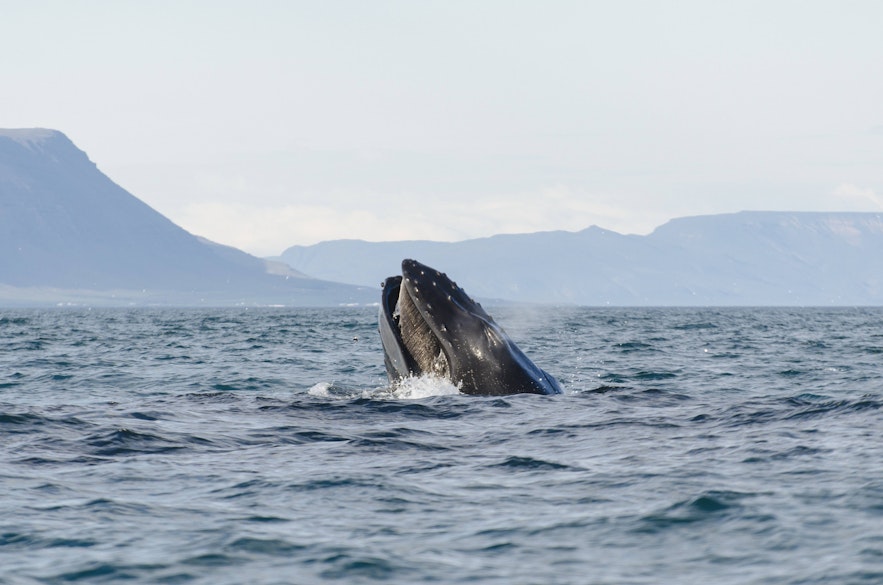
Meanwhile, Akureyri is simply a more convenient place to go whale spotting. It's the largest town outside of the greater Reykjavik area , meaning it has more activities and sites you can fill your day with when your whale watch is complete.
That being said, Husavik’s services have grown with the rising number of visitors over the past decade, so this difference may soon become negligible.
Puffins and other seabirds can be seen on tours from both Akureyri and Husavik, as they nest in the cliffs around Eyjafjordur and on the islands in Skjalfandi.
The Snaefellsnes Peninsula is better known for its excellent sites on land than for its sea life, but avid whale watchers will find it a hidden gem.
Tours leaving from Grundafjordur take you into Breidafjordur , which, as mentioned, is a wintering herring ground that attracts dolphins, porpoises, humpback whales, and, most uniquely, orcas.
Orcas live all around Iceland but tend to be transient. They move where the food goes. Therefore, they're rarely seen in other parts of the country, particularly in Faxafloi Bay.
While you can see them most commonly in winter, Breidafjordur is also well worth visiting in summer, as it's the best place in the country to find sperm whales.

Though these animals are abundant around Iceland, they tend to hunt offshore; they are rarely seen. However, it should be noted that even in Breidafjordur, this is not a common occurrence.
The best whale watching in Iceland is undoubtedly out of Husavik. That being said, each whale-watching port has unique factors that may override the quality of the whale-watching experience in Husavik .
For location and time management, considering most people joining whale-watching tours are on holiday and want to pack in as many different activities each day as possible, Reykjavik and Akureyri are more convenient.
For avid whale watchers who want to see less commonly spotted animals around the world, then a tour from the Snaefellsnes peninsula wins out.
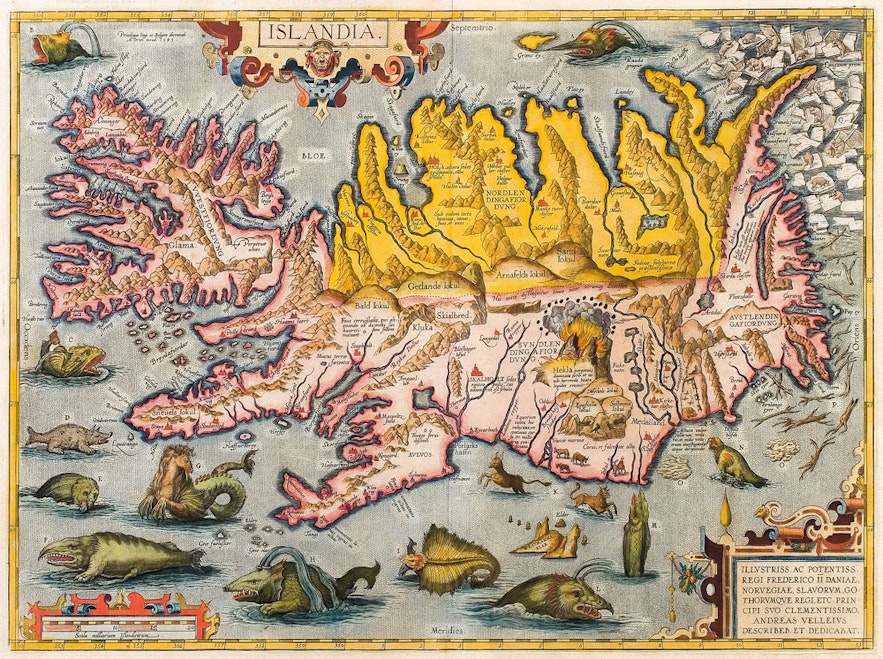
Throughout Iceland's history, whales had, in some cases, positive connotations, such as the Icelandic word for a stroke of good luck, 'hvalreki', literally translating to 'beached whale'.
That's because, in the harsh conditions of medieval Iceland, where food was hard to come by, a beached whale was incredibly fortunate as it meant an abundance of food that could last throughout the winter.
In other cases, they were considered terrifying creatures with many folkloric stories surrounding menace.
The map above shows 16th-century depictions of the many sea creatures thought to live in Iceland's waters. Interestingly, each creature is marked with a letter from the alphabet, corresponding to a compendium that details information about the creature. Some of these creatures are actually well-known whale species we've covered in this article.
For example, the creature marked L is supposed to be a blue whale, while the creature marked C depicts a sperm whale. Obviously, these are not anatomically correct illustrations, but it indicates that folklore about menacing sea monsters has an inkling of truth in them.
In Icelandic folklore, exist many stories of so-called 'illhveli', which literally translates to 'evil whale'. These whales were said to have evil intent and deliberately stalked and tried to sink boats by tipping them over.

Evil whales are a surprisingly common occurrence in Icelandic stories. As early as in the Heimskringla saga of King Olaf Tryggvason, it's written that when the devious King Harald Bluetooth was planning to invade Iceland, he had a sorcerer take the form of a terrible whale who was to locate the island’s points of vulnerability.
But each time the whale-sorcerer attempted to land ashore, the four land wights of Iceland — the dragon of the east, the eagle of the north, the bull of the west, and the stone giant of the south – sent him cowering back to the sea, rendering the invading king's efforts futile. These four land wights are depicted on Iceland's coat of arms.
Whales aren't the only sea creatures common in Icelandic folklore. Seals are also featured prominently in stories about selkies, creatures who can shed their sealskin and become human.
Although countless legends tell remarkable tales of the meetings between Icelanders and magical whale-like creatures, the first official Icelandic whale-watching ship didn't leave port until 1991, carrying under a dozen curious passengers seeking a personal encounter with the gentle giants of the sea.
- See also: Seals and Seal Watching in Iceland
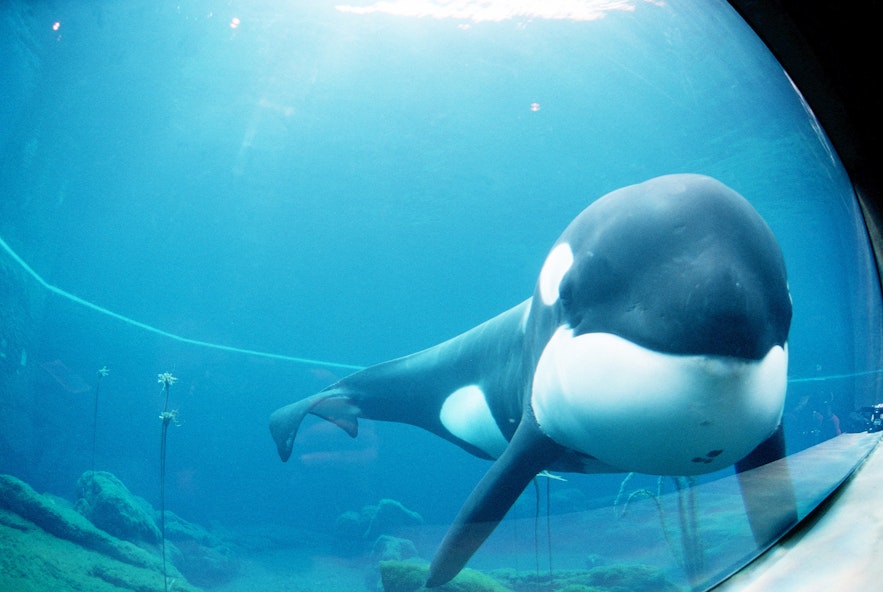
The most famous whale to grace Icelandic waters is not a magical creature of medieval literature but an aquatic star of Hollywood blockbusters.
Keiko, the male orca who portrayed Willy in the 1993 hit film Free Willy , was captured in Reydarfjordur fjord in East Iceland in 1979 and was originally named Siggi. He was subsequently bought and sold between various aquariums and marine parks, where he learned to perform for audiences before being cast by Warner Brothers Studios.
Following Keiko’s rise to stardom, The Free Willy-Keiko Foundation was established in 1995 to find him a better home. In 1998, the world looked on in amazement as Keiko was loaded aboard a C-130 US-Air Force cargo plane and flown from the United States back home to his birthplace in Iceland.
Keiko would finally be allowed to swim in the ocean again, hoping he would eventually reunite with other killer whales.
Keiko spent the following years in Klettsvik Bay of the Vestmannaeyjar Islands , where he underwent extensive training in preparation for a life of freedom on the open seas.
In August 2002, Keiko finally left Icelandic territorial waters with a group of wild killer whales, but in September, he showed up in a fjord in Norway, desperately seeking human contact.
Keiko’s reintegration into the wild had failed, and on December 12 of the following year, Keiko died of pneumonia while swimming alone in Norwegian waters. He was 27 years old.
No single marine animal has brought more attention to the whales of Iceland than Keiko. Since his passing, whale watching in Iceland has rapidly grown into a flourishing industry.
In 2018 alone, nearly 300,000 people took whale-watching trips from Icelandic harbors—quite a leap from the first tour of less than a dozen people in 1991.
Keiko's old home in Klettsvik Bay now has permanent residents once more. Two beluga whales, Little Grey and Little White were brought from an amusement park in Shanghai to live in the now-called Beluga Whale Sanctuary on June 20, 2019.
Paradoxically, the old whaling vessels in Reykjavik Harbor are anchored at the dock on which Iceland's largest whale-watching society operates.
Whaling has been practiced in Iceland from as early as the 12th century. Despite Keiko's popularity and the recent surge in whale-watching tourism, Icelanders remain one of only a handful of nations on Earth that still hunt and kill whales.
In 1986, Iceland’s whaling industry became the subject of worldwide scrutiny when anti-whaling activists sank the whaling vessels Hvalur 6 and Hvalur 7, which made up half of the Icelandic whaling fleet.
The incident sparked a fierce international debate between various radical and moderate animal rights organizations.
The outcome of that debate was not in the anti-whalers' favor. Most environmentalists denounced the tactics as too extreme, with some going as far as branding the incident as an act of terrorism.
Domestically, public opinion immediately swayed in favor of the whaling industry, with the general population viewing the incident as a gross outside intrusion into domestic affairs.
The two sunken vessels were promptly raised, and for several years, whaling continued, backed by even greater public approval than before.
However, with the rise of the Icelandic whale-watching industry, whaling is becoming less popular among the general Icelandic population, with Icelanders consuming only a fraction of Icelandic whale meat.
Have you been whale watching in Iceland? What whales did you see? What time of year did you go? If you haven't been whale watching, what species of sea mammals are you hoping to see? Let us know more about your whale-watching experience or any inquiries you might have in the comments below.
Popular articles

Guide to Iceland | The Story of the Leading Travel Agency of Iceland

The Complete Guide to the Midnight Sun in Iceland

Top 20 Most Beautiful Waterfalls in Iceland

22 Photos of the Aurora in Iceland

Mountains in Iceland
Other interesting articles.
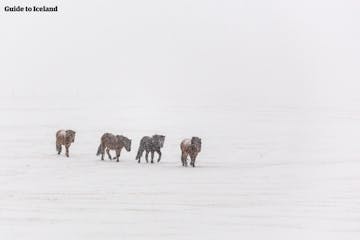
The Ultimate Guide to Iceland in December
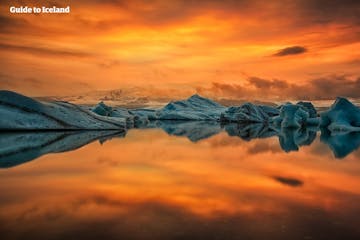
Visiting Iceland in October | Things To Do & Places To Visit
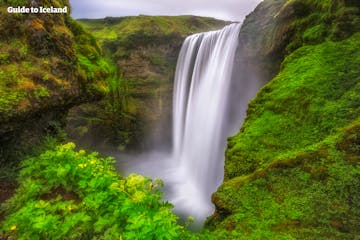
Glaciers in Iceland

Download Iceland’s biggest travel marketplace to your phone to manage your entire trip in one place
Scan this QR code with your phone camera and press the link that appears to add Iceland’s biggest travel marketplace into your pocket. Enter your phone number or email address to receive an SMS or email with the download link.
Top things to do in Iceland
Book your complete trip with the best companies only

Explore an Ice Cave

Visit a Live Volcano

Find the Northern Lights

Visit the Blue Lagoon

Go on a Road Trip

Do the Golden Circle

See the Glacier Lagoon

South Coast Tours
Best time to visit Iceland

The best time to visit Iceland is between September and March to see the northern lights, or between June and August for summer activities. While travel to Iceland may depend on your desired itinerary, generally, the best time to visit is during the summer. During this time, you’ll experience warmer temperatures and long days of sunlight, known as the spectacular midnight sun. While the summer boasts green countryside and animal spotting, the winter is the best time for the Northern lights and the country’s famous geothermal spas when they may not be as busy!
However, if you’re planning a trip to see something specific, such as the puffin or whale migrations, you’ll need to visit during a specific time of year. We've broken down some main factors to consider before choosing when to travel to Iceland.
The phenomenal cosmic light show, known as the aurora borealis or the Northern Lights, is a natural event that occurs from late September to late March. The long and dark winter nights make it an ideal time to visit, however, because it is a sporadic event, a definite sighting can't always be guaranteed. You may be more likely to see the lights during the equinoxes that occur around the 21st/22nd of March and September.
Learn more about the Northern Lights
Iceland’s famous Blue Lagoon is a year-round natural geothermal pool that is said to have healing properties and is situated among a scenic Icelandic landscape. This mineral-rich seawater contains a mix of silica, algae and other bioactive elements that can be particularly beneficial for certain skin conditions.
While the lagoon is open all year, if you’re hoping to visit with slightly warmer weather, you may want to visit in the summer months (May to August). That said, many travelers love to visit the springs in the winter months to be surrounded by the beautiful snowy hills of the region while they relax in the outdoor lagoon.
The Icelandic coastline is famous for its whale activity due to the cold waters and favored feeding grounds of the local marine life. Between April to September is the best time to visit Iceland for whale watching as this is when the whales migrate north for the summer months. Keep a look out for humpback, minke, fin, sperm or even blue whales! You might even see other marine species such as orcas, dolphins, seals or harbor porpoises.
Best for: Þorrablót Mid-winter Festival and ice caves
While mid-winter weather and short days may deter some travelers, the colder months are also perfect for ice cave exploration and catching a glimpse of the Northern Lights. However, if you’d like to stay out of the weather, why not partake in the honoring of the Icelandic ancestors during the Thorrablot festival? While visiting in January, join locals on a historical Icelandic food tour that includes foods such as hangikjot (flavored smoked lamb) or brennivin (a local distilled beverage).
Best for: Winter Lights Festival and Northern Lights
February is one of the best times to visit Iceland for some exciting food and cultural events. The two festivals, Winter Lights and Food & Fun are hosted annually by the capital Reykjavik and can add spark some joy in the coldest and wettest months of the year! But keep a watchful eye out for the Northern Lights.
Best for: Northern Lights, winter sports, Iceland Winter Games and the Annual Beer Festival
The longer and brighter winter days of March make it an advantageous time for winter sports. If you’re looking to downhill or cross-country ski, snowboard, snowshoe or hike the terrain, the nearest mountain is only a 20-minute drive away from Reykjavik.
Best for: puffins and golden plover migration, The Golden Circle and smaller crowds
April marks the start of the spring season in Iceland and the breathtaking return of several local bird species, including the world-renowned puffins and golden plovers. While the locals celebrate the first day of summer shortly after April 18th, this month is a perfect time to visit for lower off-season prices and fewer tourists. Remember that there may still be an assortment of rain, snow, hail or shine, so pack accordingly.
Best for: whale watching, nature adventures and long days
May in Iceland sees the end of the cold winter months, however, temperatures still sit between 32-50,°F although there is less chance of snow. Towards the end of May, there can be up to 20 daylight hours which makes it a great time to do some fun outdoor adventures. Why not take a tour through the lava caves, hike your way across a glacier, snorkel or scuba dive in Icelan's pristine waters or even horseback ride along the countryside?
Best for: midnight sun, Hafnarfjörður Viking Festival, National Holiday of Iceland, Fisherman’s Day and the opening of some highland roads
Summer has arrived! With summer comes longer days and the peak travel season so prices are higher and attractions are busier. June is one of the best times to explore the natural wonders of the Icelandic countryside. However, with a great array of cultural, music and environmental festivals, there’s something for every interest. The end of May to the start of June is also the best time to see the famed midnight sun phenomenon in Iceland so make sure you bring a good sleeping mask!
Best for: Braðslan, nature photography and long days
July is the busiest tourist month of the year for Iceland. With sunshine, greenery and longer days, it’s a perfect time to engage in the bustling city life or explore the vibrant natural scenery. If you’re looking for a slightly less crowded time, try to book in for the start of the month before the local schools are on break.
Best for: Reykjavik Pride, Reykjavik Culture Night, National Festival, Verslunarmannahelgi, Þjóðhátíð and wilderness exploration
Visiting Iceland in August usually ensures full access to the country’s wilderness as inaccessible areas in winter are now fully open. As one of the hottest months, the weather in August - while still unpredictable at times – is best for exploring the rugged and idyllic terrain of the glaciers, volcanoes, hot springs and waterfalls of the Icelandic wild. If nature isn’t your thing, the local scene has plenty of events and attractions to fill your itinerary.
Best for: fewer crowds and mild weather
September marks the end of the busy summer months but temperatures can still fall between 40-50°F. With the bulk of tourists on their way home, you’ll find lower prices and smaller lines for attractions. This is a great time to go if you’re looking to surround yourself with great music or film. Note that some highland roads will be closed by the end of the month for winter.
Best for: Northern Lights and berry picking
See the vibrant autumnal colors that blanket Iceland during October as the temperatures lower and leaves drop. As the colder months set in, plan for the Northern Lights as they can easily be seen at this time of year, especially when away from city areas without cloud cover.
Best for: hot springs, ice caves and Northern Lights
November brings winter into full steam with a drop in temperatures and daylight hours. Winter is often the most scenic time to visit one of Iceland’s many hot springs and relax in the white-blanketed scenery. With the drop in temperatures comes the reformation of the ice caves making November a perfect time to transverse the chilly blue caves and stunning glaciers.
Best for: New Year’s Eve, frozen waterfalls, glacier exploration, Christmas villages and festive lights
Looking to party into the new year? Iceland’s eclectic music scene and picture-perfect Christmas villages can provide you with day-to-night entertainment. While December is known as one of the coldest and windiest months, the Northern Lights are often viewable during this time. Just note that some hotels, services and attractions are closed during the winter.
Let's create an exclusive trip for your group.
Why 2024 is the best year to see the northern lights
How the Icelandic hot dog became an international icon
Iceland’s Folklore: 4 mythical creatures that make the scenery come alive
Top 12 things to do in Iceland
6 of the best hikes in Iceland
10 ways to get closer to nature with Intrepid
In sickness and in health: How I ended up getting married on an Intrepid Iceland trip
Iceland or Greenland? Which country should be next on your travel list?
- Best time to visit Iceland
Book your individual trip , stress-free with local travel experts
- roughguides.com
- Travel guide
- Itineraries
- Local Experts
- Travel Advice
- Accommodation
Plan your tailor-made trip with a local expert
Book securely with money-back guarantee
Travel stress-free with local assistance and 24/7 support
Carson (United States)
I must tell you that my tour with you is probably THE best tour I've ever taken (and I've taken a lot). My guide Rico set a bar so high that I don’t know i...
Whilst Iceland has no trouble giving travellers a reason to visit all year round, the seasons vary hugely, due to how north the country sits. Iceland's geographical position not only affects the weather but also the hours of daylight you can expect to have. These, alongside the best times to see the Aurora Borealis, or Northern Lights , are crucial factors in deciding the best time to visit Iceland.
What is the best time to visit Iceland?
What are the travel seasons in iceland, best time to visit iceland month by month, best time to see the northern light in iceland, planning for your iceland road trip, best time to visit iceland: events and festivals, tailor-made travel itineraries for iceland, created by local experts.

8 days / from 2092 USD
Iceland: A Game of Thrones Road Trip
This themed road trip will take you around Iceland, home to many filming locations of the hit TV series, Game of Thrones. Travel around the country's coastline, past the many dramatic glaciers and cliffs, relax in geothermal spas, and spot whales in the rough seas. Warning: Spoiler alert!

8 days / from 2052 USD
Iceland's Wild West
Welcome to the road trip of a lifetime, which will bring you to some of western Iceland’s wildest and most remote spots. On this adventure, you will pay unforgettable visits to Hraunfossar Waterfalls, as well as the Barnafoss and Deildartunguhver hot springs, and much more!

6 days / from 1680 USD
Iceland's Highlights from East to West
Take a flight to the East where you get to enjoy the enchanting Eastfjords before you drive south. If you are looking to focus on a few regions with a mix of the most popular sights and something off the beaten path; and to avoid backtracking with a one-way domestic flight, this is the perfect trip.
The best time to visit Iceland varies greatly depending on the activities and experiences you are seeking. For outdoor recreation, the months of June to September are ideal, offering mild weather and extended daylight hours, perfect for exploring Iceland's unique landscapes. For those eager to witness the mesmerizing Northern Lights, the darkest months of December to January are the most suitable. For snow sports enthusiasts, February to March is the prime time, with Iceland's winter landscapes providing perfect conditions for skiing and snowboarding. Lastly, if you prefer off-peak travel to avoid crowds and potentially lower costs, April to May is an excellent choice, offering a quieter yet equally beautiful experience of Iceland.
Best times to visit Iceland for good weather
The ideal time for favorable weather in Iceland is the summer season, extending from late June to September. Temperatures during this time range from 12°C-20°C, and the sunny setting in Reykjavik is a delight to experience. The vibrant purple lupines flourish over the meadows, making it an ideal time for hiking and exploring the natural beauty of Iceland.
Best times to visit Iceland with fewer crowds
Planning a trip to Iceland during the shoulder seasons of March, April, May, and September can help you avoid the tourist rush. During these transitional months between the peak and off-peak seasons, you can enjoy relatively good weather with fewer crowds. The sights and sounds of the glaciers, hot springs, and northern lights can be thoroughly enjoyed without the hordes of tourists.
Worst months to visit Iceland
The worst time to visit Iceland in terms of the weather and outdoor activities predominantly corresponds to the winter months, notably November, December, and January. During this period, the country faces extreme weather conditions featuring heavy snowfall and chilly temperatures. These elements, in conjunction with shorter daylight hours, make outdoor exploration quite challenging for all but the most adventure-loving visitors.
Aiming to beat the crowd? Then it's worth noting that June to August, despite being the best time for outdoor activities, are the months where the popular tourist spots like the Golden Circle, Blue Lagoon , and Jökulsárlón Glacier Lagoon see significant crowd inflow.

Mountain Stapafell in the background at Arnarstapi Village in summer sunny day in Iceland ©Shutterstock
The best time visit Iceland doesn't always depend on the weather, but could be season related too. Let's dive deeper into Iceland seasons.
Iceland peak season
The peak travel season in Iceland spans from June to August. During these months, the country experiences the mildest weather, longest daylight hours, and offers the most activities. The radiant midnight sun is a spectacular sight in June and July. This period sees the highest tourist influx, making it the most vibrant but also the most crowded.
Considered the best time for outdoor activities like hiking and kayaking, it's also perfect for reveling in the rich wildlife of the country. It is particularly great for spotting whales and birds. However, the high footfall of tourists also means spiked prices and crowded destinations. It’s recommended to book accommodations , transportation and trips in advance if you plan to visit during the peak season.
Iceland shoulder season
Shoulder season in Iceland, consisting of May, September, and early October, offers a balanced mix of good weather, reasonable prices, and lesser crowds.
In May, the snow has begun to melt, the nights are filled with stunning sunset hues, and the low-season hotel rates can prove a steal. Attractions, however, are less crowded, and many museums and sites that close during the winter are now reopening. The weather can still be unpredictable, with a breeze and potential snow in the country's interior.
September and early October are glorious months for landscape photographers and aurora borealis chasers. It's an excellent time to witness the extended pink dawns and dusks that paint the Icelandic landscapes, and partake in daytime hiking with nighttime vigils for the Northern Lights. The weather is relatively pleasant for longer periods, making it an engaging time for stargazing.
Iceland low season
Iceland's low season stretches from mid-October to the end of April. The most prevailing challenge during this time is the extreme cold weather, with temperatures often plummeting to -30 degrees Celsius. Add to this the wind chill, and it can feel even colder. Daylight, too, becomes scarce, with December offering only about four hours of light each day.
But winter in Iceland also has its own charm and advantages. One major highlight during the low season is the breathtaking ice caves and glaciers that come into their prime, providing an arresting sight for nature lovers. Additionally, fewer tourists lead to less crowding at popular attractions and in towns.
On the downside, it's difficult to get off the beaten track due to road closures. Many outdoor activities and attractions close down during this period except for those catered to experienced winter adventurers. Despite these limitations, it's worth noting that low season is synonymous with lower travel costs and offers an entirely different perspective on Icelandic landscapes.

If you're into nature, Iceland is a great destination!
If you don't know what month will be best for you, read on about the best time to visit Iceland month by month.
Visiting Iceland in January
For those seeking tranquility and a magical winter wonderland, January is a fabulous time to visit Iceland. It is one of the quietest times, meaning key attractions are significantly less crowded. The days are short, with the sun rising around 11 am and setting around 4 pm. Even though these short dark days can mean reduced sightseeing time, they also increase your chances of witnessing the mesmerizing Aurora Borealis, or Northern Lights.
The January landscape is covered in crisp white snow, providing a breathtakingly beautiful backdrop for winter activities such as snowmobiling, and ice cave exploration. Furthermore, thermal baths and hot springs offer a respite to the sub-zero temperatures, which can range between -10°C and 0 °C.
Visiting Iceland in February
Visiting Iceland in February allows you to experience the beauty of the country in its winter glory. Temperatures range between -10°C and 8 °C and the days provide more daylight hours than in January, though sunlight continues to hang low, giving Iceland a golden tinge, making for some fantastic photo opportunities.
One of the biggest attractions in February is the high probability of catching the Aurora Borealis, creating vivid displays in the Icelandic night sky. The sight is so captivating that it draws numerous tourists from around the world. Also, weather permitting, you can venture on iceberg, waterfall, or glacier tours outside the city.
Visiting Iceland in March
Visiting Iceland in March offers a unique blend of winter's beauty and the emerging signs of spring. This time of year is ideal for experiencing a mix of snow-covered landscapes and longer daylight hours, allowing for extended sightseeing. It's a fantastic period for winter activities like snowmobiling, glacier tours, and especially for viewing the Northern Lights, as the nights are still dark enough for their vivid display.
March in Iceland also marks the beginning of the whale watching season, providing an opportunity to witness these magnificent creatures in their natural habitat.

Iceland northern lights © Shutterstock
Visiting Iceland in April
April is the harbinger of spring in Iceland and serves as an attractive time to visit. Days grow longer, with approximately 14 hours of sunlight, and the icy landscapes slowly start to thaw. The temperatures can range from 3-6°C, offering a relatively pleasant climate for outdoor activities.
While winter activities are winding down, there still might be some opportunities for snowmobiling or ice cave adventures, especially in the earlier part of the month. You can partake in brisk hiking excursions, taking in the crisp air and magnificent views as the country blossoms into spring. Southern Iceland regions around Skogafoss, Vik, and Jökulsárlón Glacier Lagoon are particularly picturesque during these months.
Visiting Iceland in May
May is a fabulous time to visit Iceland, marking the transition from the shoulder season to the beginning of summer, with daily daylight hours surpassing fourteen. Temperatures range from 9°C to 12°C, providing an agreeable climate for various activities.
The onset of spring, coupled with lengthening days and the midnight sun, paints the country in vibrant colors. Landscapes become lush, and the blooming wildflowers add a special charm to the scenery.
Wildlife is another highlight of visiting Iceland in May. From whale watching tours to puffin-spotting excursions, wildlife enthusiasts are sure to enjoy their stay. The adorable puffin bird returns to the shores of Iceland starting in mid-April, so sightings are strongly probable in May.
Visiting Iceland in June
June marks the beginning of a spectacular summer season in Iceland when the country experiences the delightful phenomena of the midnight sun, with almost 24 hours of daylight and ample opportunities to explore the great outdoors.
Temperatures typically range from 9°C to 15°C, but the weather remains unpredictable, with bright sunny days often swiftly turning to heavy cloud cover or misty rain, so light layers and waterproof clothing come in handy.
The midnight sun is a sight to behold, it is when the sun is still visible even at midnight, creating a perpetual twilight. This phenomenon leads to some unforgettable memories and excellent photography opportunities.

Skogafoss waterfall, Iceland © Shutterstock
Visiting Iceland in July
July embarks on the height of summer, marking it as one of the warmest and busiest months in Iceland. It punches in 24 hours of daylight, kicking off the enchanting 'Midnight Sun' period. Average temperatures rest between 10°C to 15°C, leading to pleasant, sunny days that make outdoor exploration inviting.
The month is noted for its long, lazy days that stretch till almost midnight, followed by the sun rising again around 4 am. Trails for hiking, including the famous Laugavegur trail and those of the usually inaccessible Highlands, pop open and the eerie late-night light is irresistible especially for photographers.
Whale watching tours are in full swing in Iceland in July, which teams beautifully with snow-free roads for drives and hikes around the country. The 'Midnight Sun' also simplifies long drives along the iconic Route 1 or 'Ring Road,' which wraps around the island with plenty of must-see locations along the way.
Visiting Iceland in August
August is a veritable feast of summer in Iceland, making it a highly recommended time to visit. This month witnesses the country in full swing, with long daylight hours and temperatures generally ranging between 11°C and 15°C, slightly cooler than July but still warm relative to local standards.
Despite the summer rush, Iceland retains its freshness and appeal in August. The lush landscapes, blooming florals, and a voluminous burst of colors paint the most picturesque image of this Nordic land. Icelandic forests take on a remarkably green hue, lakes shimmer under the mild sun, and cascading waterfalls spring to life.
Visiting Iceland in September
September kicks off the autumn season in Iceland and serves up enchanting landscapes awash with oceans of red, brown, and gold—the best time to witness the country's fall foliage. The temperatures range between a comfortable 5°C (41°F) to 9°C (48°F). As the crowd thins out post the peak season rush, tranquil serenity sets in, and the country's beautiful destinations become less crowded.
One of the prime advantages of visiting Iceland in September is the opportunity to catch the Northern Lights. As daylight hours start to reduce, the equinox in mid-to-late September increases solar activity, making the conditions ideal for viewing this natural spectacle.

Hiking the Laugavegur trail is one of the best experiences in Iceland © Shutterstock
Visiting Iceland in October
October can be a magical time to visit Iceland, where the season shift from autumn to winter can be strongly felt. The weather becomes more unpredictable, with temperatures varying between 2°C (35°F) and 7°C (45°F), and the first snowflakes of the season might start to fall, dusting the already vibrant landscapes with a touch of winter's wonder.
While the days start to shrink significantly, the amazing spectacle of the Northern Lights becomes more prominent. This is one of the best times to chase the aurora borealis, with solar activity being high and less light pollution due to shorter days.
Natural wonders become a serene spectacle with pops of falling leaves colored in hues of red, orange, yellow, and brown. October is the last month when you can tour the highlands before the roads close for winter. Therefore, it's a great time to visit Landmannalaugar, Thórsmörk, or other highland attractions.
Visiting Iceland in November
Visiting Iceland in November means embracing winter's arrival as temperatures dip between -2°C to 3°C, becoming colder as the month progresses. The days also get significantly shorter, with roughly 6-8 hours of daylight, providing a whole different range of experiences to explore under darker skies.
Arguably the star attraction during this time is the mesmerizing Northern Lights, which make their appearance more reliably as nights get longer. A late-night sweep to chase these mystical lights can turn out to be a highlight of your trip.
Although the weather is chilly, the snowy landscapes and the waterfalls clad in winter dress present another level of beauty. November offers the opportunity for some unique winter activities like glacier hiking and exploring newly formed ice caves. Adventurers can also go snowmobiling on glaciers or try their hand at winter sports.
Visiting Iceland in December
Stepping into Iceland in December is like striding into a fairytale-like winter wonderland. With average temperatures ranging from -1°C to -5°C, this month delivers the country's most intense winter experiences, complete with snowfall, nearly round-the-clock darkness, and an enchanting Christmas atmosphere.
Look beyond the short daylight hours, and you'll find a capital city that's a slice of holiday magic. Reykjavík comes alive in December with Christmas lights illuminating the city, streets adorned with decorations, and 13 jovial Santa Clauses, the Yule Lads, bringing holiday cheer.
Furthermore, New Year's Eve in Iceland is a sight to behold. Locals and tourists alike gather to build bonfires and set off fireworks, making for a memorable experience and a spectacular welcome to the coming year.
For the most accurate live weather updates, you can check Accuweather .

Winder Wonderland at the Reykjadalur Steam Valley © Shutterstock
To witness the Northern Lights at their peak, aim for the winter months between September and April. This period, characterized by long, dark nights, contrasts sharply with the bright summer nights in Iceland, offering optimal conditions for observing this natural phenomenon.
Make sure to read our article about the best places to see the Northern Light in Iceland.
Between September and April
The ideal time to spot the mesmerizing Aurora Borealis or the Northern Lights in Iceland ranges from September to April. The period perfectly coincides with Iceland's darker months, providing ample nighttime hours for this natural light spectacle to shine through.
As sunlight begins to recede in October, the duration of darkness gradually lengthens, bringing increased opportunities to see the Northern Lights. The display grows more pronounced from November to January, albeit with shorter daylight hours and extreme cold weather. However, clear skies during these months contribute to better visibility.
It's important to be aware that Northern Lights sightings are naturally unpredictable, relying on solar activity and sky clarity. Create a flexible itinerary to adapt to cloud cover or solar activity changes.
Tracking weather and solar activity through reliable online resources like the Icelandic Meteorological Office or websites providing Aurora Forecasts can help you gauge the most suitable nights for viewing the lights.
Best places to see the Northern Lights
The magical Northern Lights can be seen across Iceland during winter months, but there are some places that offer particularly stunning views due to minimal light pollution:
- Thingvellir National Park: Being a UNESCO World Heritage site and away from the city lights, this park offers a darker sky, providing an optimal setting for viewing the Northern Lights.
- Jokulsarlon Glacier Lagoon : The floating icebergs on the lagoon add an otherworldly charm to the backdrop of the Northern Lights, resulting in visually stunning scenes.
- Vik : Located south of Reykjavik, the town of Vik, with its black sand beaches, offers a serene and somewhat surreal location to view the Northern Lights, with the dancing lights reflecting off the ocean waves.
- Snaefellsnes Peninsula : Enhanced by its remote location, the peninsula offers an excellent platform for Northern Lights viewing, with the added feature of the famous Kirkjufell mountain as a gorgeous backdrop.
- Grotta Lighthouse, Reykjavik: If you're based in Reykjavik and don't want to venture too far, the area around the Grotta Lighthouse offers one of the best viewpoints in the city. It's still crucial to have a clear and dark night for the best viewing experience.
Remember that viewing the Northern Lights is heavily dependent on the right weather conditions and solar activity. Therefore, keep a close eye on the forecast and be prepared to change your plans accordingly. It's always recommended to join a Northern Lights tour, wherein expert guides can take you to the best locations based on real-time forecasts and conditions.

Northern lights reflected in Jökulsárlón glacier lagoon © Krissanapong Wongsawarng/Shutterstock
Embarking on an Iceland road trip? Our guide helps you navigate this breathtaking landscape, ensuring a memorable journey through Iceland's natural wonders, from volcanic terrains to icy vistas. Let's get your adventure on the road!
Iceland's Ring Road – when you have time
Iceland's Ring Road, also known as Route 1, encircles the entire country, providing the chance to see the best of Iceland's breathtaking landscapes. Spanning 1,322 kilometers or 821 miles, it's an exceptional drive that can be completed year-round, but the best months for travel are between April and October when the weather is generally calmer.
The least duration advised to drive the scenic stretch is one week, but 10-14 days are recommended to immerse fully in the Icelandic landscapes and diverse attractions. This extended travel period provides enough leeway to explore major attractions such as Geysir, Thingvellir National Park, Vatnajökull National Park, Skaftafell National Park , the black sand beaches of Vik, the charming town of Akureyri , Myvatn , and much more.
You can drive in a clockwise or counterclockwise direction, with accommodation options varying from hotels to guesthouses and camping sites along the way.
Pack plenty of food, water, and supplies for your journey, check road and weather conditions regularly, and ensure to fuel up wherever possible, as gas stations can be at a considerable distance apart.
Make sure to check Safetravel.is for the most recent updates.
Short road trips in Iceland
If time-constrained or preferring shorter trips, you'll be glad to know that Iceland boasts several shorter yet utterly mesmerizing road trips. Here a few recommendations:
- The Golden Circle: One of the most popular routes, the Golden Circle, is an easy day trip from Reykjavik. This 300 km loop covers notable sights like Thingvellir National Park, Geysir Geothermal Area, and Gullfoss Waterfall.
- The Blue Diamond Road: This route circles the Reykjanes Peninsula, located near Reykjavik and Keflavík International Airport, making it an easy day trip. This region is home to the famous Blue Lagoon as well as an array of lava fields, geothermal areas, bird cliffs, and beautiful coastline.
- South Coast Drive: A drive along the South Coast up to Jökulsárlón Glacier Lagoon and Diamond Beach offers hulking glaciers, pristine beaches, beautiful waterfalls, and other natural wonders, all within 370 km from Reykjavik.
- The Arctic Coast Way and the Diamond Circle: Both situated in North Iceland, each route presents awe-inspiring landscapes, with the Arctic Coast Way encompassing 900 km of northern coastline, and the Diamond Circle featuring notable attractions like Dettifoss Waterfall and Myvatn Nature Baths in just 260 km.

Strokkur geyser along the Golden Circle © Shutterstock
Iceland's holiday calendar blends Christian and secular traditions, with some festivals dating back to pagan times. Familiar celebrations like Christmas, Easter Monday, and New Year are observed similarly to other Western nations.
The midwinter celebration Þorrablót, rooted in the Viking era, honors the weather god Þorri. Held throughout February, it features parties centered around traditional Icelandic foods like svið and hákarl.
Sjomannadagur (Seamen’s Day) on June 4 is a significant holiday, marked by community events such as mock sea-rescue demonstrations and swimming races. Independence Day on June 17 commemorates Iceland's separation from Denmark in 1944.
Jónsmessa, on June 24, while not an official holiday, is steeped in folklore, believed to be a time when elves and magical creatures are active. Celebrations often include bonfires and, according to tradition, running around naked for good health.
Verslunnarmannahelgi, akin to a Labour Day Weekend, occurs on the first weekend of August. Icelanders traditionally camp in the countryside, engaging in extensive celebrations. Concurrently, Heimaey in the Westman Islands hosts Þjódhátið, featuring live music and bonfires, marking Iceland’s partial political autonomy achieved in 1874.
An event of note is the annual stock round-up, or rettir, in September. During this time, horses and sheep are herded from summer pastures by riders on horseback, with some farms allowing guests to observe or participate in the sorting process.
The Rough Guides to Iceland and related travel guides
In-depth, easy-to-use travel guides filled with expert advice.

Travel advice for Iceland
From travel safety to visa requirements, discover the best tips for traveling to Iceland
- How to get to Iceland
- Sports and Outdoor activities in Iceland
- Eating and drinking in Iceland
- Getting around Iceland: Transportation Tips
- Travel Tips Iceland for planning and on the go
Find even more inspiration here

- Travel Tips
written by Rough Guides Editors
updated 29.03.2024
Ready to travel and discover Iceland?
Get support from our local experts for stress-free planning & worry-free travels.
- Where to stay
- Travel advice
Why winter is magical in the Westfjords (and other great times to come)
Dec 6, 2021 • 9 min read
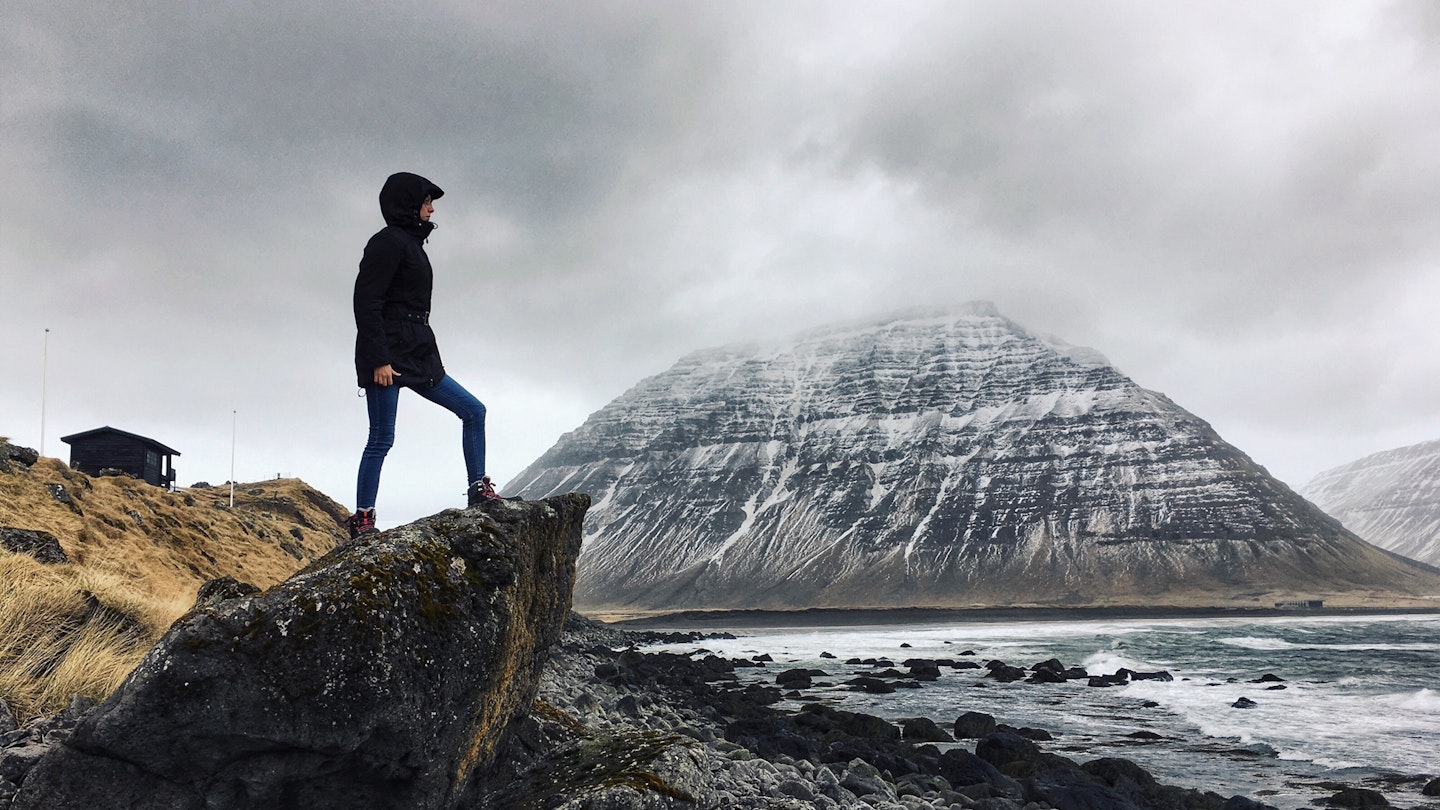
The Westfjords is the wild, untamed Iceland you've always imagined © Hana Masovic / Eyeem / Getty Images
If you’re looking for Iceland at its rawest, wildest and emptiest, the Westfjords is most definitely where you’ll find it.
This off-the-radar peninsula in northwest Iceland is only 200km (124 miles) from Reykjavik – less than a day’s drive – yet fewer than 10% of visitors take the time to explore it, deterred by its remoteness, its sparse habitation, and its notorious unpaved roads.
Those who do visit return with tales to make other travelers green with envy. This is a land of craggy cliffs cloaked with seabirds, thunderous waterfalls, vast glaciers, epic valleys – and perhaps most compelling of all – hardly any other visitors to share these wonders with.
If you’re one of the hardy few who make it to the Westfjords, bear in mind that the weather can be wild, whatever time of year you visit. The short Icelandic summer from June to August brings the most settled conditions and the longest days (in midsummer the sun never sets at all) but in winter, it’s the polar opposite: just a few hours of daylight a day, with heavy snowfall and ice aplenty.
Visitor numbers drop off sharply in spring and fall, so these are good times to explore the region’s amazing hiking trails in solitude. Winter is reserved for hardy explorers, but there's skiing at Isafjördur and you have a decent chance of spotting the Northern Lights.
For fans of scenery and solitude, here are the top times to come to the Westfjords.
Low Season (October–April) is the best time to see the Northern Lights
Perhaps unsurprisingly, winter is the most challenging time to visit the Westfjords. Snow, ice and blocked roads are common. Some of the more isolated communities of the Westfjords are cut off entirely for much of winter. But it’s also a spectacularly beautiful time of year – especially if you want to experience winter skiing or snowshoeing in an empty landscape or have front-row seats for the Northern Lights.
The aurora is actually present for most of the year, but it requires clear, dark skies to become visible. You might get enough darkness in September and May, but visiting from October to April optimizes your chances. Note that winter driving in Iceland – especially in the Westfjords – can be challenging; snow tires and/or snow chains are essential. Better still, rent a 4WD.
Shoulder Season (May and September) is the best time for quiet trails
Spring and fall whizz by so fast in Iceland that you could blink and miss them – especially in the Westfjords, where there are few trees to mark the transition (locals are more likely to discern the arrival of spring and fall by the amount of snow on the ground). Nevertheless, these are great times for walking along empty trails.
The Westfjords are noticeably quieter in spring and fall. There are fewer hikers on the trails and hotel rooms are easier to come by (and often a bit cheaper). Larger roads and passes are likely to be open, making this a good time for a road trip, but some seasonal shops, attractions and restaurants are likely to be closed.
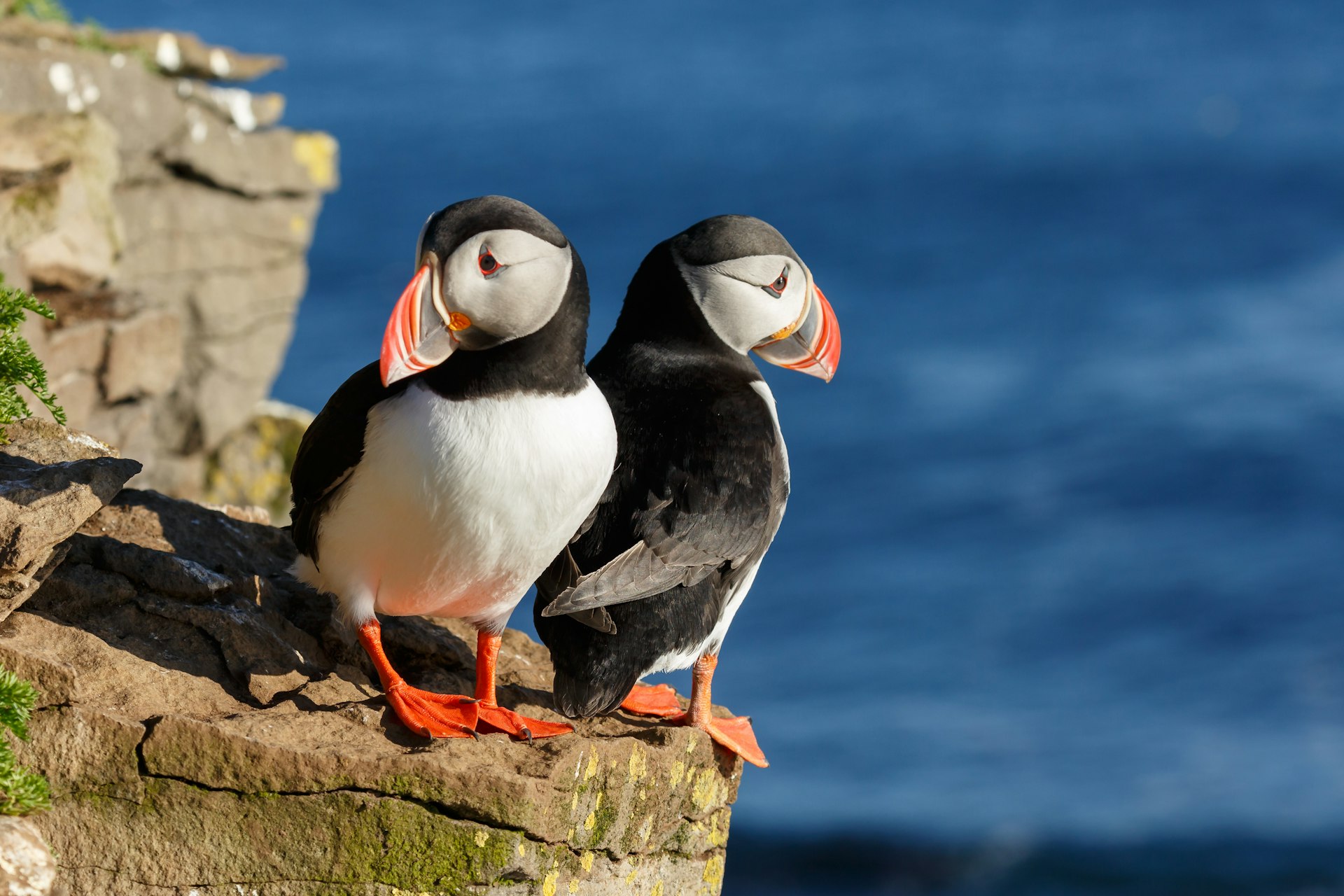
High Season (June–August) is the best time for outdoor activities
In line with the rest of Iceland, the summer months are when the Westfjords opens up for outdoor pursuits: hiking, mountain biking, sea kayaking, wildlife spotting and more. All the major mountain passes and cross-fjord ferry routes linking the valleys of the Westfjords are open at the height of summer, making travel relatively straightforward.
Summer is also the time when the Westfjords are at their most crowded – relatively speaking – so you'll need to book ahead at hotels, especially in popular areas such as the main city of Ísafjörður . There’s also plenty of daylight – 24 non-stop hours in June, with only a couple hours less in July and August – maximizing your time for exploring.
Being weather-ready in the Westfjords
Whenever you come, you'll need to be prepared for all weathers in the Westfjords. Wintry conditions can strike without warning, even in midsummer. Wind and rainproof gear, a pair of decent boots and some warm layers will definitely come in handy, and it’s worth packing a spare tire and an extra can of gas just in case (petrol stations in the Westfjords are few and far between). A road map and ferry timetables are also very useful: don’t rely on being able to get a decent cell signal out in the Westfjords.
Just three hours of daylight and average temperatures that barely scrape above freezing make January a demanding month to visit – but if you hit the jackpot and get some clear weather days, it’s a brilliant time to get in some winter wildlife watching. The Westfjords is one of the few areas where you have a good chance of spotting Arctic foxes in the wild. January is also peak time for aurora-watching – as long as you’re prepared to hang around for those elusive cloud-free skies, of course. Key events: Þorrablót

The days get noticeably longer in February – you can expect around five solid hours of daylight, especially toward the latter part of the month. Snow still cloaks the landscape, and aurora activity remains strong – but day after day of grey skies can obscure the show. Key events: Bolludagur (Cream Bun Day), Sprengidagur (Bursting Day), Öskudagur (Icelandic Halloween)
With twice as much daylight as February – up to ten hours daily – March is the height of the ski season in the Westfjords. Cross-country skiing, downhill and snowboarding are all on offer at the main ski resort in Ísafjörður, while more experienced skiers can head off into the backcountry (hire an experienced local guide for safety). Key Events: Fossavatn Ski Marathon (late March or early April)
April is a transition month in the Westfjords. Winter still holds much of the landscape in its icy grip, and many areas are still blanketed in thick snow, but more sheltered areas show the first signs of spring: a flush of greenery, perhaps, or even a few wildflowers. Ski season continues at Ísafjörður. Key Events: Ísafjörður Ski Week; Sumardagurinn fyrsti (first day of summer)
The first serious thaws of the year usually happen in May, opening up parts of the Westfjords that have been off-limits for much of winter. Wildflowers begin to bloom in earnest, and it’s a great time of year for birdwatching. Seasonal seabirds – from guillemots, razorbills and cormorants to kittiwakes and puffins – take up roost on the region’s craggy cliffs, including at Látrabjarg , Iceland's westernmost point. The snowmelt also means this is generally a good time to view mighty Dynjandi and other Westfjords waterfalls in full flow. Key Events: Peak season for birdwatching
The month of the midnight sun hits. The Westfjords basks under 24 hours of perpetual daylight, allowing maximum time for exploring. It’s also a brilliant time of year for photography, with a golden hour that seems to last forever, though temperatures rarely climb above 10˚C (50˚F). Mountain roads and hiking trails start to open up in June and the endless daylight means you can pack in some serious trail time. Remember to pack an eye mask if you plan on getting any sleep at all. Key Events: Sjómannadagurinn (Sailor’s Day); National Day of Iceland; Summer Solstice
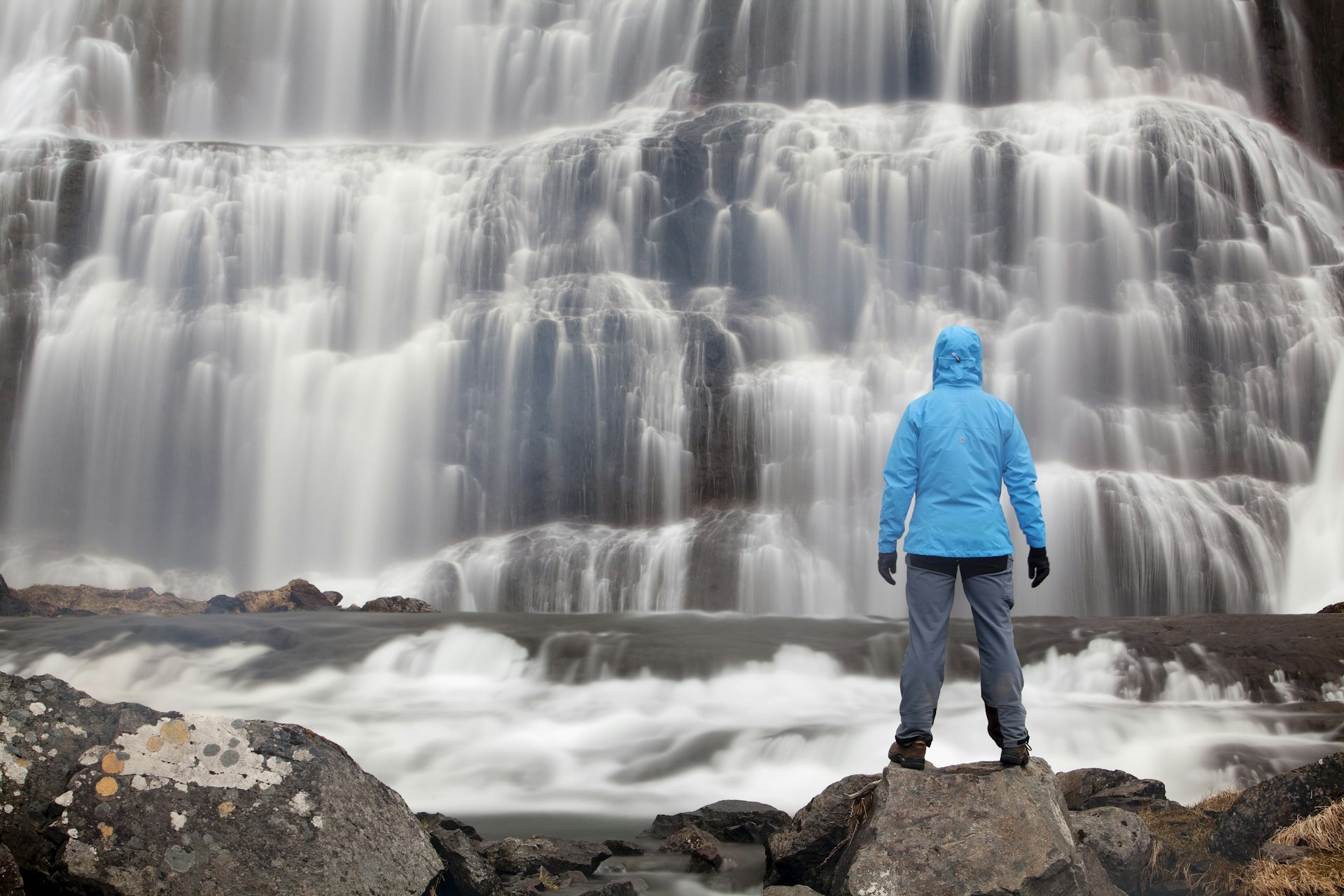
The start of summer in the Westfjords, with plentiful wildflowers, activities galore and even the chance of sunburn. Though temperatures hover around 10–12˚C (50–54˚F), the summer sun in Iceland can be very strong, so pack sunblock. It’s an excellent time of year for wildlife: humpbacks, gray whales and orcas can be seen off the coast, and playful puffins waddle around the Westfjord’s cliffs. It’s also the best time of year to explore the amazing wilderness area of Hornstrandir and take a day trip to the island of Vigur . Key Events: Swamp Soccer in Bolungarvík
Another great month for hiking, biking and outdoor pursuits, with lots of daylight (16 to 17 hours) and the year’s warmest temperatures, peaking at 14–16˚C (57–61˚F). Seabirds (including puffins) begin to migrate south for the winter, so this is your last chance to see them, and whale sightings also become less common. Trails are at their busiest, however, and the most popular hotels and campsites can be booked out. And while it might not quite be sunbathing weather, August is a fine month for exploring the Westfjord’s beaches, including Breiðavík and Rauðasandur . Towards the end of the month, the first bite of winter can be felt once darkness falls. Key Events: Verslunarmannahelgi; Blueberry Days in Sudavik
If fall’s going to put in an appearance, September is when you’ll see it – although with hardly any trees in the Westfjords, don’t expect much in the way of leaf-peeping. With fewer visitors, it’s an excellent time for tours: kayaking, photography and guided hikes are all popular. Key Events: Icelandic Blues Festival in Patreksfjörður
Temperatures drop sharply and the first winter snowfall can be expected in October. Temperatures drop close to freezing overnight, and 10-12 days of snow is not unusual across the month. October is also when the Northern Lights begin to show up reliably in the Westfjords, so it’s an excellent time to book an aurora tour. Key Events: Start of the Northern Lights season
The sun is gone by 4pm in November, so Icelanders head inside in search of food, drink and entertainment. This is a great time to visit the region’s biggest town – bustling Ísafjörður – to hunker down in its cozy cafes and pubs, visit heritage museums and dine out in seafood bistros. Don’t miss the informative Westfjords Heritage Museum and the quirky Museum of Everyday Life . Key Events: Christmas tree lighting across the Westfjords
Like many Nordic nations, Iceland puts on a grand show for Christmas. Every house is decorated with colorful lights, and the calendar is packed with festive events – from winter beer tastings to reindeer rides and Christmas markets. Fireworks light up the sky on New Year’s Eve – but they’re often overshadowed by the aurora. Key Events: New Year’s Eve
Safety recommendations and restrictions during a pandemic can change rapidly. Lonely Planet recommends that travelers always check with local authorities for up-to-date guidance before traveling during Covid-19 .
You may also like: The 15 places you don't want to miss in Iceland Why the Westfjords are the place to escape the crowds in Iceland 8 Iceland activities for adventure seekers
Explore related stories
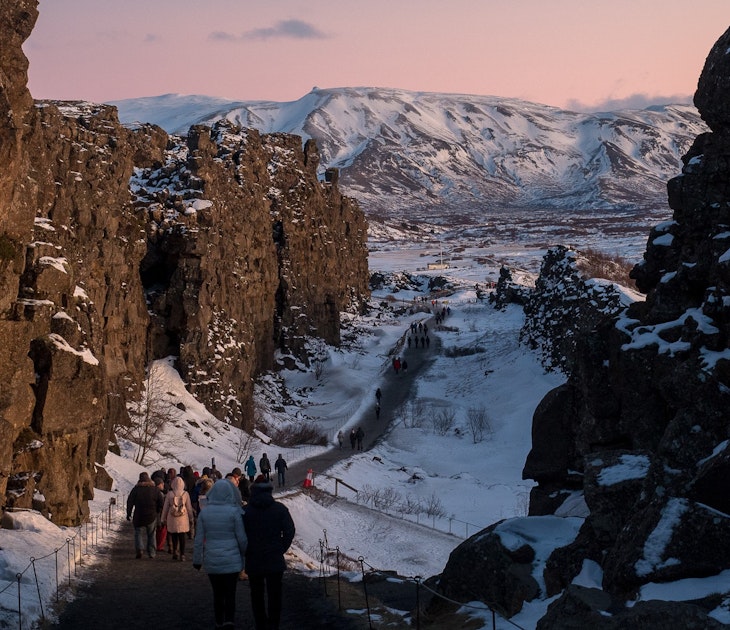
Mar 31, 2024 • 12 min read
From geothermal spas to nightlife in Reykjavík, experience the best of Iceland with these top things to do.
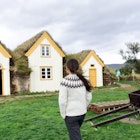
Mar 31, 2024 • 6 min read

Mar 6, 2024 • 9 min read

Mar 4, 2024 • 10 min read

Feb 28, 2024 • 8 min read

Feb 19, 2024 • 7 min read
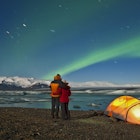
Feb 6, 2024 • 7 min read

Dec 26, 2023 • 6 min read

Nov 23, 2023 • 10 min read
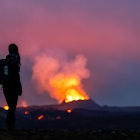
Nov 13, 2023 • 5 min read
Best Time to Take an Iceland Cruise

Iceland Climate

Iceland in June: Weather and Wildlife

Iceland in July: Activities and Adventure
Iceland in august: the last days of the midnight sun.

Iceland in September: Start of Northern Lights Season
Best time of year for northern lights in iceland, take a soak in the blue lagoon waters (monika sundem) best time to visit blue lagoon, want to go, top iceland travel destinations.
- Flatey Island
Iceland Trips by Departure Date
- 2024 Iceland trips (104)
- 2025 Iceland trips (44)
- 2026 Iceland trips (7)
- April 2024 (19)
- May 2024 (25)
- June 2024 (33)
- July 2024 (41)
- August 2024 (49)
- September 2024 (29)
- October 2024 (18)
- November 2024 (16)
- December 2024 (16)
Top Experiences in Iceland
- Iceland Cruises (108)
- Iceland Wildlife & Safari Exploration (33)
- Iceland Cultural (27)
- Iceland Luxury (21)
- Iceland Land Tours (12)
- Iceland Trekking (10)
- Iceland Scheduled Group Tour (7)
- Iceland Active (6)
- Iceland Solo Travel (4)
- Iceland Family (4)
- Iceland Beaches (3)
Iceland Trips by Duration
- 5 day trips (5)
- 8 day trips (9)
- 9 day trips (9)
- 10 day trips (11)
- 11 day trips (12)
- 12 day trips (10)
- 13 day trips (11)
- 14 day trips (13)
- 15 day trips (12)
- 16 day trips (4)
- 17 day trips (5)
- 18 day trips (4)
- 19 day trips (3)
Iceland Trips by Activity
- Iceland wildlife viewing (93)
- Iceland small ship cruises (83)
- Iceland whale watching (60)
- Iceland hiking (53)
- Iceland village visits (39)
- Iceland kayaking (33)
- Iceland adventure options (9)
- Iceland archaeological site visits (8)
- Iceland northern lights (7)
- Iceland land & sea exploration (5)
- Iceland photography seminars (4)
- Iceland urban exploration (3)
- Iceland horseback riding (3)
Why Travel With Adventure Life
Recognized by.


Best Time to Visit Iceland: A Complete Guide
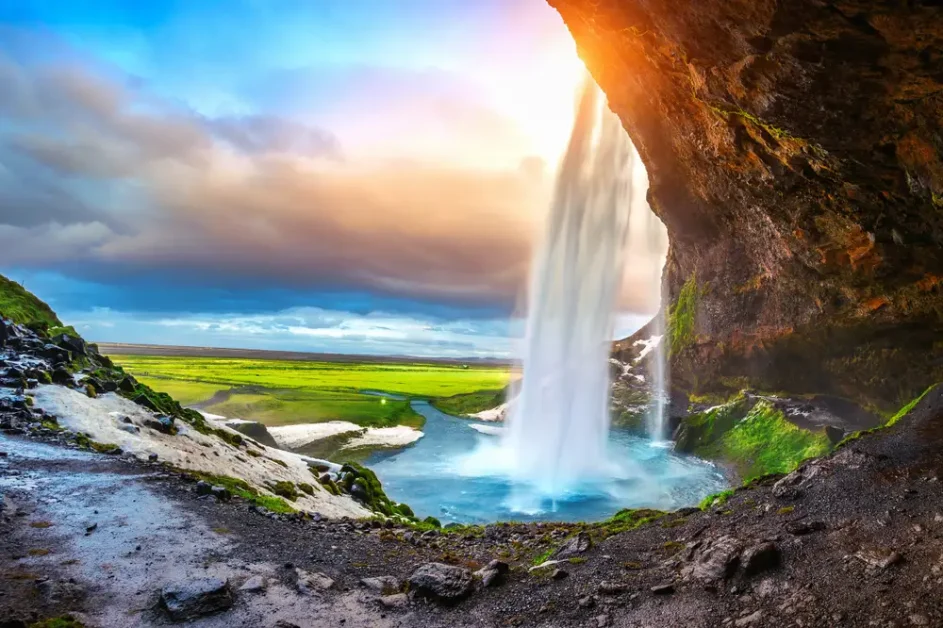
Iceland is a country that boasts stunning landscapes, unique culture, and endless adventure opportunities. If you are planning your trip to Iceland, you are probably wondering when is the best time to visit this magical destination.
In this guide, we will take an in-depth look at Iceland’s seasons and weather conditions to help you decide when to go. We’ll also explore the different personal preferences that can impact your experience in Iceland, such as spotting wildlife or hiking adventures.
Additionally, we’ll delve into major events and festivals that take place throughout the year so you can plan your visit accordingly. Lastly, we’ll address the question of travel costs and whether there is a ‘cheap’ season to visit Iceland. Join us on this journey as we discover everything you need to know about finding the best time to visit Iceland for an unforgettable experience!
Table of Contents
Understanding Iceland’s Seasons
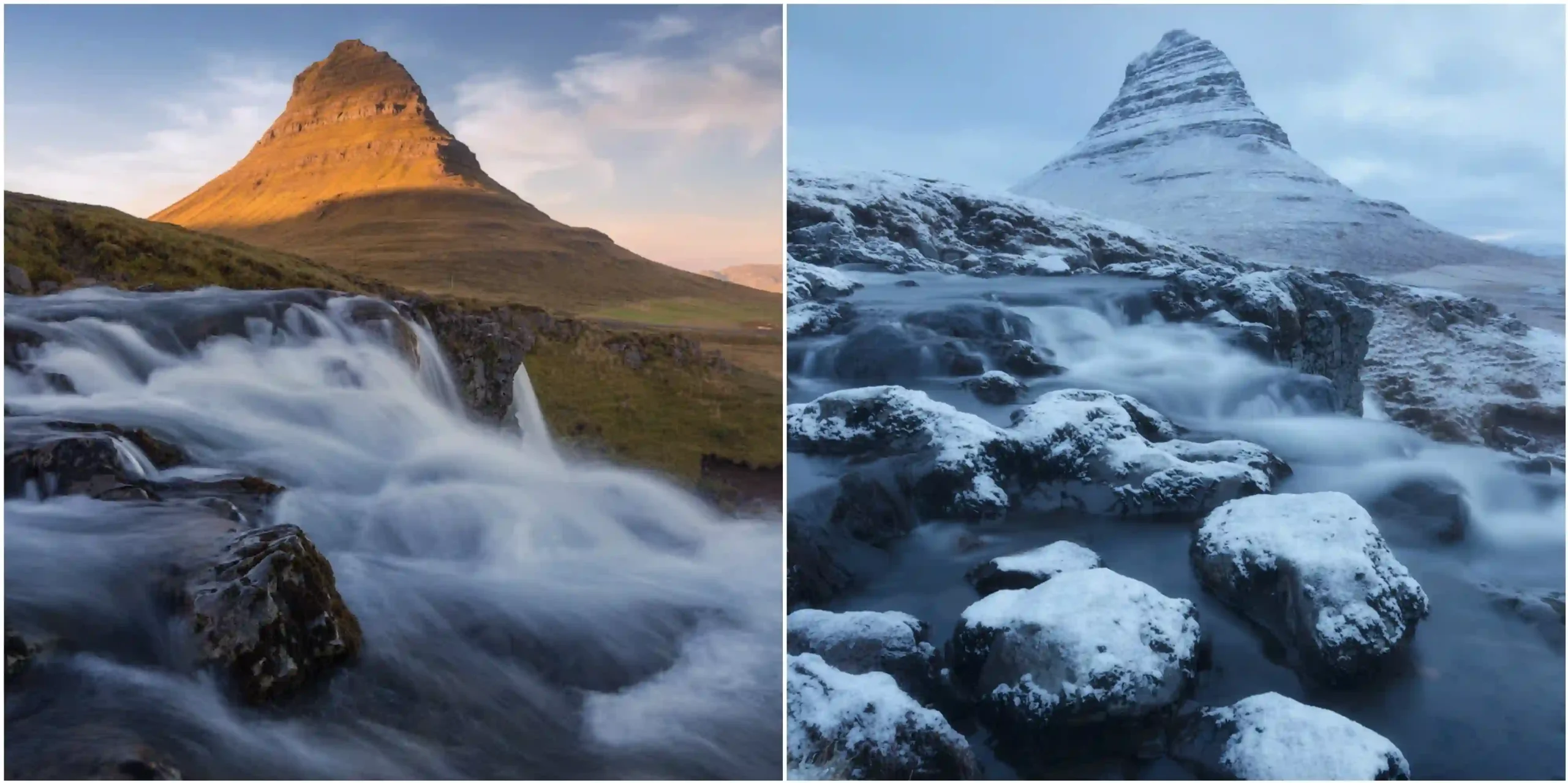
Iceland enjoys extended daylight hours in summer, while winter sees shorter days. The summer solstice brings the midnight sun phenomenon, and autumn showcases the golden hour, perfect for photography. As spring arrives, daylight gradually returns after the long winter nights.
This cycle offers unique opportunities for experiencing the diverse natural beauty of Iceland throughout the year, attracting visitors fond of geothermal activity, such as the famous Blue Lagoon, and those looking to explore the country’s stunning landscapes along the Ring Road.
Characteristic Features of Icelandic Winter
Iceland’s winter months showcase the mesmerizing natural phenomenon of the northern lights, offering a captivating display of colorful lights dancing across the night sky.
It’s the best time to explore ice caves, experience the country’s hot springs, and go whale watching.
Additionally, the festive spirit of the holiday season fills the air during the winter months in Iceland, making it a great time to visit for those seeking a unique holiday experience.
Characteristic Features of Icelandic Spring
Icelandic spring welcomes milder temperatures and the onset of the shoulder months, specifically May. It’s an ideal time to explore the country’s natural hot springs and embark on road trips in May and early June.
Visiting remote areas before peak season and driving on highland roads become more feasible due to favorable weather conditions. Embracing the spirit of Icelandic spring, one may choose to visit the Blue Lagoon, immerse in swimming pools, and witness geothermal activity.
Characteristic Features of Icelandic Summer
Iceland’s summer months present an excellent opportunity for horseback riding tours, a perfect time to explore the country’s geothermal pools, and the ideal season to experience the phenomenon of the midnight sun.
Additionally, visitors can take advantage of the extended hours of daylight during early August, making it a great time for boat tours around the country.
Exploring the natural hot springs and geothermal activity in the Reykjanes Peninsula is also a good idea during this period. Swimming in the famous Blue Lagoon is a popular activity during the Icelandic summer.
Characteristic Features of Icelandic Autumn
The characteristic features of Icelandic autumn offer a great time to experience the natural phenomenon of the northern lights. It’s also the perfect time for road trips along the south coast and to visit the country’s hot springs, including the famous Blue Lagoon.
Autumn in Iceland is also an excellent time for whale-watching tours and exploring the geothermal activity in the Reykjanes Peninsula. In early August, visitors can enjoy long hours of daylight for their adventures on the Ring Road and at the swimming pools.
Weather Considerations for Visiting Iceland
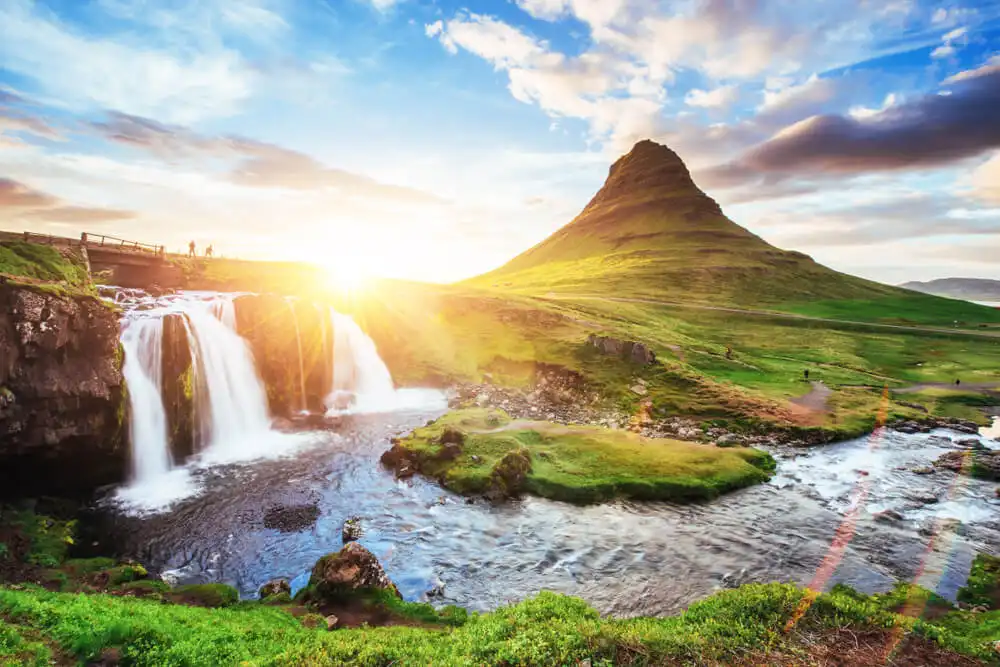
Iceland’s summer months offer optimal conditions for outdoor activities, making it a great time for horseback riding tours and boat trips around the country.
In contrast, the winter months bring colder temperatures, making it less favorable for outdoor activities but a good time to witness the northern lights.
Additionally, Iceland’s shoulder months of May and late June provide ideal weather for road trips, while winter may not be the best time for boat tours due to weather conditions.
Iceland’s Temperature Range
Iceland’s summer months boast warmer temperatures, creating the ideal environment for outdoor activities.
Conversely, the winter months bring colder weather, making it less favorable for outdoor pursuits. Additionally, late April and early March may experience warmer temperatures, offering another great time for outdoor activities.
Iceland’s shoulder months of May and late June provide excellent weather conditions for road trips. It’s important to note that the winter months in Iceland bring colder temperatures, resulting in unfavorable conditions for outdoor activities.
Iceland’s Precipitation Levels
Iceland’s summer months provide excellent weather conditions, ideal for road trips. Winter in Iceland may see higher precipitation levels, affecting road conditions. Late April and early March offer favorable weather, perfect for road trips.
The shoulder months of late May and early June may also experience good weather for road trips. Winter in Iceland may bring higher precipitation, impacting road conditions.
Dealing with Iceland’s Windy Climate
Iceland experiences windy conditions during different seasons, impacting various activities. In summer, the wind affects outdoor activities, while in winter, it influences road conditions. Late April and early March also see windy conditions impacting outdoor activities.
Additionally, the shoulder months of late May and early June may have windy conditions affecting outdoor activities, as well as the winter months affecting road conditions. These factors are important to consider for travelers planning activities in Iceland.
Exploring Iceland Based on Personal Preferences
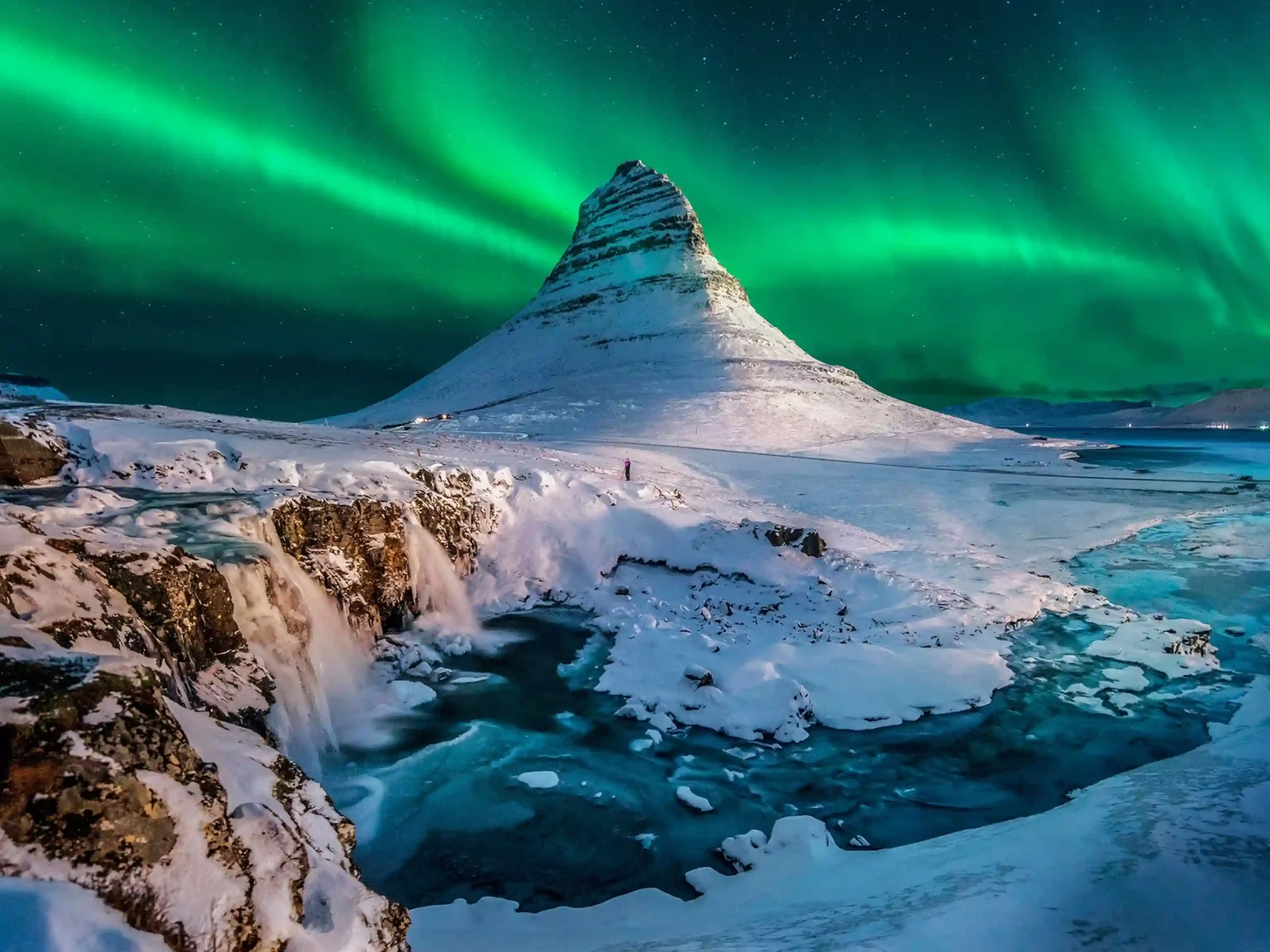
Exploring Iceland based on personal preferences offers diverse experiences throughout the year. The winter months are the best time for witnessing the northern lights, while summer is ideal for indulging in natural hot springs. Late April and early March are perfect for observing the northern lights.
Additionally, the shoulder months of late May and early June provide excellent road trip opportunities. In the summer, exploring Iceland’s geothermal pools is a must, offering a unique experience amidst stunning landscapes and geothermal activity.
Best Time to Visit Iceland for Northern Lights
Experience the captivating display of the aurora borealis during the winter months, offering a magical spectacle.
For the best chance of witnessing this natural phenomenon, plan your visit between late September and late March.
Alternatively, consider visiting in May and August to enjoy the summer solstice and the longest day of the year, perfect for capturing stunning photographs of the northern lights during the golden hour.
Best Time to Spot Wildlife in Iceland
Embark on summer boat tours in remote Iceland for the best whale-watching experiences. The warmer temperatures offer ideal conditions for wildlife sightings.
Explore the south coast for peak season whale watching and vibrant festive spirits during May and late June.
Witness the country’s vibrant wildlife amidst the geothermal activity, enhancing your experience of spotting wildlife. During early August, experience the lively wildlife scenes against the backdrop of Iceland’s natural beauty.
Best Time to Visit Iceland for Hiking Adventures
Experience the magic of Iceland’s hiking adventures during the summer months with long daylight hours, perfect for exploration.
Discover remote areas via highland roads and embrace clear skies and good weather conditions for your expeditions. After a long day of hiking, unwind in natural hot springs and geothermal pools, replenishing your energy.
Planning a visit? Aim for the warmer temperatures of early August for an unforgettable hiking experience. Embrace the great time to soak in the beauty of Iceland’s landscapes while creating unforgettable memories.
Timing Your Visit to Iceland’s Events and Festivals
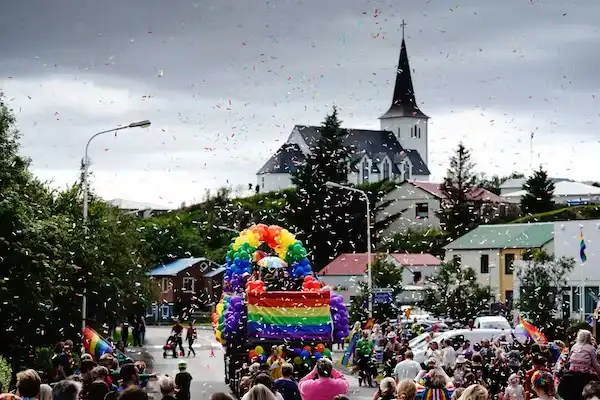
Immerse yourself in the country’s festive spirit during events and new year’s eve celebrations. Participate in the winter lights and dark music days festival in colder months.
Experience the vibrant city break atmosphere during festive events. Engage in cultural festivities and city life during new year’s eve celebrations. Enjoy geothermal pools and spa days in winter while exploring the city’s festivals.
Major Festivals in Iceland
Immerse yourself in Iceland’s festive spirit during the new year’s eve celebrations in late December, experiencing the vibrant city and cultural festivities.
Engage in the celebratory atmosphere and participate in the cultural activities that take place in various parts of the country.
The new year’s eve celebrations offer a great time to explore the rich cultural heritage of Iceland and engage in the city life amidst geothermal pools and spa days, creating a memorable experience during this time of year.
Sports Events in Iceland
Experience the vibrant sports events and activities during Iceland’s warmer summer months, engaging in horseback riding and exploring remote areas.
The festive shoulder months of May and late June also offer opportunities to participate in cultural festivities and sports activities both in the city and parts of the country, providing a great time for visitors.
Whether it’s swimming in the blue lagoon, enjoying the hot water springs, or witnessing geothermal activity, Iceland offers a unique sporting experience.
How Does the Time of Visit Affect Travel Costs in Iceland?
Travel costs in Iceland are affected by the time of your visit. Plan during May and late June for potential cost savings.
Consider road conditions and expenses for a road trip during these shoulder months. Budget accordingly, as costs may vary throughout the year. Explore cost-saving opportunities during May and late June.
Is there a ‘cheap’ season to visit Iceland?
Consider visiting Iceland during the shoulder months of May and late June for potential cost savings. Take into account road conditions and road trip expenses during these months.
Plan your budget accordingly, as travel costs can vary throughout the year. Explore the possibilities of cost savings during these shoulder months to make your trip more affordable.
Best time to visit Iceland – everything you need to know
Exploring Iceland offers a great time throughout the year, with each season bringing unique experiences and activities.
Whether it’s the relaxing blue lagoon or the bustling Iceland Airwaves, there’s always something to do. Swimming pools and hot water are available year-round, while early August gives you maximum hours of daylight for exploration.
Consider the geothermal activity at Reykjanes Peninsula and the scenic Ring Road for a memorable trip. Plan wisely, and you’ll have an unforgettable adventure in this majestic country.
When is the best time to visit Iceland for good weather?
For the best weather in Iceland, plan your visit during the warmer summer months. Enjoy clear skies and good weather conditions perfect for outdoor activities like road trips, hiking, and adventures. Choose the summer months for the best weather experience.
When is the peak season in Iceland?
The peak season in Iceland occurs during the summer months, offering long daylight hours for road trips and the opportunity to witness the mesmerizing midnight sun. With good weather conditions, it’s an ideal time to explore remote areas and enjoy activities like boat tours, whale watching, and horseback riding.
Experience the magic of the Northern Lights in Iceland
In the winter months, witness the aurora borealis, a natural phenomenon, in Iceland. Clear skies during the colder months provide perfect conditions for the northern lights, with longer nights increasing the chances of seeing the lights.
Many opt for northern lights tours during the darker months of late November to early February, providing the best opportunity to view this stunning spectacle amidst the geothermal activity. It’s a great time to experience the magic of the Northern Lights in Iceland.
In conclusion, the best time to visit Iceland depends on your personal preferences and interests. If you want to experience the stunning Northern Lights, the best time to visit is during the winter months when the nights are longer. For wildlife enthusiasts, the summer months offer the best opportunity to spot unique Icelandic wildlife.
If you’re interested in hiking adventures, the shoulder seasons of spring and autumn provide milder weather and fewer crowds. Additionally, timing your visit to coincide with Iceland’s events and festivals can add a unique cultural experience to your trip.
Keep in mind that travel costs may vary depending on the season, with the peak tourist season being the most expensive. Ultimately, choose a time that aligns with your desired experiences and make the most of your visit to this magical country.
Latest Posts:
10 Must-Visit Places Near Diamond Beach Iceland
23 Best Bachelorette Party Destinations Around the World
14 Most Mysterious Places in the World

Ferona Jose is a passionate travel writer and blogger at Travelistia. She has traveled throughout Europe, Asia and the Americas. Her writing focuses on cheap travel destinations, travel experiences, cultural insights, and travel hacks.
Leave a Reply Cancel reply
Your email address will not be published. Required fields are marked *
Save my name, email, and website in this browser for the next time I comment.
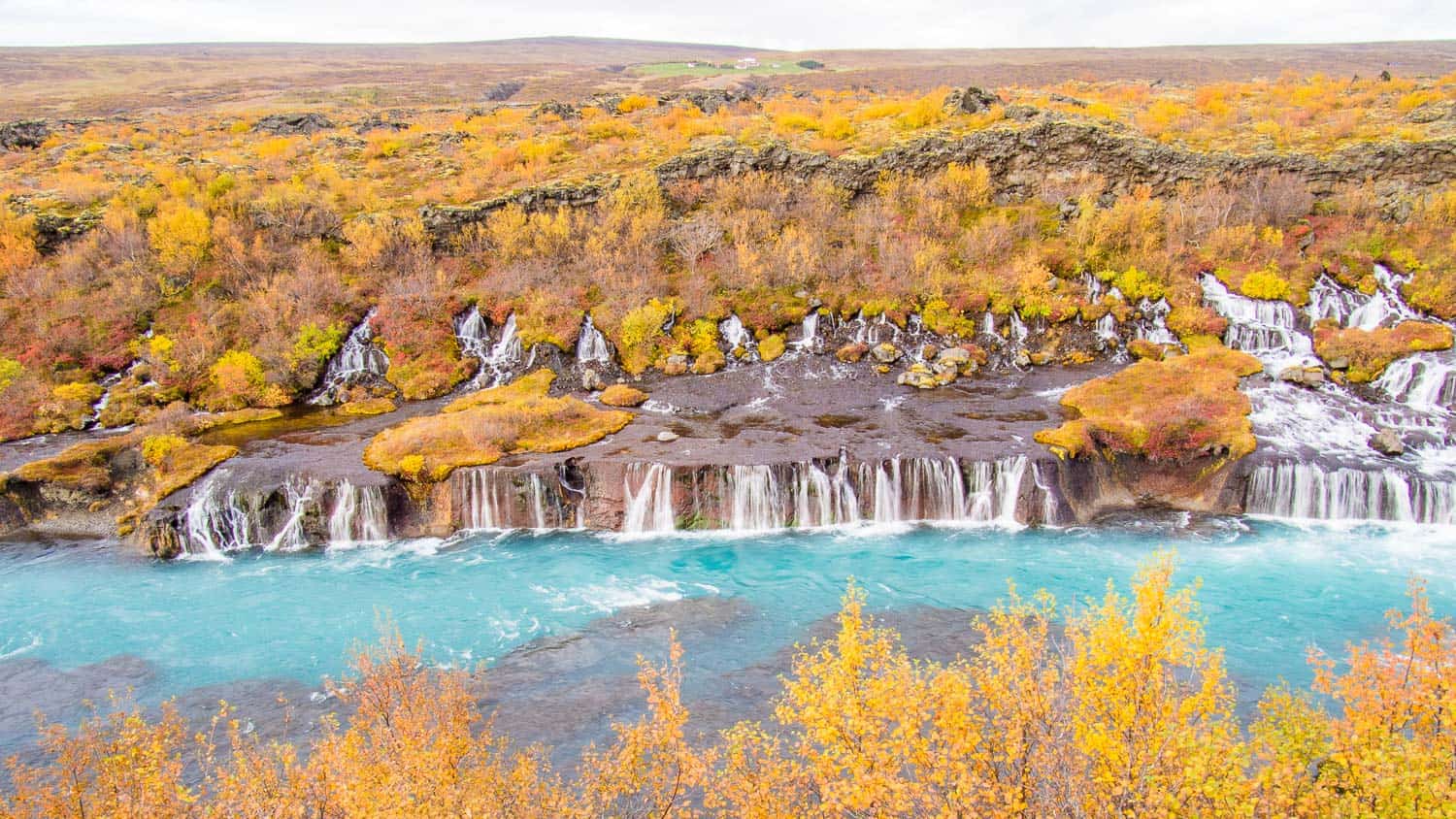
Visiting Iceland in September: What to Expect and Things to Do
This page contains affiliate links. Please read our disclosure for more info.
We travelled to Iceland in September and it turned out to be one of the best times to visit Iceland.
We had fewer crowds and lower prices than in the summer and got to see the magical northern lights and beautiful autumn colours.
In this post, I share what to expect when visiting Iceland in September including the weather, road conditions, what to wear, things to do, and the pros and cons of travel at this time of year.
At the end, there is a handy map with everything mentioned.
Key Facts About Visiting Iceland in September
Our september iceland itinerary, daylight hours in iceland in september, can you see the northern lights in iceland in september, weather in iceland in september, what to wear in iceland in september, road conditions and closures, reduced crowds, opening hours, wildlife in september, things to do in iceland in september, visiting iceland in september map, is september a good time to visit iceland, more iceland tips.
- There are 12 to 14 hours of daylight.
- You can see the northern lights .
- The weather is beginning to feel wintery . We had temperatures of –2ºC (28ºF) to 5ºC (40ºF).
- Roads are usually clear of snow (except in the uninhabited highlands), but you may see some snow starting to fall on the mountains.
- You can snowmobile (and see lots of snow) on the glaciers.
- It’s less crowded and cheaper than in the summer.
- It’s fall/autumn in Iceland and parts of the country have trees and vegetation that turn beautiful shades of orange and red. There aren’t a huge amount of trees so you won’t see this everywhere.
- Some museums, cafes, and activities in remote areas are closed .
- It’s not the best time to see whales and puffins, but we did spot many seals .
Don’t forget to buy travel insurance for your Iceland trip and make sure it covers Covid-19.
An excellent budget option is SafetyWing (kids under 10 are free). If you want cancellation cover as well, check out Heymondo .
Back to Contents
Our 12-day road trip in September focused on the western side of the island including the stunning Snæfellsnes Peninsula and remote Westfjords .
See our Iceland itinerary for more details on where we went and stayed.
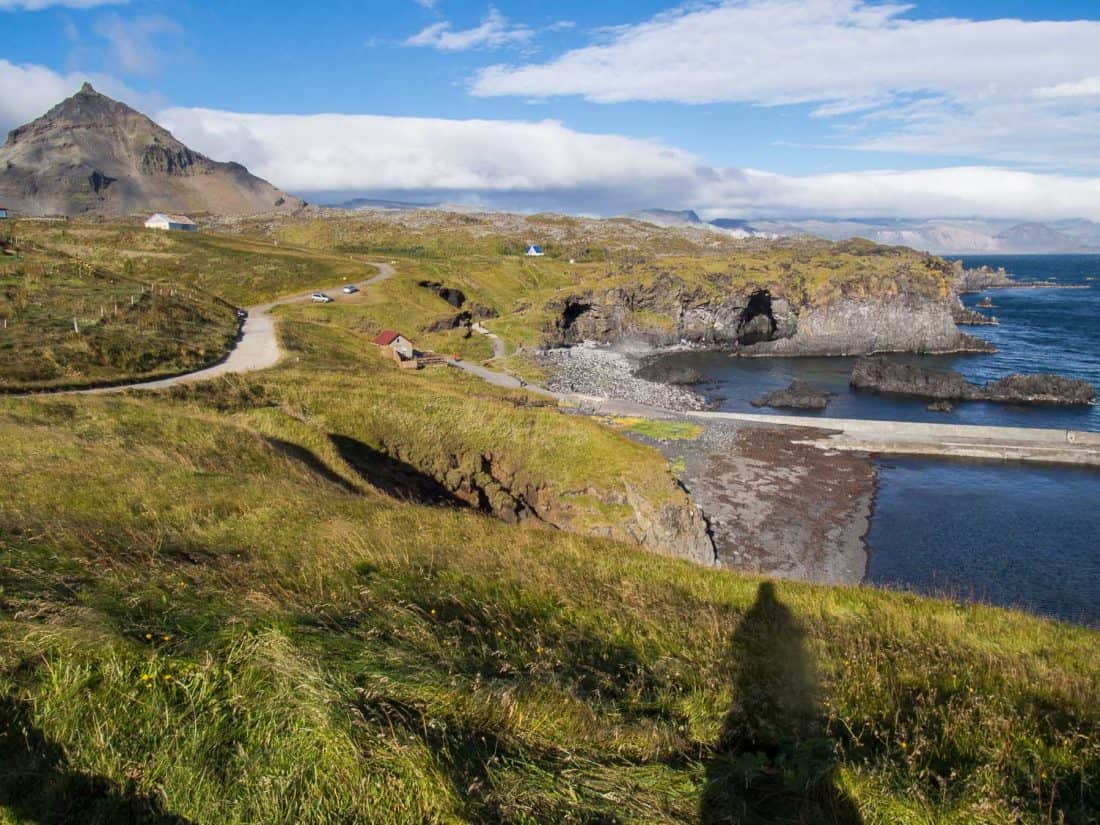
The amount of daylight in Iceland varies widely depending on the time of year you visit.
In the summer the sun barely sets, but in the winter it only rises for a few hours a day.
While both of these seasons would be interesting to experience, visiting in September is more practical for touring as you have around 12 to 14 hours of daylight.
This gives you plenty of time for exploring during the day, you can see sunrise and sunset at reasonable times, and you won’t be kept awake by the midnight sun.
Daylight hours reduce fairly rapidly during the month. In Reykjavik at the very beginning of September, the sun rises at around 6.15am to 6.30am and sets from 8.45pm to 8.30pm giving 14 to 14.5 hours of daylight.
By the end of the month, the sun rises from 7 am to 7.30am and sets from 7.30pm to 7 pm with 12 to 12.5 hours of daylight.
In the far north daylight hours will be slightly longer.
The autumnal equinox takes place in September when the length of day and night is nearly equal. In 2024 and 2025, the equinox will be on 22 September.
One of the things we loved about Iceland was how gorgeous the light is.
Even in the middle of the day the glowing light made it feel like a permanent golden hour. It’s fantastic for photography.
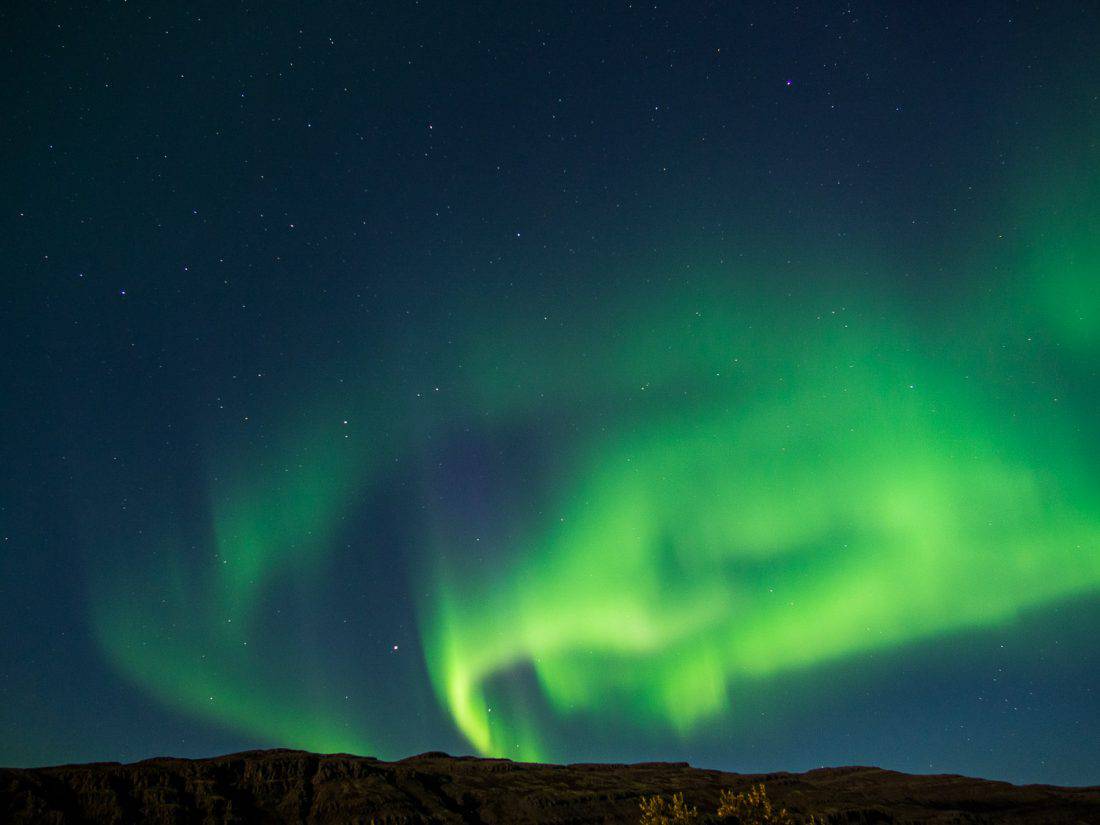
Yes! One of the best reasons for visiting Iceland in September is the chance to see the northern lights (aurora borealis).
They only appear from September to mid-April, and you’ll have a better chance towards the end of September, especially around the equinox (although there were sightings at the end of August this year).
There are no guarantees that you’ll see the aurora borealis at any time of year. We used the Aurora app and Vedur website to check our chances of seeing the lights each day.
You need cloud-free, dark skies away from light pollution, so I recommend spending at least a few nights away from a town.
You can also take a Northern Lights tour from Reykjavik , but it’s not necessary if you’ve rented a car.
We saw the northern lights outside our cabin at Bjarkarholt Guesthouse in the southern Westfjords the day before the equinox and it was stunning!
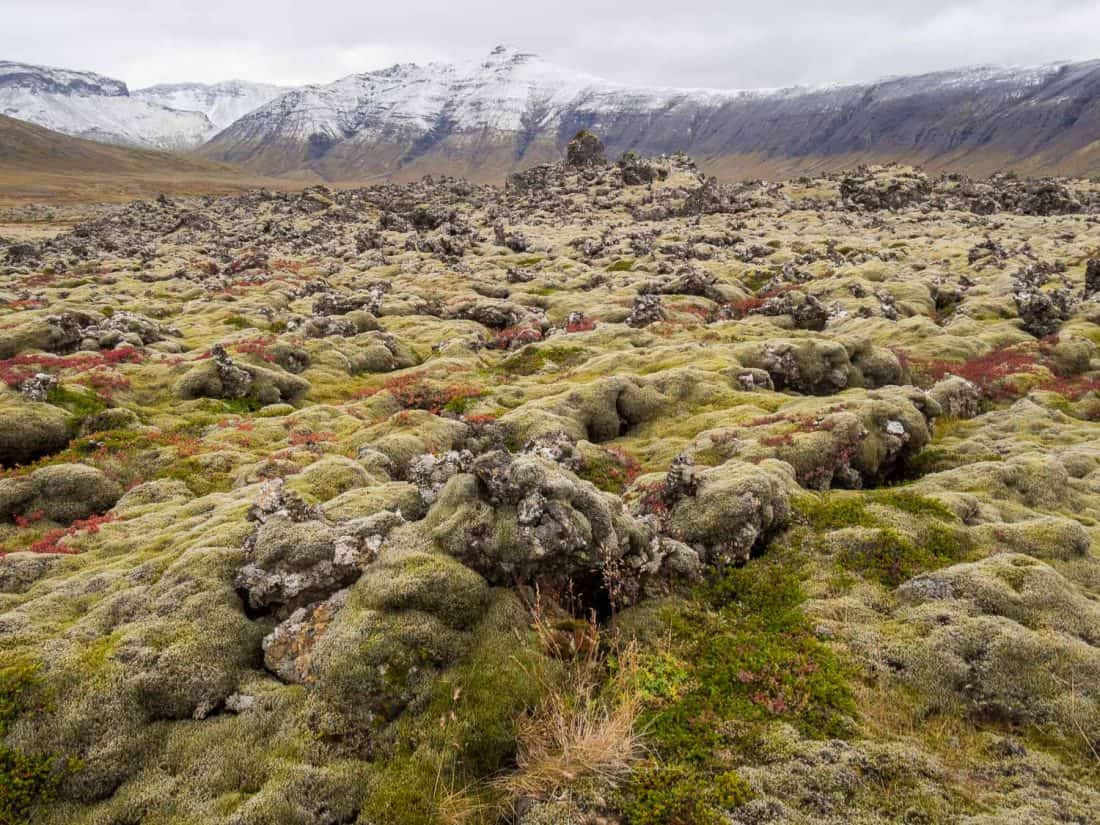
We visited Iceland in late September and the weather was distinctly wintery—it felt more like England in January.
We had temperatures ranging from –2ºC (28ºF) at night to 5ºC (40ºF) during the day.
It can be warmer than we experienced with the average maximum 11ºC (53ºF) and the minimum 6ºC (44ºF), but the wind-chill factor can make it feel cooler.
In 12 days we had a mix of sunny and cloudy days with two days of heavy rain that we used as an excuse for much-needed days off. The wind was often powerful.
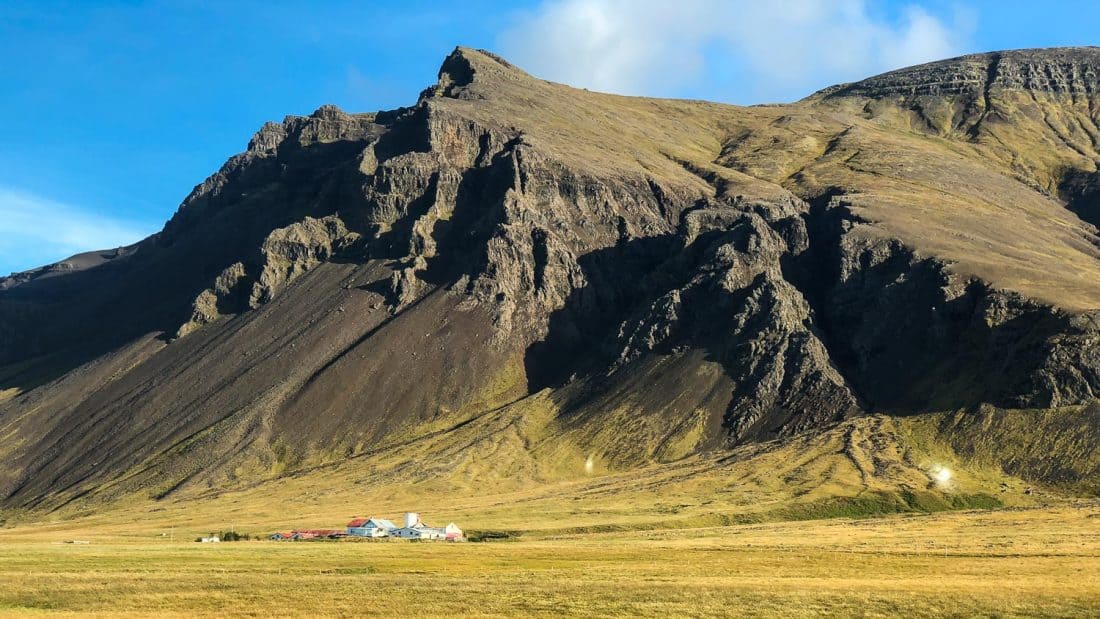
We packed plenty of layers and it never felt too cold to explore. Even in the summer, you can’t guarantee good weather—it’s notoriously unpredictable.
The great thing about September was that we got to see the first snow appearing on the mountains.
One morning we woke in our cabin at Tradir Guesthouse (now closed) on the Snæfellsnes Peninsula and the mountain next to it was covered in snow.
We also drove through a few snow showers on mountain passes in the Westfjords.
Weather changes fast in Iceland, so it’s important to check the Vedur website or app for weather forecasts during your trip.
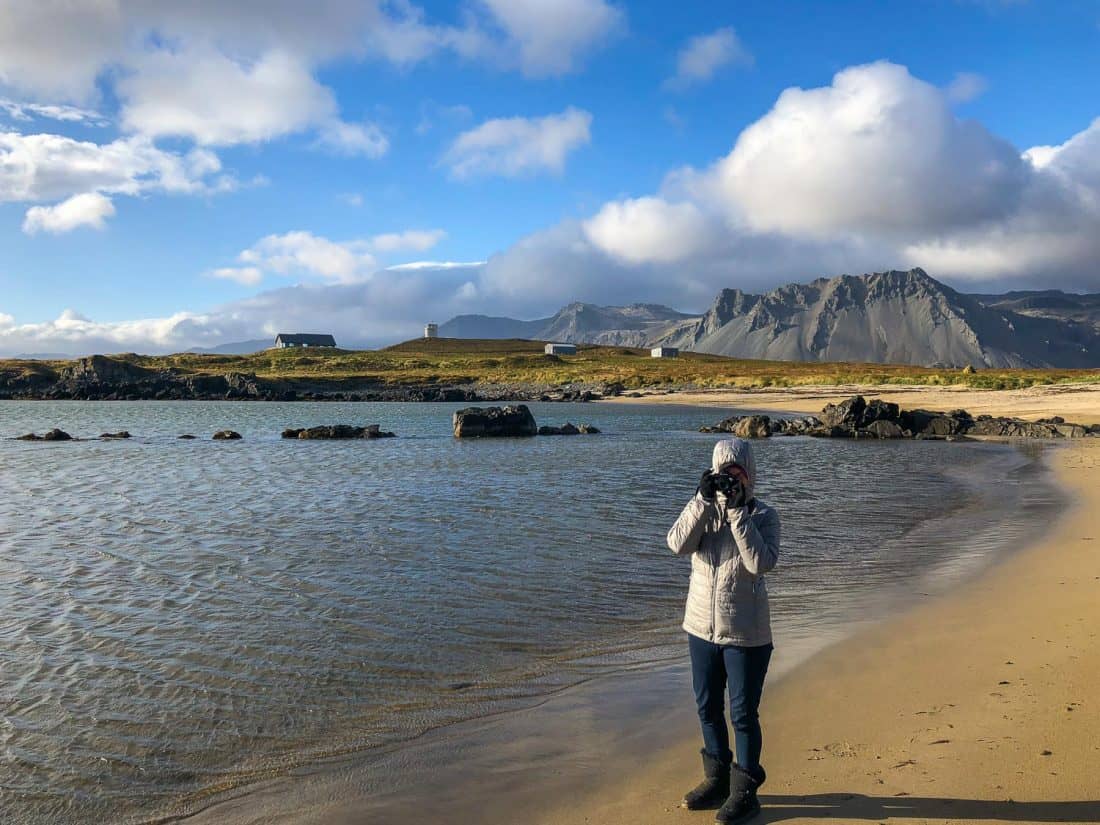
At any time of year in Iceland, you’ll want to pack layers to be prepared for the changeable weather.
Other essential items are waterproof hiking shoes or boots, a waterproof jacket (and ideally trousers), a swimsuit for the many hot springs and warm swimming pools, and sunglasses (the sun is often low).
On a typical day, I wore a long sleeve base layer ( Icebreaker merino is best), sweater (or two), fleece, lightweight Patagonia down jacket , thermal leggings under jeans, hat, gloves, thick Smartwool merino wool socks , and waterproof hiking shoes.
Simon usually wore a t-shirt, long sleeve Icebreaker merino wool top , fleece, Mountain Hardwear ultralight down jacket , Bluffworks trousers or jeans, hat, gloves, merino socks, and waterproof hiking shoes.
He often wore waterproof over trousers as extra warmth for his legs (thermal underwear would have been a good addition).
We managed to pack everything we needed in one carry-on backpack each.
See our Iceland packing list for what to pack for Iceland in September.
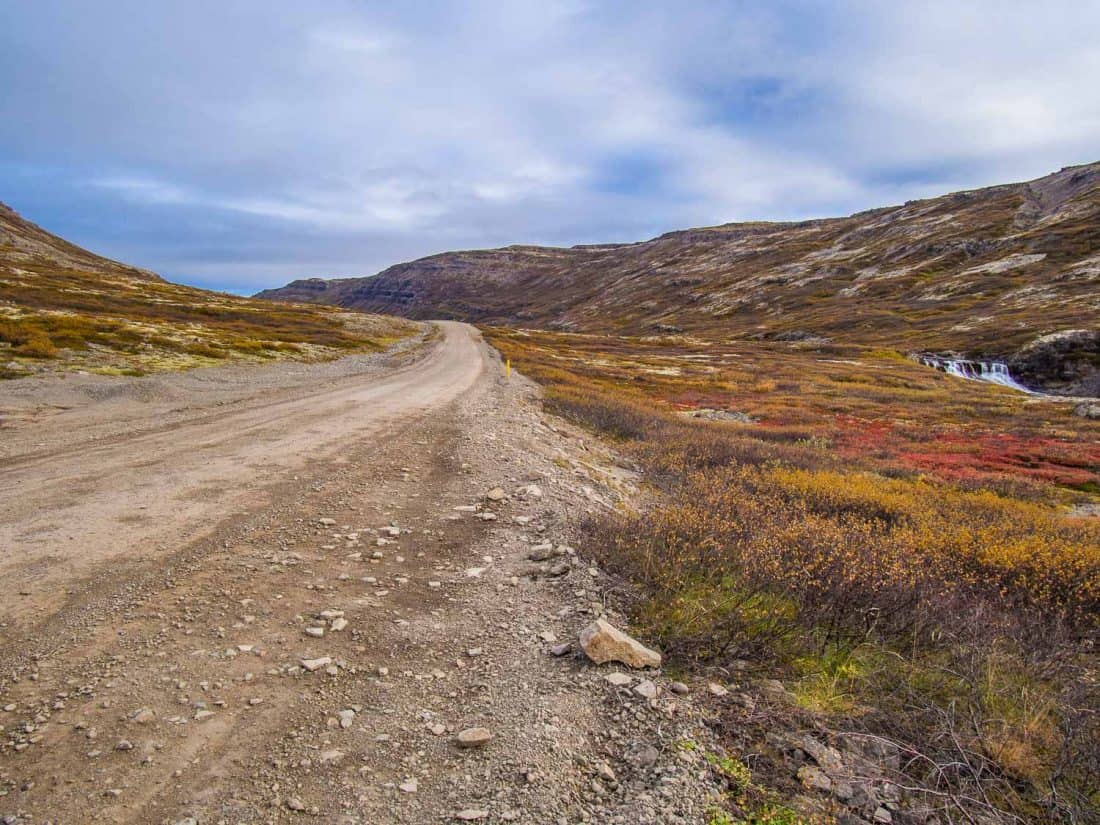
Although winter in Iceland brings guaranteed snow, it also means that roads become impassable or are icy and difficult to drive.
In September almost all roads were open and easily drivable with no ice.
The exception is the uninhabited highlands in the centre of the island which can only be visited in the summer months.
Most first time visitors to Iceland focus on Reykjavik, southern Iceland, or driving the Ring Road around the whole island and these are easily visited in September.
It’s also the last month to safely visit the Westfjords (which we highly recommend) as in October some roads start to close after snow.
It’s important to check Road.is for road conditions every day in Iceland before setting out.
Do you need a 4WD in September? Technically no, as the roads should be clear. We decided to rent a 4WD, though, as we travelled to the Westfjords which has a lot of rough gravel roads.
If your budget allows, a 4WD is worth it if you are venturing far from Reykjavik for added comfort and security. If not, drive carefully and slowly, and a 2WD should be fine.
We use Booking.com Car Rentals to find the best deals.
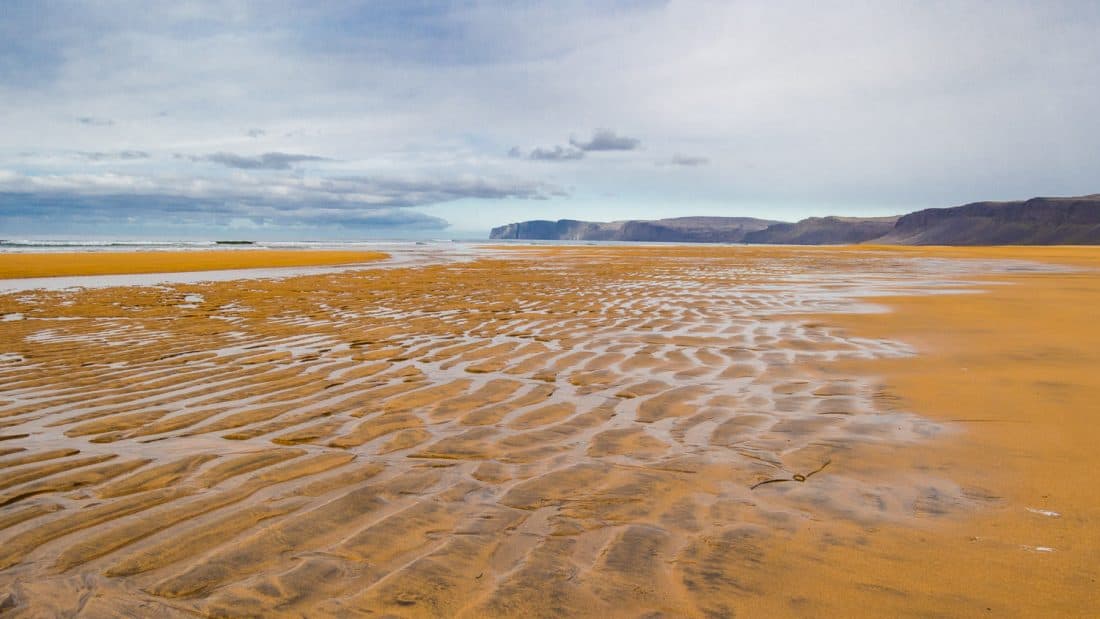
Iceland has become hugely popular in recent years and the busiest months are in the summer, especially July and August when Icelanders also go on holiday.
In summer you’ll need to book accommodation far in advance, prices are higher, and attractions are crowded.
September sees lower crowds and prices and you can find last-minute accommodation—we booked three weeks in advance.
I recommend using Booking to find hotels and cabins and Vrbo for cabins and other self-catering accommodation.
Popular attractions like the Blue Lagoon and Golden Circle will still be crowded, but not as bad as in the summer.
We created an off-the-beaten-track Iceland itinerary and never found the crowds overwhelming.
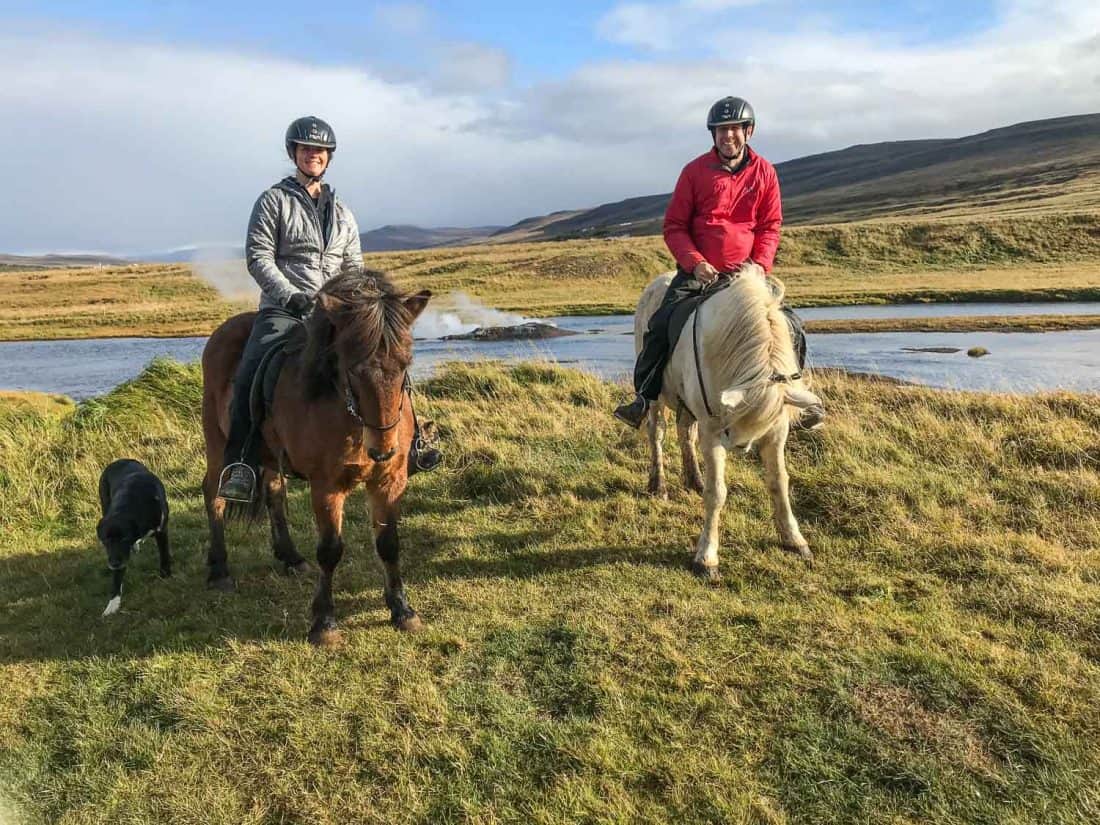
The biggest downside of travelling in Iceland in September is that some museums, cafes, and tourist activities (like horse riding) are closed outside of the June to August summer months.
This only really affected us in the remote Westfjords area (and to a lesser extent in the Snæfellsnes Peninsula) which sees fewer visitors.
Cafes and attractions in the more visited areas of Iceland near Reykjavik will still be open.
For example, we couldn’t find a riding stable open near Ísafjörður in the Westfjords, so we went to Sturlureykir Horse Farm near Husafell on our way back to Reykjavik instead.
I wouldn’t let this stop you visiting Iceland in September, but it is something to be aware of when planning your trip.
That great sounding cafe in a remote location will likely only be open in the summer, so pack lunch instead.
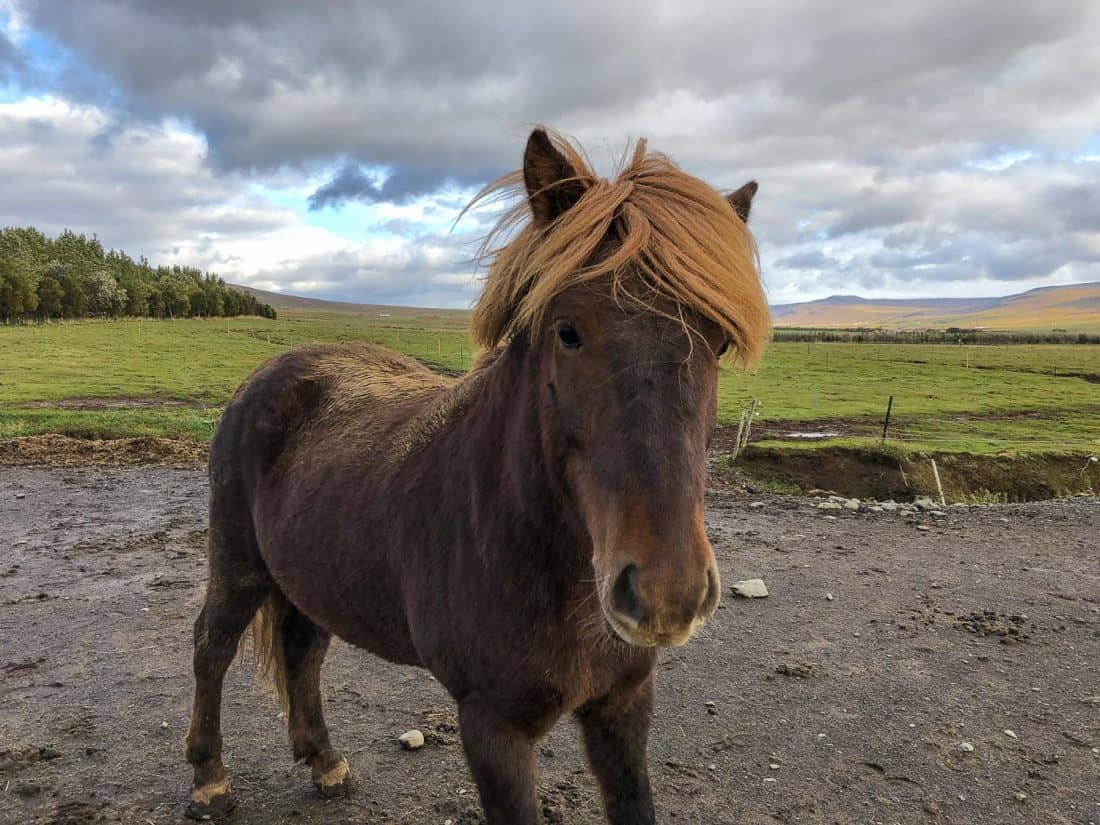
September is not the best time to visit Iceland for wildlife viewing.
On the plus side we saw seals on multiple occasions (at Ytri Tunga beach on the Snæfellsnes Peninsula and in the Westfjords), an Arctic fox at Látrabjarg cliffs (a rare sight!), and many horses and sheep.
But it’s the wrong time of year for many animals. The best time to see whales in Iceland is from June to August and the puffin season is from April/May until August.
We went to the Látrabjarg cliffs in the Westfjords, which are famous for a huge bird colony (including puffins), but at the end of September we didn’t see a single bird.
The best place to see Arctic foxes is the remote Hornstrandir , but ferries only run there in the summer. You can take a tour in September but they are very expensive.
There are plenty of things to do in Iceland in September. Here are some of our favourites:
Drive the Snæfellsnes Peninsula
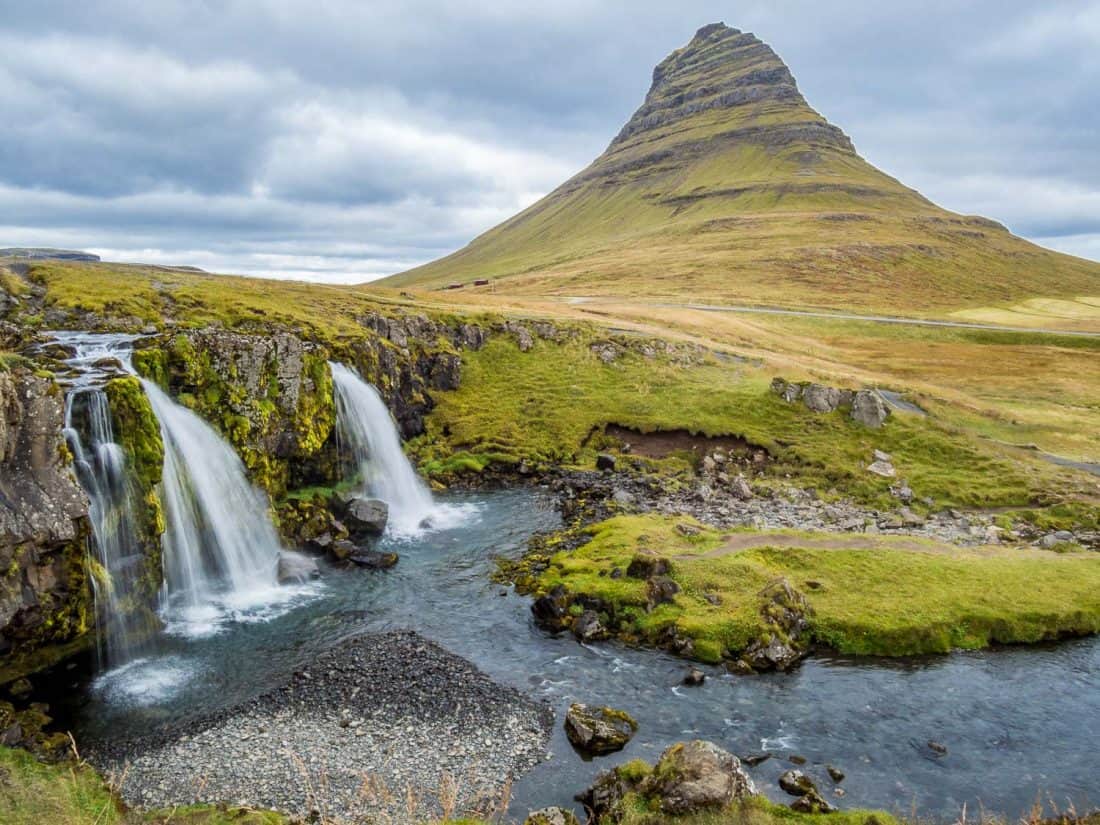
There is so much to see on this gorgeous peninsula just two hours from Reykjavik including volcanic craters, lava fields, a glacier, waterfalls, fjords, hot springs, black and golden sand beaches, and cute fishing villages.
We loved seeing the first snow appear on the mountains at the end of September.
You can self-drive as we did or take a tour from Reykjavik . Although it’s possible to see the highlights in a day, I highly recommend spending a couple of nights in the area as there’s so much to see.
See our picks of the best places to visit on the Snæfellsnes Peninsula .
Hraunfossar Waterfall
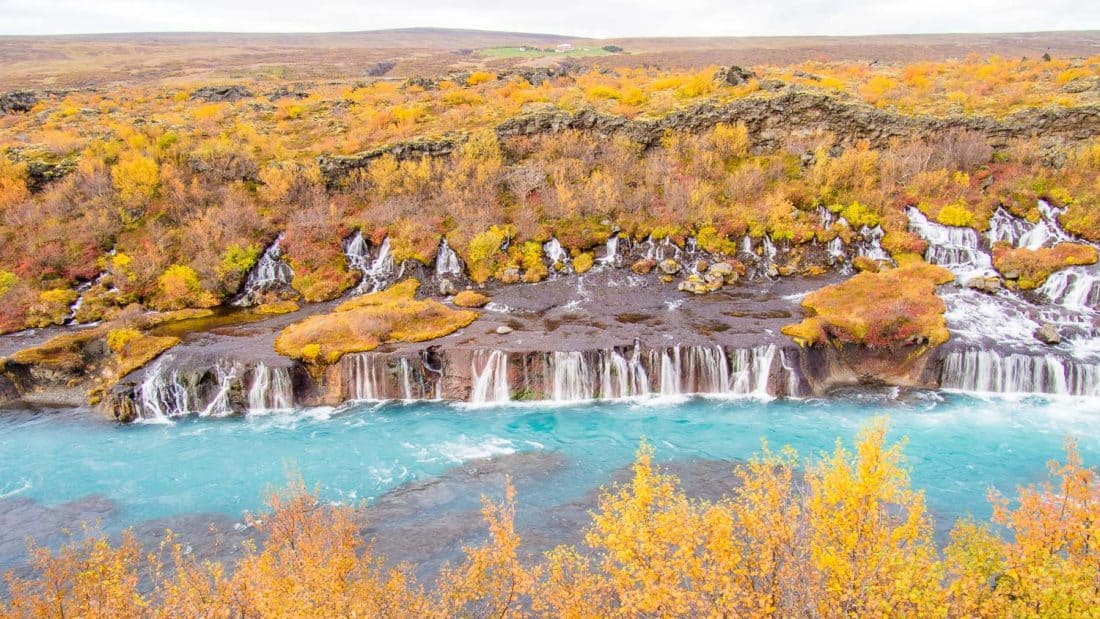
Hraunfossar waterfall is especially beautiful in the autumn when the bushes above it turn shades of orange.
It’s a wide rather than tall waterfall with lots of small falls gushing into the turquoise river below. You can walk to various viewpoints and to the neighbouring waterfall Barnafoss .
It’s near Husafell which is a good base for trips to the Langjökull glacier, and there are more trees in this area than most parts of Iceland so you can enjoy the autumn foliage.
Snowmobiling and Ice Cave on Langjökull Glacier
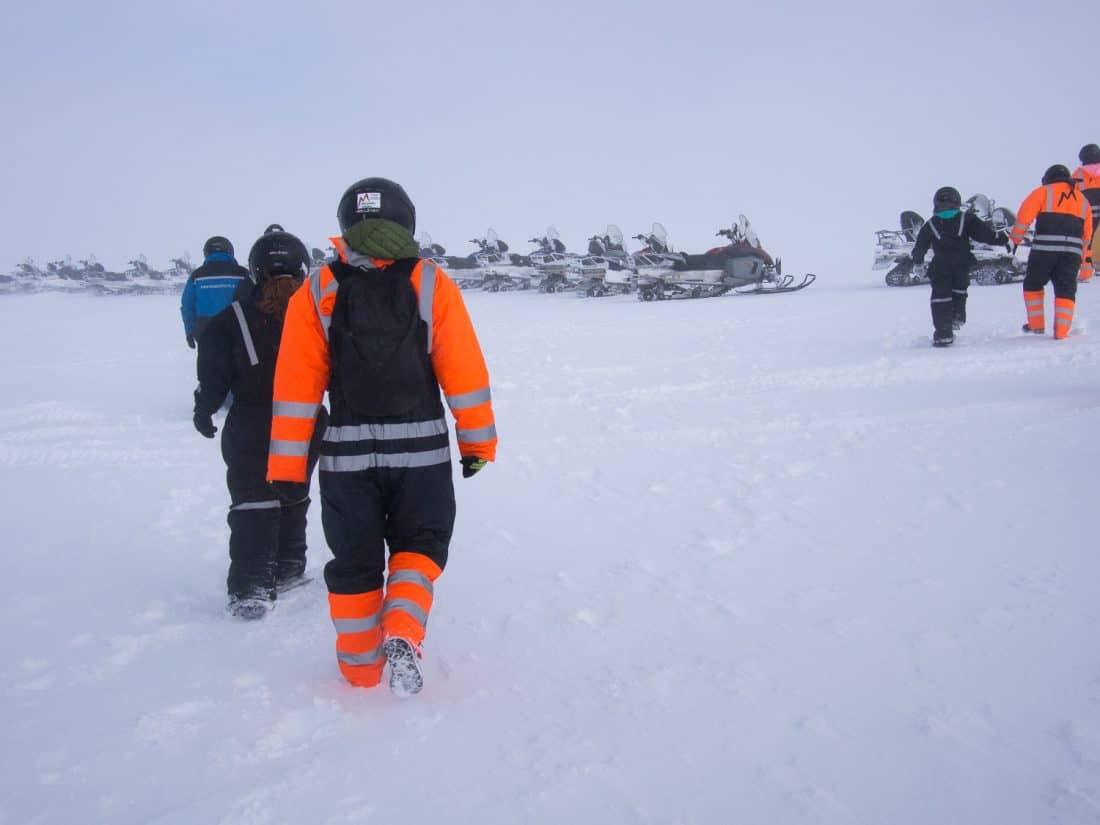
Snowmobiling can be done year-round on Langjökull Glacier , but September is better than the summer as snow will already have started falling.
It was snowing while we were up there and we enjoyed having a true wintery experience.
September is too early for the natural ice caves, but you can visit the humanmade ice tunnels at Into the Glacier.
We did an ice caves and snowmobile trip with Mountaineers of Iceland. It was fun but pricey and crowded, so you could skip it if your budget is tight.
You can also book the Langjökull Glacier Ice Cave Tour and Glacier Snowmobile Tour separately.
Northern Lights
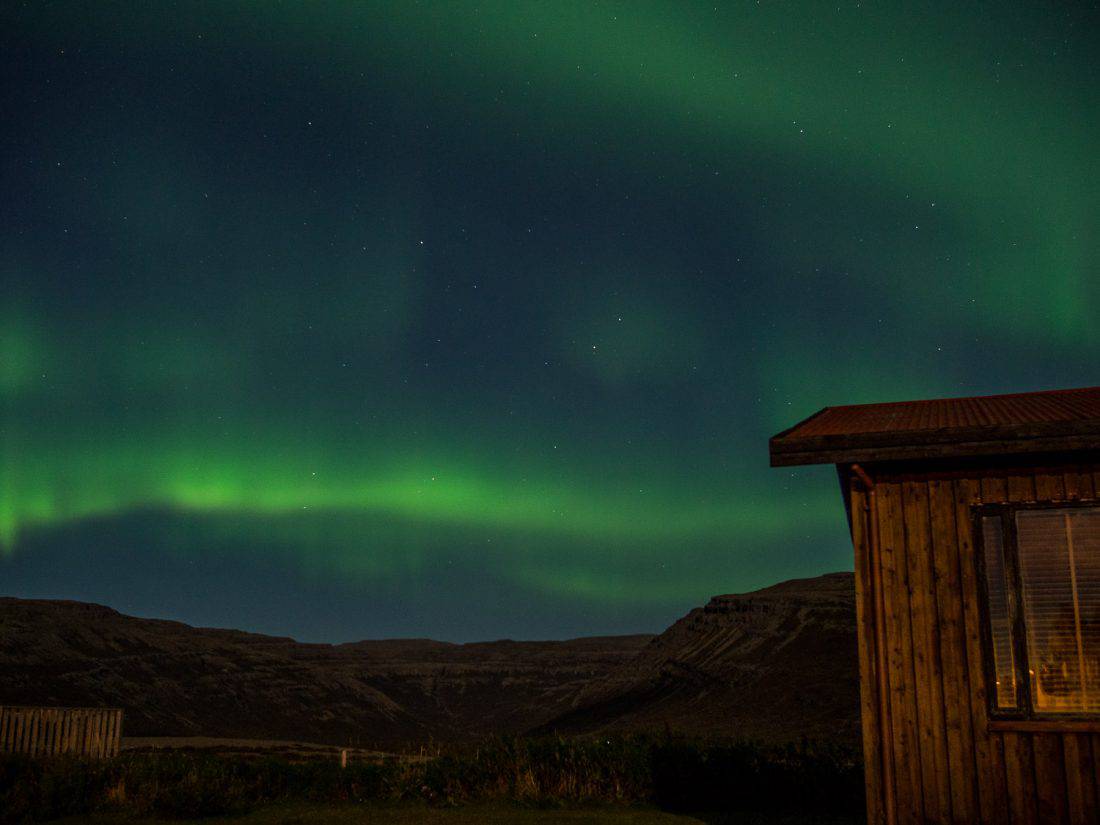
One of the most exciting things about travelling to Iceland in September is the chance to see the northern lights.
You need to get away from light pollution, so you can take a northern lights tour from Reykjavik or stay in the countryside.
We saw the aurora from our Bjarkaholt cabin in the Westfjords.
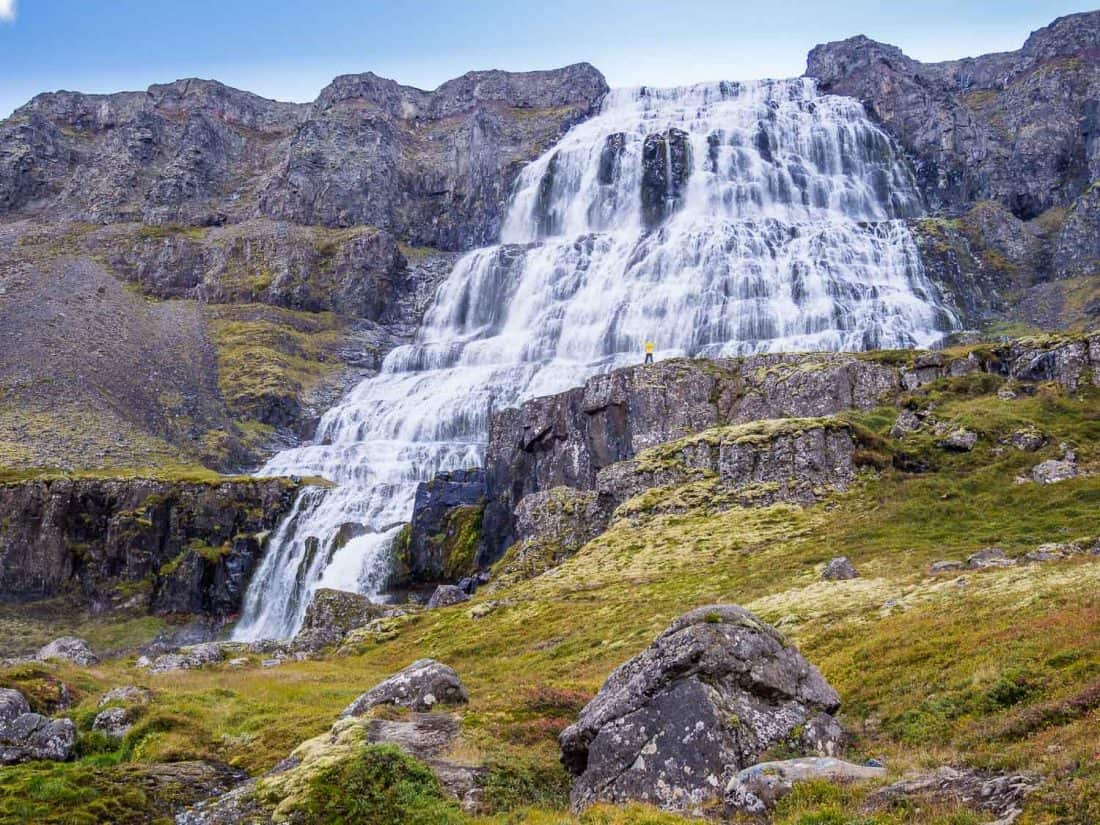
The remote Westfjords in the far northwest of Iceland is best visited before snow closes the mountain passes.
September is ideal as roads should be clear but it’s quieter than the summer months (although some cafes and attractions are closed).
Highlights include Dynjandi waterfall (my favourite in Iceland), Rauðasandur red sand beach , the isolated Strandir Coast , and the cute town of Ísafjörður .
See our Iceland itinerary for details on where we visited in the Westfjords.
Hot Springs and Outdoor Pools
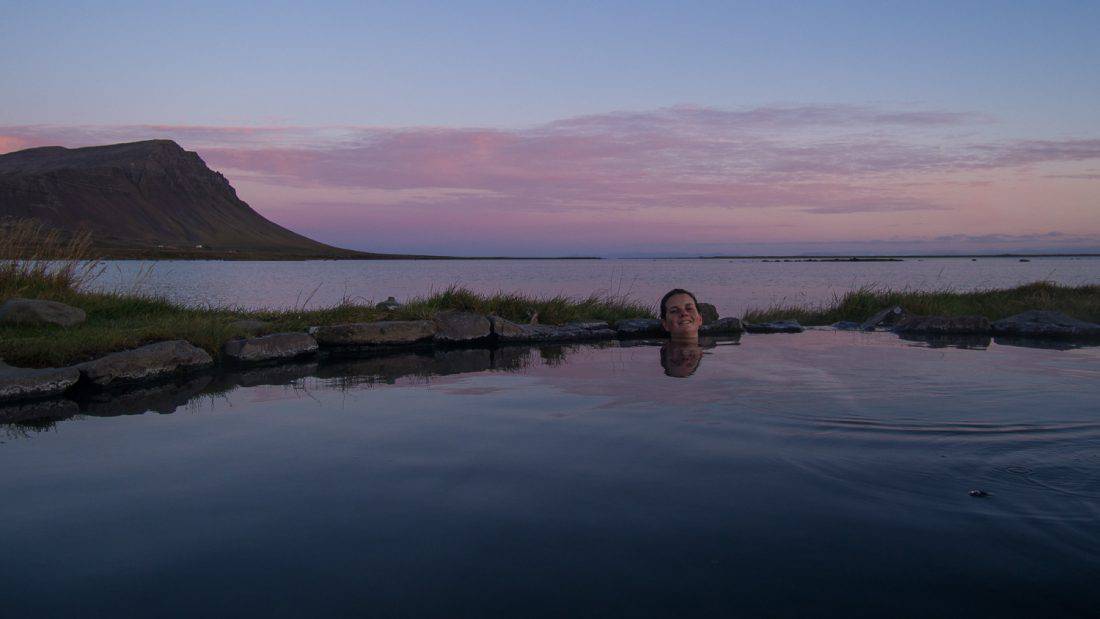
September is cold enough that you’ll really appreciate a soak in a hot spring.
There are many springs and pools all over Iceland. The Blue Lagoon is the most famous, but it’s busy, expensive, and must be booked in advance.
We preferred quieter experiences in the Westfjords where we enjoyed the sunset while relaxing in a hot pot overlooking the sea at Birkimelur Swimming Pool .
Another highlight was swimming in Krossneslaug , an outdoor geothermal swimming pool overlooking the sea.
In September we had it entirely to ourselves and felt like we’d reached the end of the world as we looked out over the waves crashing onto the pebble beach below.
Swimming in a warm pool when it’s cold outside was surprisingly wonderful—don’t miss it!
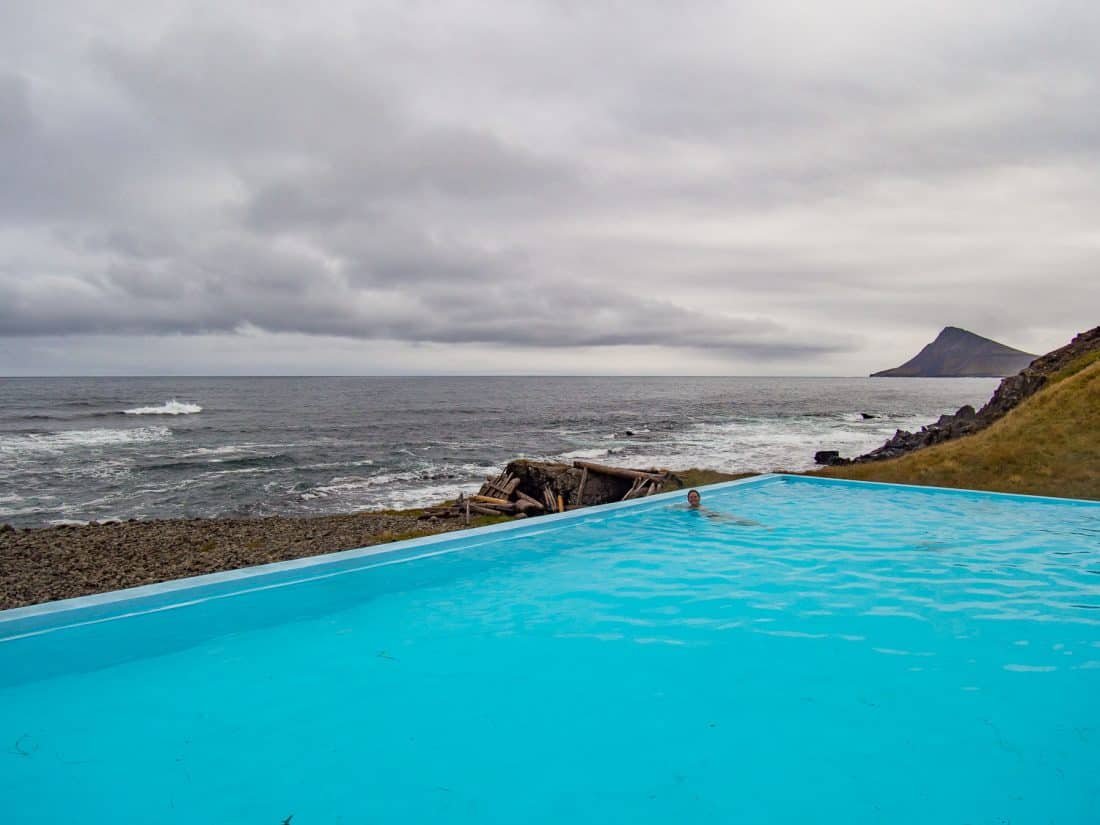
Horse Riding
Icelandic horses are strong and adorable and have a unique smooth gait. Although a few stables close outside the summer, you’ll still have plenty to choose from in September.
We rode at the family-run Sturlureykir Horse Farm near Husafell. The Snæfellsnes Peninsula is another good area where you can ride on black sand beaches and through lava fields.
Go to a Festival
There are a number of festivals and events that take place in Iceland in September, mainly in Reykjavík, some just outside.
Here are a few if you find yourself in the capital at the right time:
- Reykjavík International Film Festival – Takes place in late September each year. In 2024 the dates are 26 September to 6 October.
- The Night of Lights Festival – A family-friendly festival held at the start of September in Reykjanesbær (not too far from Reykjavík) that celebrates the best of local art and music.
- Reykjavik Jazz Festival – Sometimes held at the end of August or the start of September, performances are held in a variety of venues including parks and record stores.
- Extreme Chill Festival – A long-running music festival that celebrates experimental music and visual arts showcasing both Icelandic and international artists.
I would visit Iceland at any time of year, but September is an especially wonderful time to visit.
It is the perfect mix of summer and winter, lower prices and crowds, and the chance to see the magical northern lights.
What’s your favourite time of year to visit Iceland?
Read our other Iceland posts to help you plan your trip:
- Planning a Trip to Iceland: DOs and DON’Ts
- Iceland Itinerary: Off The Beaten Path on a Snæfellsnes and Westfjords Road Trip
- The Ultimate Iceland Packing List for Men and Women (Carry-On Only)
- 14 Places Not to Miss on the Snaefellsnes Peninsula
- How Much Does an Iceland Trip Cost? Our Road Trip Budget
- 10 Best Books About Iceland to Read Before You Visit
Enjoyed this post? Pin it!
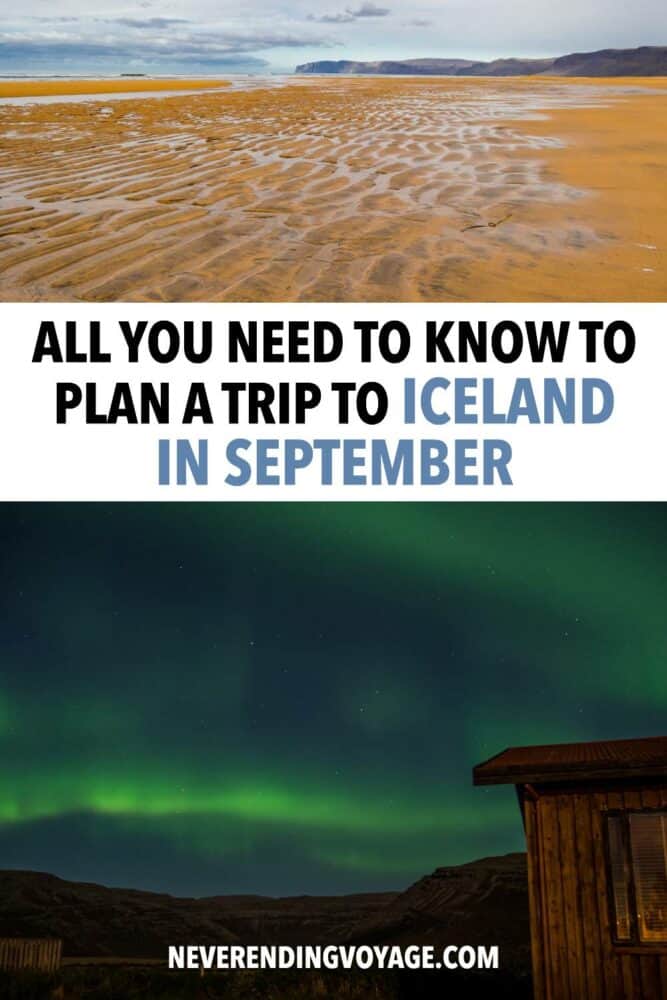
13 Comments
Hi Erin, Great info, stunning photos and I like that you are providing information for the month of September as it is not easy to find the information of what is open and closed. We are thinking of going for 2 weeks. We hope to visit Reykjavik, Snaefallus Peninsula, hopefully Westfjords, Highlands and the region southeast of the island. How many days so you recommend in each area and where should we base ourselves? Thank you!
Reply ↓
Hi Bonnie, you can see our itinerary for Snaefellsnes, Westfjords and Reykjavik here: https://www.neverendingvoyage.com/iceland-itinerary/
With 2 weeks you should be able to add on a few days in the southeast. Note that the Highlands might be closed in September due to snowy roads so you may want to skip them this time.
Enjoy Iceland! Erin
Sorry if I missed it. How many days do you recomeend to stay in Iceland?
I’d say at least 5 days and ideally 1 – 2 weeks. I go into more detail in our Planning a Trip to Iceland post.
You did not mention the Sheep roundup Rettir in September? Quite a nice experience, we are visiting Iceland coming September and we are looking forward to taking part in this event.
Great article – we are off to Iceland this September !
Hello Erin,
Good to see an article only for people who want to visit in September. Amazing.
Can you guide me if I can do a glacier hike in September?
Yes, you can!
Hello Erin, I love this article. I always read anything about Iceland cause its one of my must travel places in the future. Is September the best month to visit?
September is a great month to visit if you want to avoid the crowds but not deal with the lack of light and snowy roads in winter.
Great information,I assume you are Australian, who did you fly with???How many stops did you do
Absolutely beautiful pictures! Top of my list is really getting out in nature so seeing the Northern Lights, swimming in hot springs and seeing the waterfalls would top my list. Thank you for all the information! I might just have to move Iceland to the top of my destination list!
Wow! looks stunning. Had no clue that Iceland could actually look like this. Loved it.
Leave a Reply Cancel reply
Required fields are marked *. Your email address will not be published. By clicking the Submit button, you give consent for us to store your information for the purposes of displaying your comment and you accept the terms of our Privacy Policy .
This site uses Akismet to reduce spam. Learn how your comment data is processed .
- 1-877-932-4259
- My Account Hello Credits My Account Log out
Best Time to Visit Iceland
The best time to visit Iceland is anytime. Read about the best time of year to travel to Iceland for Northern Lights, wildlife and hot springs.
Learn more about Northern Europe cruises .
Iceland’s fantastical landscapes, shaggy horses and soothing hot springs make it a favorite country on Northern Europe cruises. But everyone has their own take on the best time to visit Iceland. The truth is, it’s incredible any time of year.
Iceland cruises stop into colorful, oceanside towns and glide long fjords that aren’t easily reached by driving. It’s a great way to see the country. Cruise season is from May to September.
Best Time to Travel to Iceland For the Great Outdoors
Iceland is known for amazing landscapes, from moon-like lava fields to breathtaking waterfalls, moss-covered cliffs to glimmering ice caves. The best time to visit Iceland is mid-June through August to hike, bike, horseback ride or otherwise explore Iceland’s great outdoors. Even then, prepare by dressing in waterproof layers that can stand up to Iceland’s fierce wind.
The drawback: Summer is high season. Reykjavik swells with thousands of nature-hungry tourists. If you want to see the geysers and waterfalls without a lot of people blocking the view, consider Iceland’s brief shoulder season. Iceland has fewer tourists in Mid-May through Mid-June and September through Mid-October. You’ll have cooler temps, but extra elbow room.
Best Time to Travel to Iceland for Wildlife
Iceland is a dream for ornithologists and photographers. There are rainbow-beaked puffins nesting on sea cliffs and fascinating skuas, kittiwakes and golden plovers. The best timing for most Icelandic seabirds is April to September.
The artic fox—a gray/white or brown fluffball—is Iceland’s only native mammal and journeyed to the country by loping over frozen seas. Cubs are usually born in May. Artic foxes are all around the island, but the Hornstrandir Nature Reserve is their number one hangout.
May to September is the best time to whale watch in Iceland with up to 20 species in the surrounding waters. You can also see orcas in West Iceland feeding in February and March.
Even the horses in Iceland are half-wild. In the summer, they’re driven to the highlands where they live for months without their human owners. They come back in fall, to reunite with their people. Some return with new foals. You can learn more about Icelandic horses on this popular shore excursion .
Best Time to Visit Iceland for a Blue Lagoon Dip
Iceland is home to hundreds of hot springs. Sitting in a hot spring in Iceland’s chilly, pure air is heavenly. The Blue Lagoon combines the hot spring experience with a spa, where you can float up to various stands for an invigorating mineral mask or a chilled glass of wine. As one of Iceland’s most famous attractions, the lagoon packs in travelers during high season (June through August).
Off season (winter) and shoulder season (spring and fall) are the best to soak in the hot springs, especially the Blue Lagoon. Plus, the chillier temps make the bubbling hot water even more enticing. Ahhh.
Best Time to Visit Iceland for the Northern Lights
Bundle up. If you want to see the Northern Lights, winter is the best time of year to visit Iceland. Specifically, September through March, when the nights are long and dark. September is one of the best times to travel to Iceland for the Northern Lights as there’s increased solar activity around fall equinox, which helps your chances and there’s still plenty to do in temperate weather, even if the lights never come out.
The drawback : The conditions and timing could be perfect and … the Northern Lights don’t appear. Travel to Iceland not for the aurora borealis, but because you want to experience the beauty of the country in winter. You can sink into a hot spring as the snow falls around you and have it all to yourself. Plus, Iceland hot chocolate is world-renowned.
From that snow-globe feeling in winter to fields full of lupine in spring, to the midnight sun in summer and the gold-flecked hills in autumn, any time is best time to visit Iceland. Find a cruise to Iceland now.
Help Widget copy TBD
HAL Home page

The Best Time to Visit Iceland for Photography

Winter Photography in Iceland
Spring photography in iceland, summer photography in iceland, autumn photography in iceland.
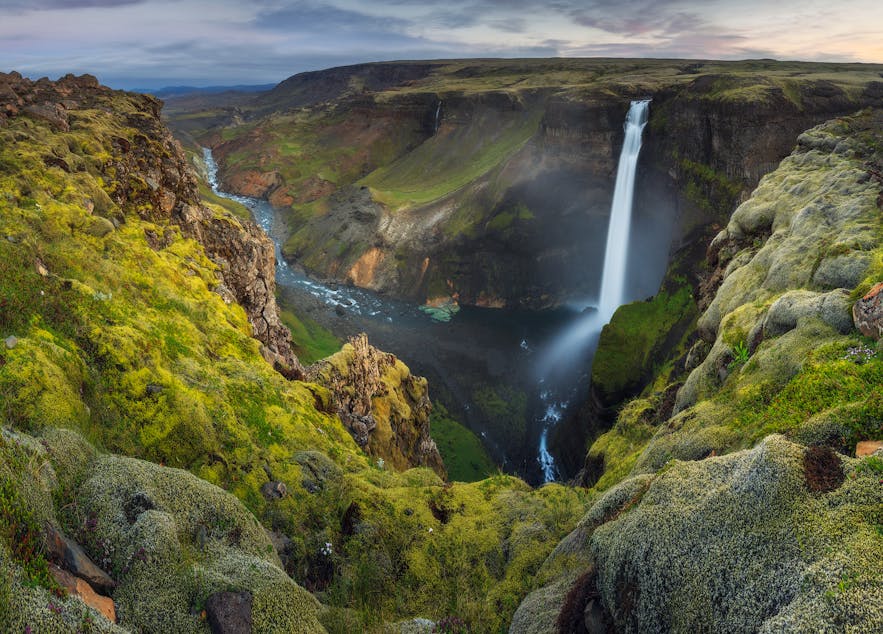
You may have heard that Iceland experiences a mixture of all four seasons in a day. Grey skies can suddenly give way to bright sunshine, followed by unforgiving rain that clears quickly to yield fabulous rainbows. But if you have the preconception that it’s all frozen and snowy, then you’ll be surprised to learn that there are actually distinct seasons in this country which make for diverse photographic opportunities. So what exactly is the best time to visit Iceland for photography?
- Join us on this 11 Day Iceland in Autumn Photography Workshop
- Learn these Recommended Camera Settings for Landscape Photography
Like most other places on Earth, the seasons in Iceland are marked by unmistakable changes in weather and ecology, as well as the amount or intensity of daylight. Variations in these factors may cause animals to migrate and plants to become dormant. They may even result in natural phenomena that are completely unique and which may only be seen during a particular window of time.
See our popular Autumn Photography Tours & Workshops in Iceland
5 day autumn photo workshop in iceland, 4 day autumn photo workshop in iceland, 9 day photo workshop capturing autumn in iceland.
Of course, changes in the seasons will affect what you'll be able to photograph. In fact, some of the most common questions that people ask us at Iceland Photo Tours is when and where to photograph things, such as puffins , waterfalls , ice caves , the Highlands and the Northern Lights . Put simply, photography in Iceland is heavily influenced by the seasons. So to make it easier for you to get through the seasons and prevent you from missing out on that one thing that you want to photograph, we’ve compiled a guide on where and when to shoot, meaning that you won’t have to waste your time relying so heavily on luck while you’re here!
- See also: 9 Best Places for Landscape Photography in Iceland
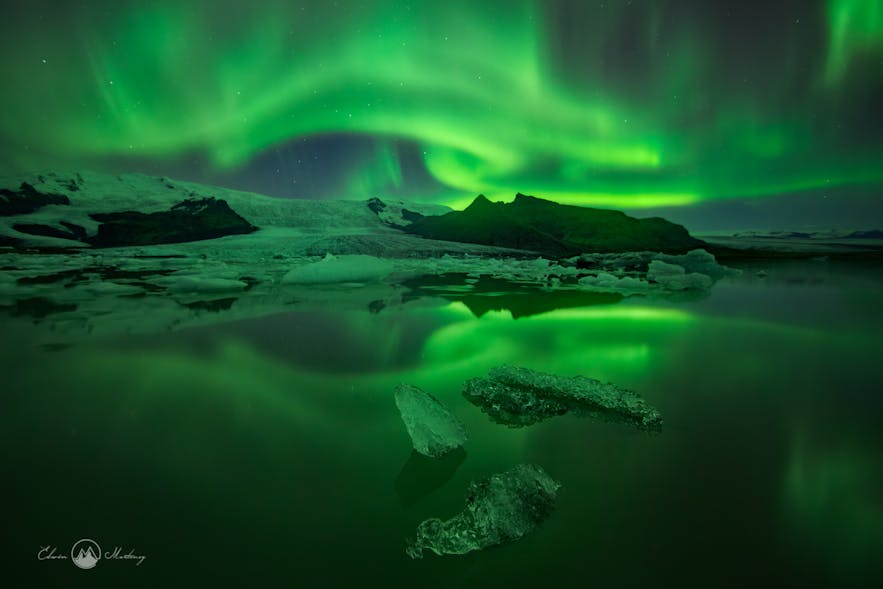
Other seasons in Iceland just don’t measure up to the incredible photographic opportunities that you’ll experience in winter . From snowy landscapes to enchanting displays of the Northern Lights, this season is sure to leave you completely spellbound.
Taking place from November until March, winter in Iceland equals shorter days with beautiful light. Be prepared to experience approximately 4-5 hours of daylight in mid-winter, slowly increasing as the season progresses. It won’t be the kind of light that you’re probably used to. The Arctic winter light in Iceland has a tranquil eeriness about it, creating the sense that you’re almost on another planet. Sunrises and sunsets may last for a couple of hours at a time, with the soft moodiness of the hues making these moments perfect for photography.
- See also: 8 Things to Know About Photographing Iceland in Winter
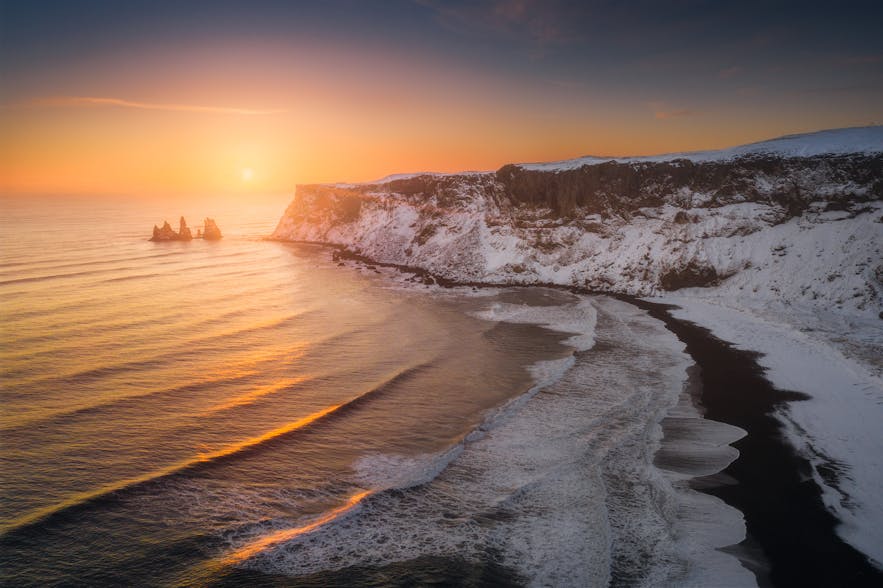
During winter in Iceland, you can usually expect a lot of snow, ice and stormy weather, interspersed with brief moments of clarity and crispness. Within the shortest timespan, a strong and windy snowstorm can turn to absolute sunshine.
However, snow and ice means that driving conditions are not at their best, so roads towards the Highlands , the East and the Westfjords may occasionally close. It may even be difficult for you to reach well-known photographic locations, such as Vík and the Snæfellsnes Peninsula , though if you can get there, then the opportunities to shoot will flow!
Every winter, new and amazing ice caves form in the Vatnajökull glacier in the south-east of Iceland. It is also the only season in the year when you will be able to visit and photograph them.
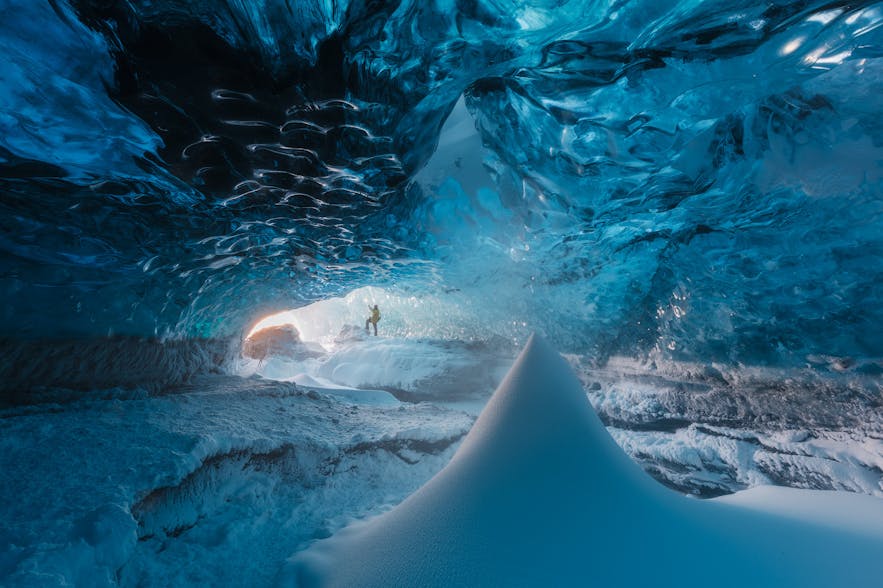
- See also: The Ultimate Guide to Photographing Ice Caves in Iceland
On the way to the ice caves, you can stop off for some wonderful photographic opportunities at the Jökulsárlón glacier lagoon , where large chunks of ice float about with the tide, as well as the nearby Breiðamerkursandur – more commonly known as the 'Diamond Ice Beach ' – where you will find ice cubes like polished diamonds scattered over the sandy black beach.
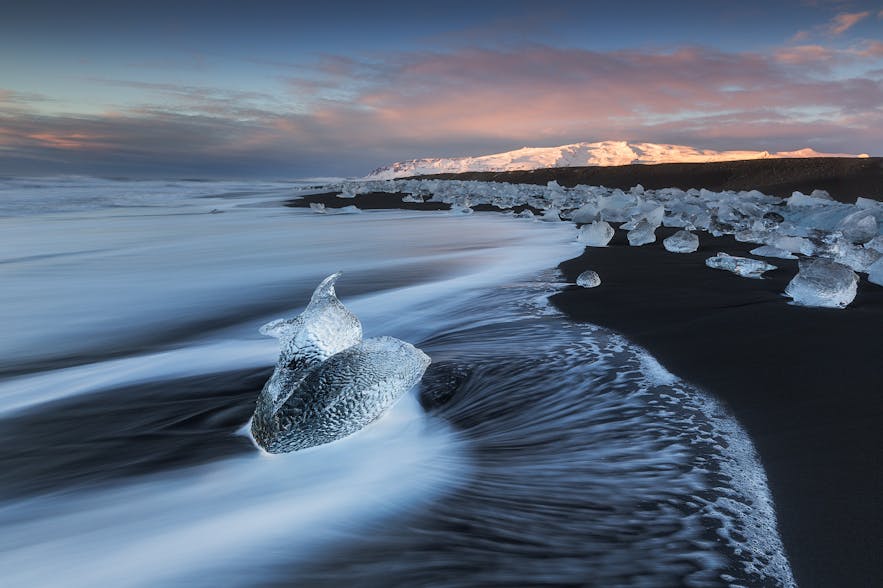
For a clear shot of the Northern Lights, Kirkjufell in the west of Iceland is always a sure bet. It’s also worth trying to capture them over the Jökulsárlón glacier lagoon, as well as Vestrahorn at Stokksnes in Iceland’s eastern region. Wherever you decide to go, the key to photographing the Northern Lights is to head out on a night with high forecast of Aurora activity, combined with clear skies or just a little cloud cover.
See our popular Winter Photography Tours & Workshops in Iceland
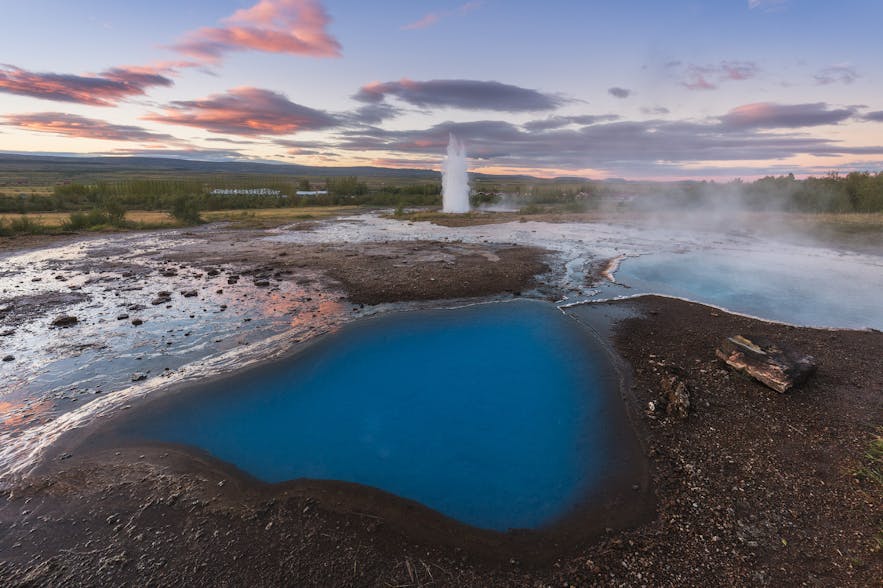
Ah… spring! Occurring during April and May in Iceland, this marvellous season is heralded by a myriad of sights, sounds and smells that will stimulate your senses. The rain brings with it a wholesome, leafy and muddy scent of mushrooms. Meanwhile, the wildlife begins to awaken. Spring is the lambing season, when sheep and their offspring are released by farmers to graze freely. Seabirds will also return to the island, so you may even spot a puffin or two at Dyrhólaey from early April onwards.
- See also: Wildlife Photography Guide | How to Shoot Great Pictures of Animals in Iceland
In Iceland, spring is the best time of year to photograph waterfalls , when the snow melts and the fresh water thunders into streams and rivers, bringing them back to life. Try your luck at Öxarárfoss, the magnificent waterfall that empties into the heart of the tectonic fault Almannagjá at Þingvellir in the south of Iceland. There are also a number of photographic opportunities at the Geysir geothermal area, with its hot springs and famous geyser, Strokkur.
- See also: Private Golden Circle Photo Tour with Kerid Crater Lake
Unfortunately, much of the Highlands will remain inaccessible during this season, as the snow continues to thaw slowly in the mountains. Also, be aware that as the days begin to get longer during spring in Iceland, you will have less of a chance to capture the Northern Lights. So if you really want to capture the ever-elusive Aurora Borealis, then spring is not the best of times to visit. However, the sunrises and sunsets will linger, so you will have plenty of time to set up your camera gear in order to capture that perfect shot.
- See also: Ultimate Guide to Sunrise Photography
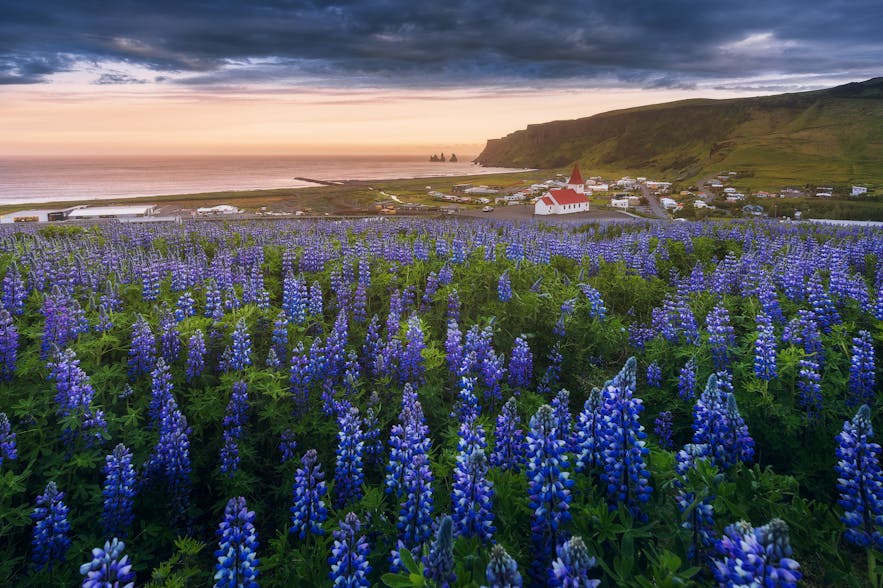
Summer in Iceland is a glorious time for photography! During this season, the island is swathed with the warmth and golden glow of the Midnight Sun – a phenomenon during which you will experience close to 24 hours of daylight. This is because the sun travels along the horizon and creates an extended sunset that eventually fades seamlessly into the sunrise. In Iceland, which is also known as the Land of the Midnight Sun, it is possible to have a sunset and sunrise that lasts for hours! So get your coffee ready and be prepared to immerse yourself in the true beauty of nature.
The summer season in Iceland begins in June and continues until August. During this time, you will witness sunsets that turn into sunrises with a spectacular show of colour lasting for hours. This season is an absolute paradise for photographers, as long days mean endless chances to photograph the landscape without the need to rush to reach a destination before it gets dark.
- See also: 12 Day Midnight Sun Photography Workshop around Iceland
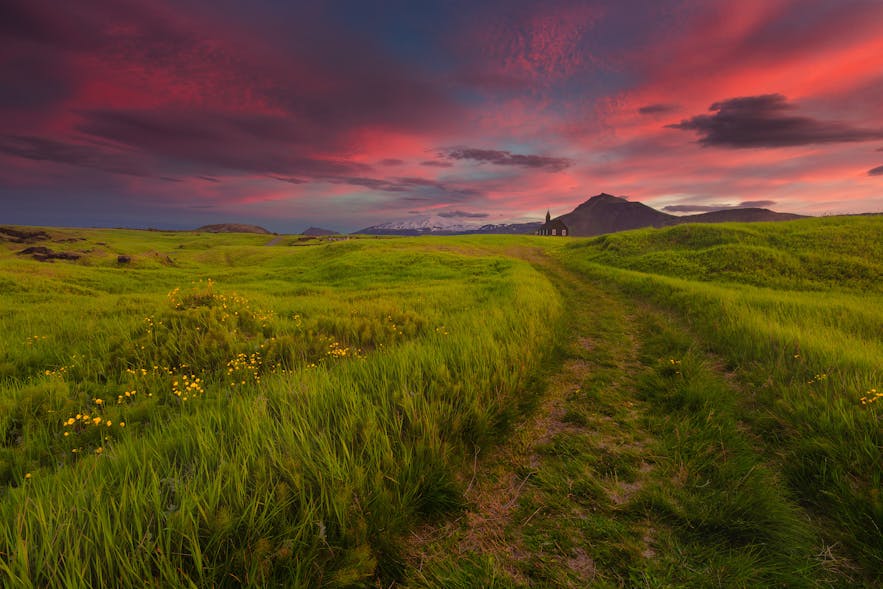
In the midst of summer, head towards the Snæfellsnes peninsula , where wildflowers will begin blooming and eventually spread like wildfire over the coastline . The Icelandic summer's endless array of wildflowers is one of the country’s most splendid sights and well-worth photographing. You can capture their beauty like a carpet at the foot of the black church of Búðir, or travel along the coastline to see lupines in full bloom from June through until July.
- See also: Why Iceland is the Perfect Place for Midnight Sun Photography
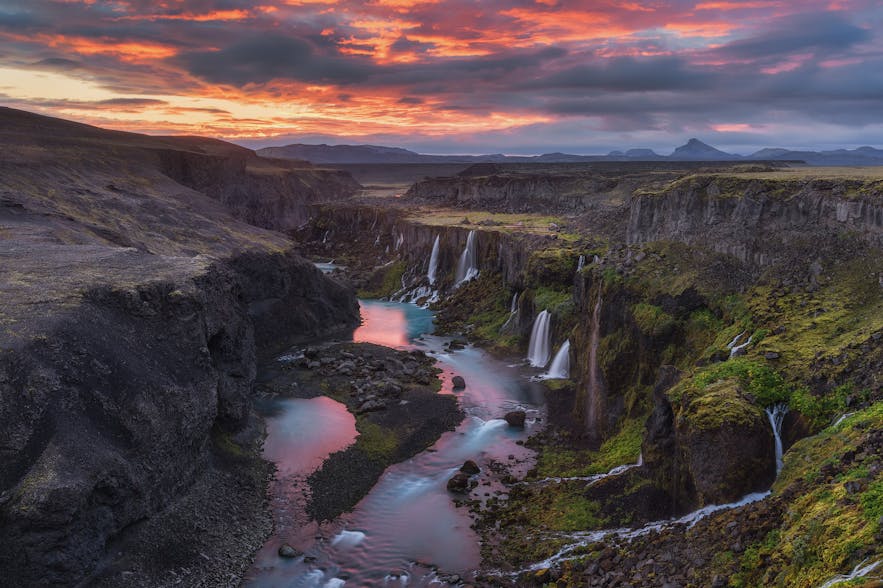
Towards the end of June, the roads towards the Highlands will begin to open, revealing dramatic photographic opportunities at the geothermal valleys at Landmannalaugar , Kerlingarfjöll and Hveravellir. It is also well-worth visiting areas in the north, such as Lake Mývatn, Hverarond and the uniquely-shaped Hvítserkur sea-stack for golden hour .
- See also: Where to Photograph Lupines and Wildflowers in Iceland
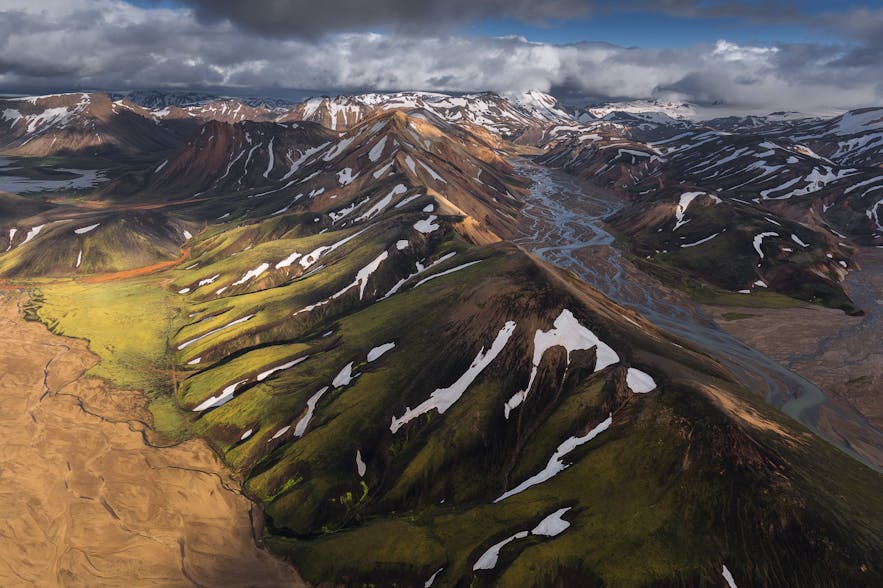
- See also: Landmannalaugar Photography Day Tour
Moreso, if you fancy getting off the beaten path, then this season is the best time to do it. Try venturing out towards the wonderful, remote wilderness of the Westfjords . Stick to the coast here and you will have a great chance to photograph puffins nesting on the sea cliffs at Látrabjarg.
See our popular Summer Photography Tours & Workshops in Iceland
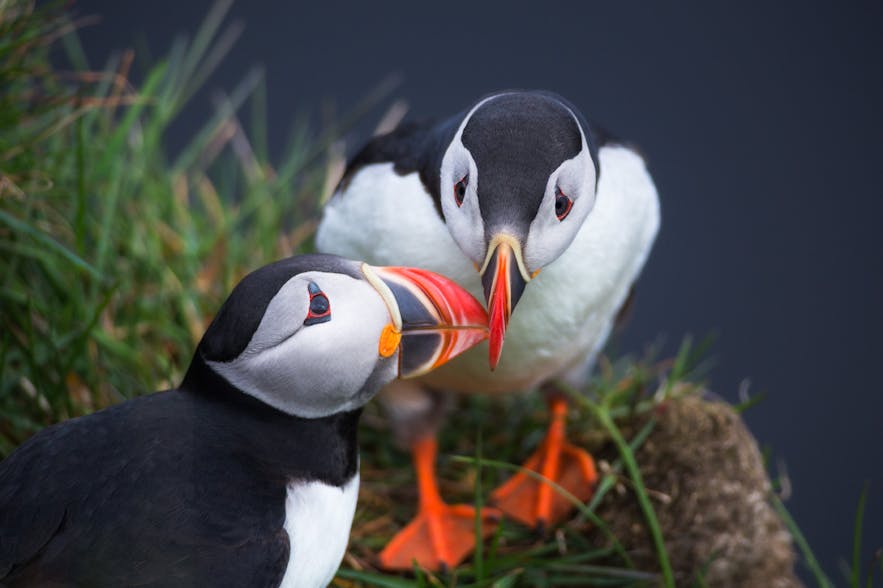
- See also: Complete Guide to Photographing Puffins in Iceland
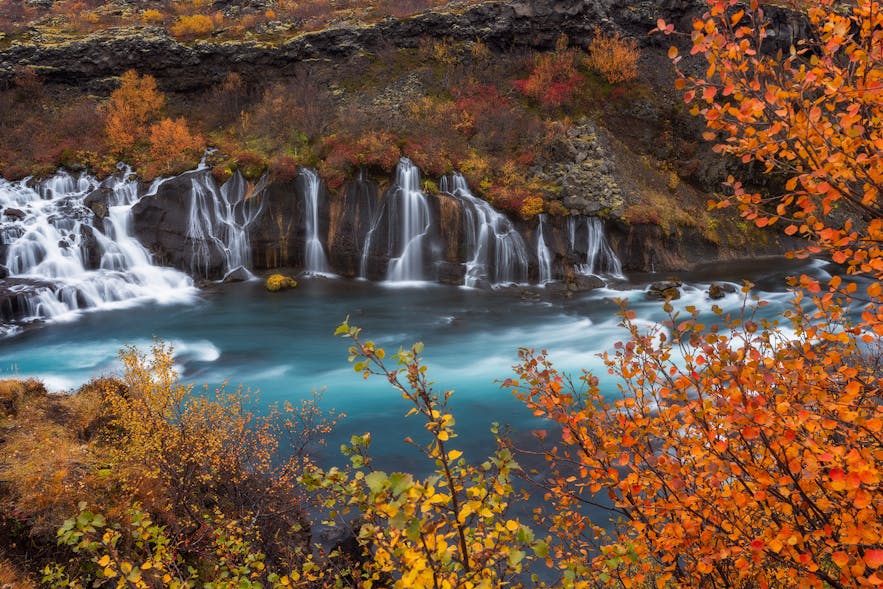
Last but not least, autumn is one of the most colourful times of the year in Iceland. It generally occurs between the months of September through to the start of November.
During this season of transitions, Iceland brims with gorgeous earthy hues of red, orange, yellow during fall. Birds chatter away as though it is spring and although the days start to become shorter, the sunlight remains warm. Sunrise is usually around 8am, with sunset happening at around 6:45pm in October. The first frost appears… you might even see a little snow at the beginning of September. Although the weather is unpredictable, it can feel wildly invigorating and exciting.
- See also: 11 Day Iceland in Autumn Photography Workshop
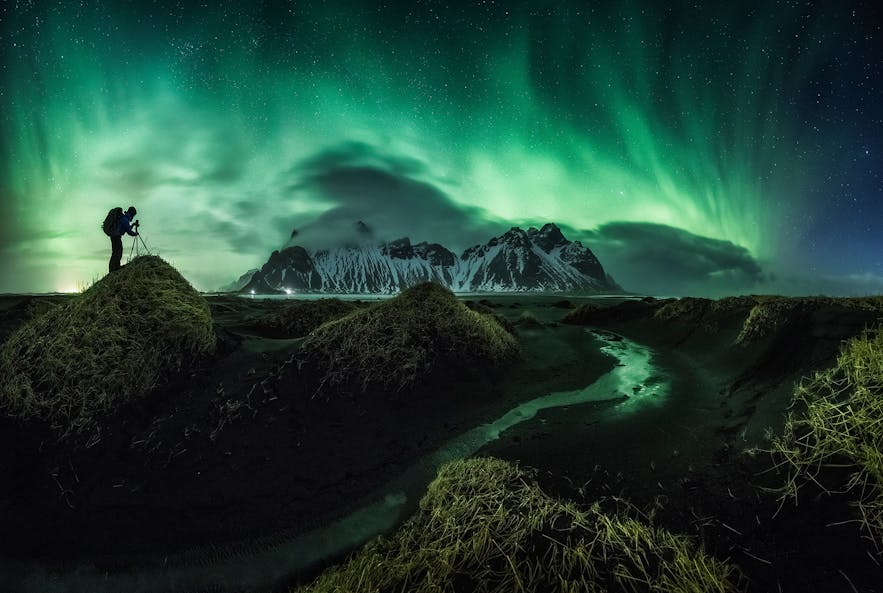
The truth of the matter is that photographing Iceland during autumn may be some of the most fun that you will ever have with your camera. Not only will there be an incredible range of colours blanketing the landscape, but you may even have the chance to capture the first shows of the Northern Lights.
Meanwhile, the lowering of the sun highlights the unique geology at Þingvellir, as well as the volcanically active area around Lake Mývatn. It is also worthwhile heading out to Skaftafell National Park for a truly magical experience.
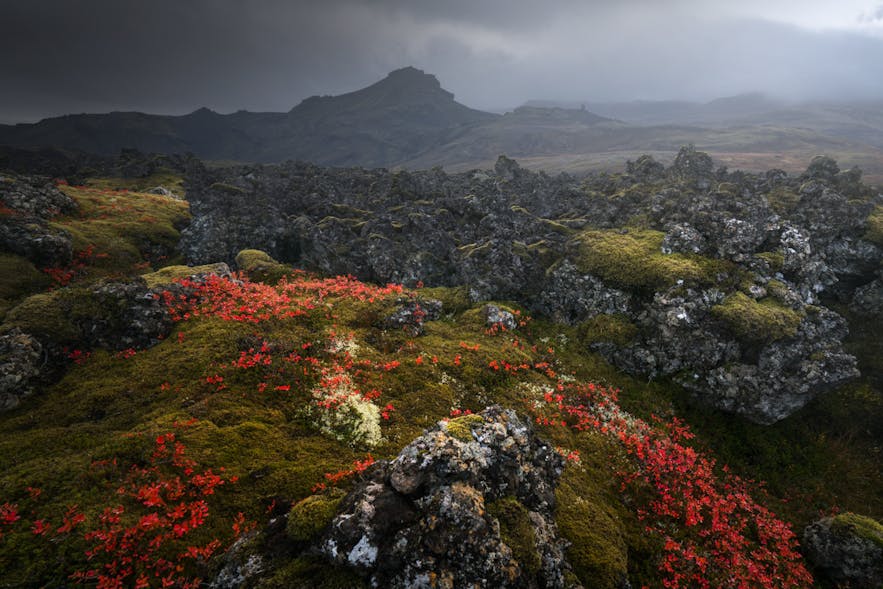
- See also: Two Week Circle of Iceland Photo Workshop in Autumn
As always in Iceland, be prepared for wind – too much can mean that the leaves are completely blown away from the bushes, meaning very little for you to photograph in the landscape besides branches!
It’s also important to be aware that as autumn progresses, the roads to the Highlands will begin to close and some tours to the glaciers will stop running, so you might miss out on the chance to photograph these.
Sea birds such as puffins will also begin to leave Iceland during this season, migrating towards warmer climates. Another thing that you might be interested to know is that autumn is the season for sheep and horse roundups (known as ‘réttir’), when farmers hike up the remote valleys to gather all of their animals and return them to their farms for winter. So if you’re around in Iceland during autumn, then it may be your final chance to photograph puffins, sheep and Icelandic horses for the year!
About the author: Serena Dzenis is a landscape photographer based in Iceland. You can find more of her work on her website or by following her on Facebook and Instagram .
Are you ready to explore Iceland? Find out more about the incredible range of photography workshops and tours in Iceland that we have on offer!
Popular articles
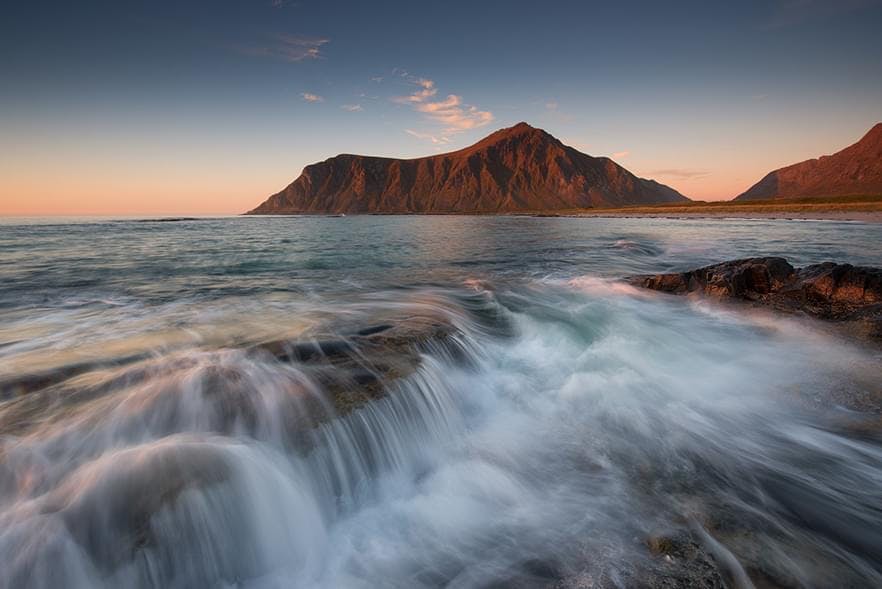
Landscape Photography in the Lofoten Islands of Norway
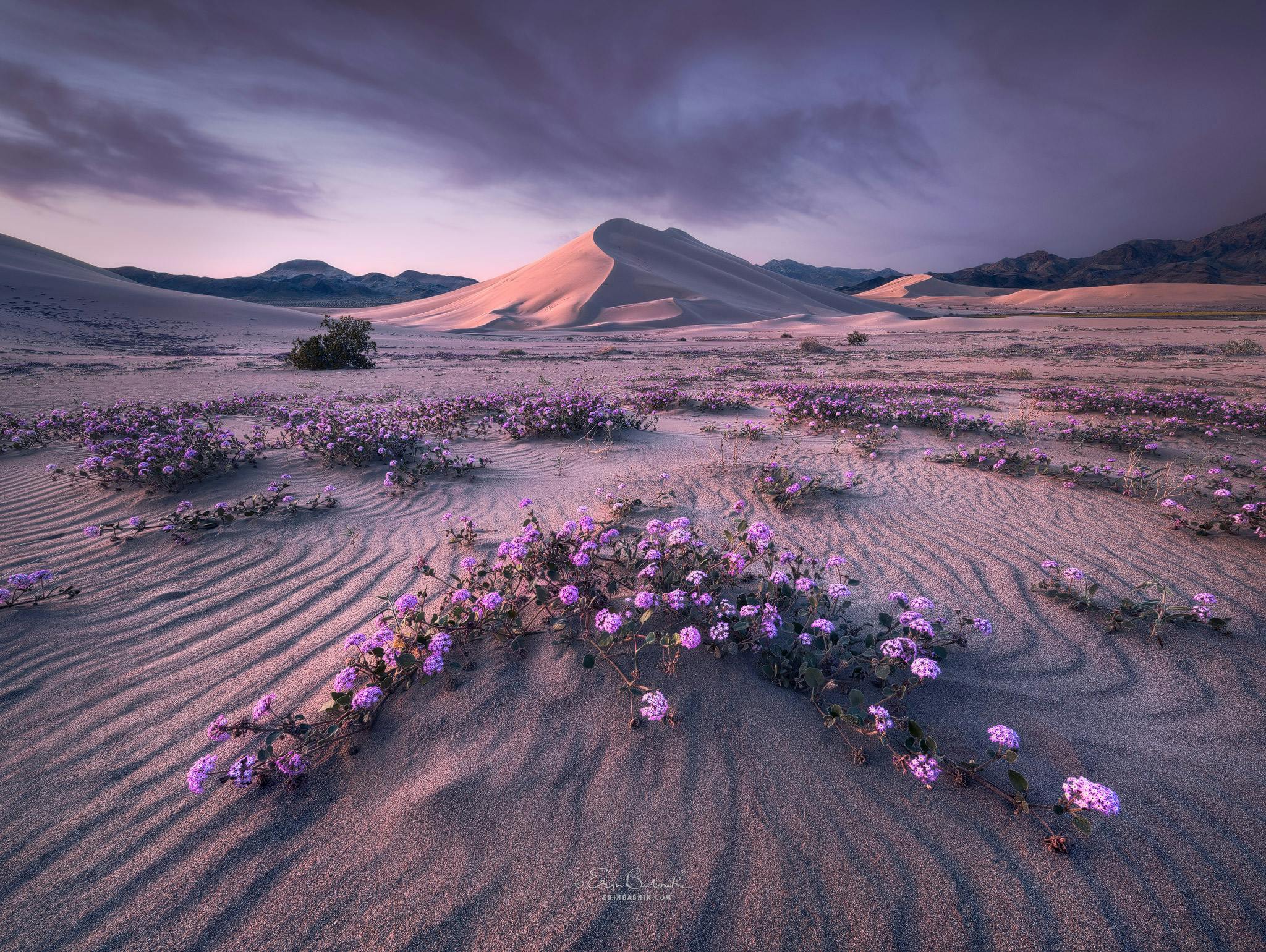
Interview with Erin Babnik

The Best Places to Photograph Puffins in Iceland
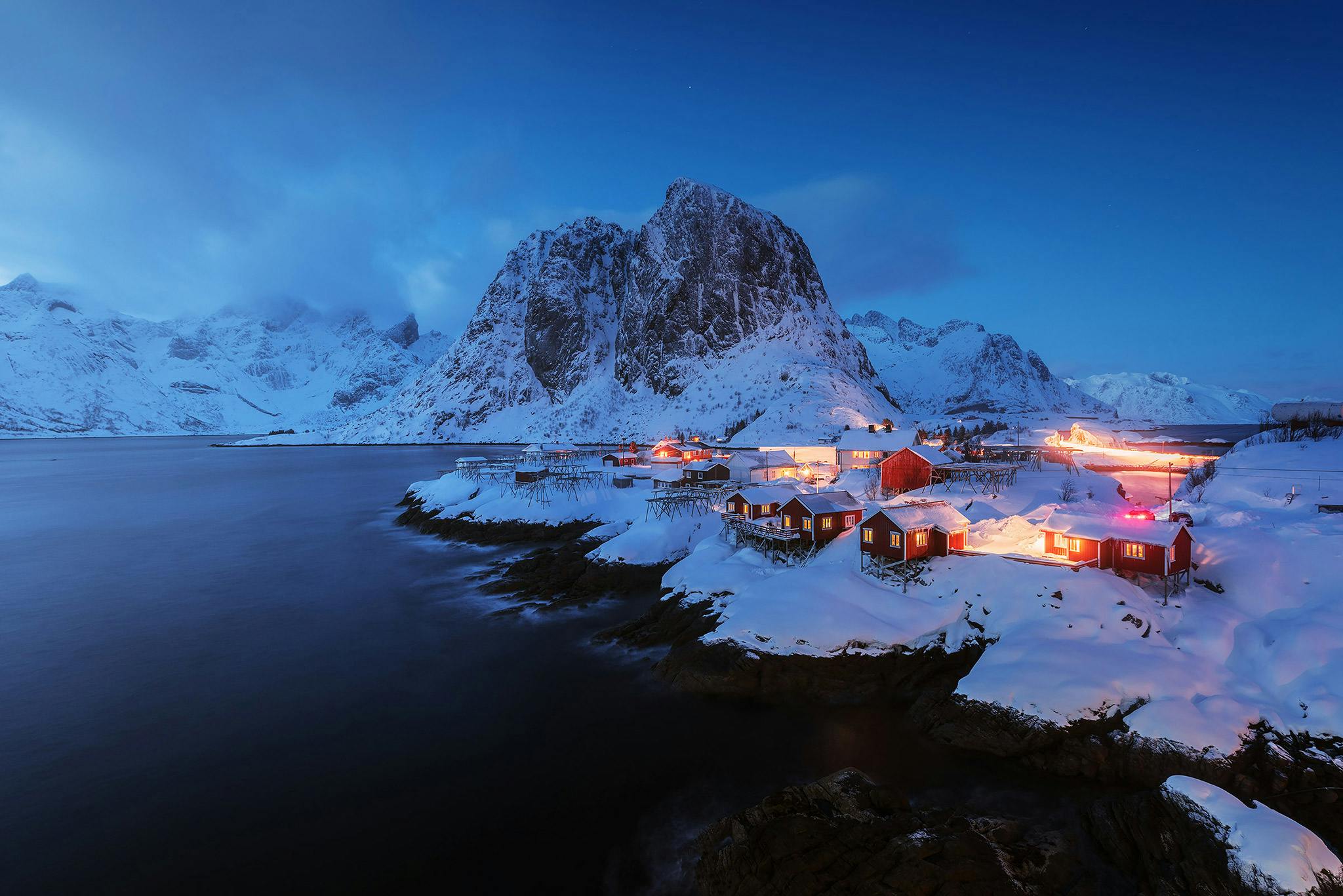
Ultimate Photography Guide to the Lofoten Islands of Norway
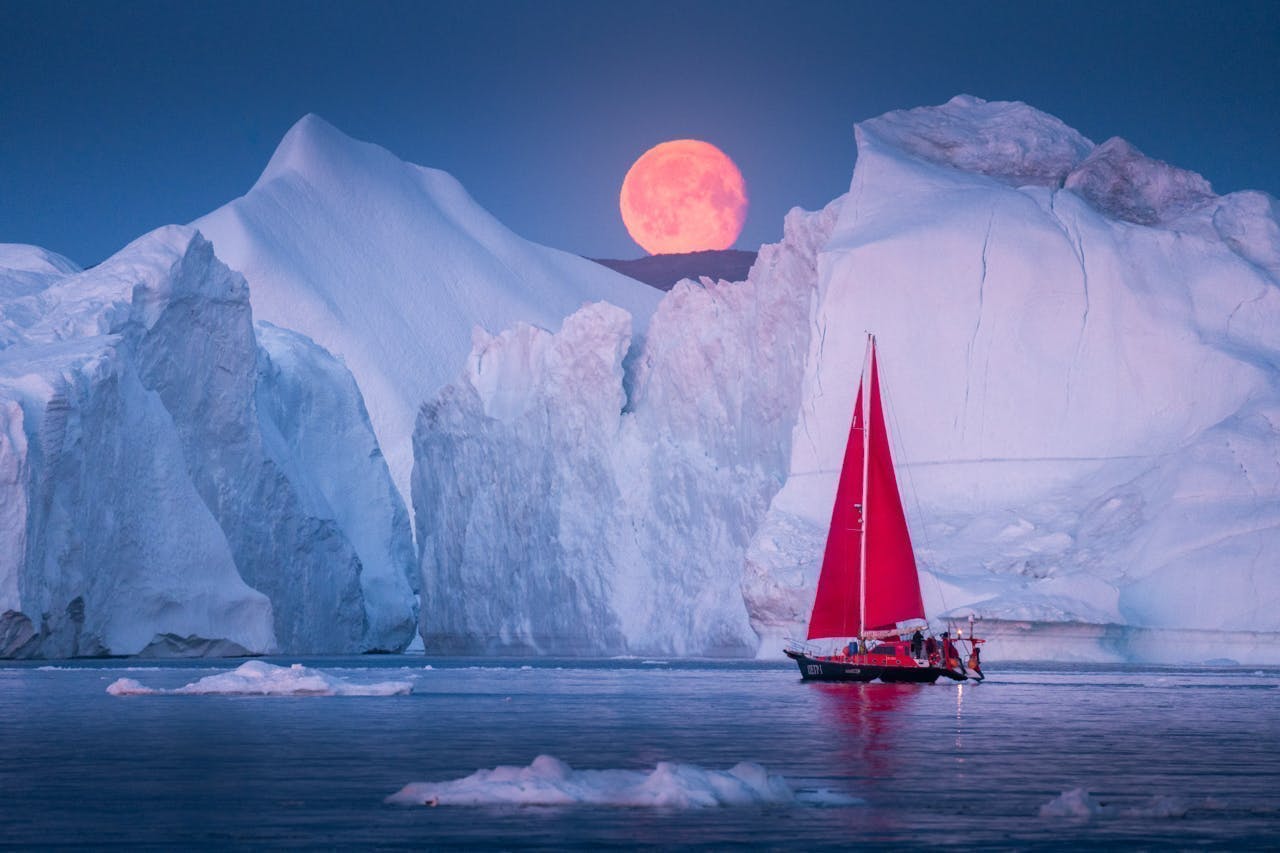
Ultimate Guide to Landscape Photography
Other interesting articles.

15 Places in the World That Every Landscape Photographer Has to Visit
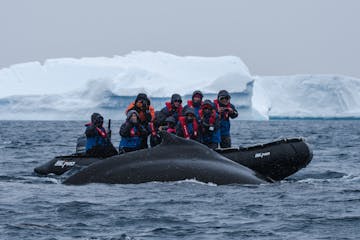
An Unforgettable Trip to Antarctica With Iceland Photo Tours

Ultimate Guide to Desert Photography
Popular photo tours & workshops.
Travel the world to capture the most incredible landscapes
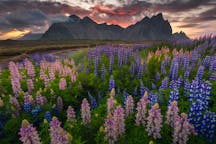
Summer Photo Tours in Iceland
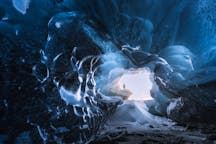
Winter Photo Tours in Iceland

International Photo Tours
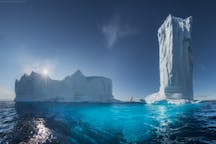
Greenland Photo Tours

Private Photo Tours in Iceland
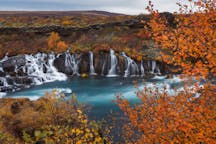
Autumn Photo Tours in Iceland
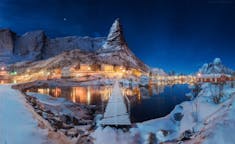
Norway Photo Tours and Workshops
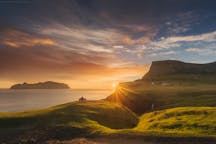
Faroe Islands Photo Tours and Workshops

IMAGES
VIDEO
COMMENTS
Now, if you are interested in heat rather than warmth, July might be a better time to visit Iceland. It is the best time of year to visit Iceland for heat, as the hottest month of the year. It is also the least windy month. The weather in Iceland in July is generally extremely pleasant during this time of the year. While the nights are a little ...
June to August is the best time for outdoor recreation. While there's no good weather guarantee, this is your best chance of sun and warmish temperatures. Late June to early August is when most Icelanders go on vacation, filling up campgrounds wherever the best weather is forecast. This is the height of the tourist season - and height of ...
Things to consider if planning a trip to Iceland in 2023 (in theory, but check the latest decisions for large gathering due to the virus): 3rd to 6th February - Reykjavik Winter Lights Festival. Late March - Iceland Winter Games (maybe) June - Reykjavik Arts Festival. June 17 - Icelandic National Day.
When humans first arrived some 1100 years ago, Iceland seemed desolate: a layover for migrating birds, roamed only by the Arctic fox, the sole native land mammal. But expand the horizon through the wild hills, cliffs and glaciers to the ocean and offshore islands, and a visit to Iceland can tick some serious wildlife-spotting boxes.
The best time to visit Iceland is during the summer, when the terrain is passable even in the more remote areas of the country. Iceland is located close to the Arctic, but the effect of the Gulf Stream means that it has a milder climate than many other places at the same latitude. Even with that mild climate, winters can be harsh, but summers ...
Yes, there are sharks in Iceland, but not Great Whites like you might be thinking of! The most commonly spotted shark around Iceland is the Greenland shark, which can reach up to 7 meters (23 feet) in length. Despite their impressive size, these sharks aren't usually dangerous to humans and won't attack unless provoked.
Avoiding the Crowds. Best Months: October-April. Iceland in winter, when the weather is cooperating, can give you thrilling opportunities to visit extremely popular places like the Dyrhólaey Peninsula and the Dettifoss waterfall without the crowds. As an added benefit, the car rental and hotel prices drop in some regions.
Deciding on the best time to visit Iceland hinges on what you're looking for in this mesmerizing land of contrasts. Each season reveals a different facet of its beauty, from the verdant summers illuminated by the Midnight Sun to the cosy winters under the Northern Lights. ... For wildlife enthusiasts, Iceland presents an array of ...
August is one of the best times to visit Iceland. It is the warmest time of the year to travel the Arctic Circle, and summer temperatures average around 15°C. Days are similar to most of the Northern Hemisphere, with the sun rising between 5 a.m. and 6 a.m. and setting between 9 and 10 a.m.
The Summer in Iceland. The summer months of June, July, and August make up Iceland's peak travel season; this is the country's busiest time for tourism. The weather is the most pleasant in the summer, with the highest temperatures, mostly sunny and bright days, and the least chance of wind, rain, and storms.
Fin whales are the second largest animals on Earth, behind only the aforementioned blue whales. On average, they have a size of 65 feet (20 meters) and weigh 40-50 tons. They are more commonly seen around Iceland than the blue whale, with an estimated 30,000 to 40,000 individuals living in the North Atlantic Ocean.
Summer is the most popular time to travel to Iceland. Beginning in June, tourism numbers increase exponentially, so expect larger crowds. Many believe this is the best time to visit Iceland, especially if your Iceland trip means hitting the hiking trails. Peak summer is around July. The warmest months of the year bring some of the best weather ...
The best time to visit Iceland is between September and March to see the northern lights, or between June and August for summer activities. While travel to Iceland may depend on your desired itinerary, generally, the best time to visit is during the summer. During this time, you'll experience warmer temperatures and long days of sunlight ...
Best times to visit Iceland for good weather. The ideal time for favorable weather in Icelandis the summer season, extending from late June to September. Temperatures during this time range from 12°C-20°C, and the sunny setting in Reykjavikis a delight to experience.
In late June, some areas enjoy up to 23 hours of daylight, providing ample opportunity to explore. Evening road trips are ideal for visiting renowned attractions like waterfalls, geysers, and volcanic formations, including impressive lava tubes, helping you avoid the daytime crowds from cruise ships. Summer is also the best time for whale watching.
High Season (June-August) is the best time for outdoor activities. In line with the rest of Iceland, the summer months are when the Westfjords opens up for outdoor pursuits: hiking, mountain biking, sea kayaking, wildlife spotting and more. All the major mountain passes and cross-fjord ferry routes linking the valleys of the Westfjords are ...
Iceland in June: Weather and Wildlife. Iceland's average temperature in June is just below 50 F. The month has the least amount of rain and is the time of the midnight sun. From the 16th to the 29th, the sun sets after midnight and the 21st of the month is the longest day of the year with only a few hours of darkness.
In conclusion, the best time to visit Iceland depends on your personal preferences and interests. If you want to experience the stunning Northern Lights, the best time to visit is during the winter months when the nights are longer. For wildlife enthusiasts, the summer months offer the best opportunity to spot unique Icelandic wildlife.
September is not the best time to visit Iceland for wildlife viewing. On the plus side we saw seals on multiple occasions (at Ytri Tunga beach on the Snæfellsnes Peninsula and in the Westfjords), an Arctic fox at Látrabjarg cliffs (a rare sight!), and many horses and sheep. But it's the wrong time of year for many animals.
Puffins at Iceland's Látrarbjarg Cliffs. The best month to go to Iceland for wildlife enthusiasts depends on the specific species you're hoping to encounter. Whale Watching. The prime time ...
The best time to visit Iceland is anytime. Read about the best time of year to travel to Iceland for Northern Lights, wildlife and hot springs. ... Best Time to Travel to Iceland for Wildlife. Iceland is a dream for ornithologists and photographers. There are rainbow-beaked puffins nesting on sea cliffs and fascinating skuas, kittiwakes and ...
Ultimately, the "best" time to visit Iceland for wildlife depends on your personal preferences. Spring offers a fresh start, summer a vibrant explosion of life, autumn a serene contemplation, and winter a mystical interlude. So, listen to the call of the wild, choose your symphony, and get ready to be enchanted by Iceland's untamed beauty.
Taking place from November until March, winter in Iceland equals shorter days with beautiful light. Be prepared to experience approximately 4-5 hours of daylight in mid-winter, slowly increasing as the season progresses. It won't be the kind of light that you're probably used to.